Dimitrios Konidaris's Blog, page 7
June 27, 2022
BRONZE AGE FRAGMENTAL PIECES OF EVIDENCE IN HOMER ..
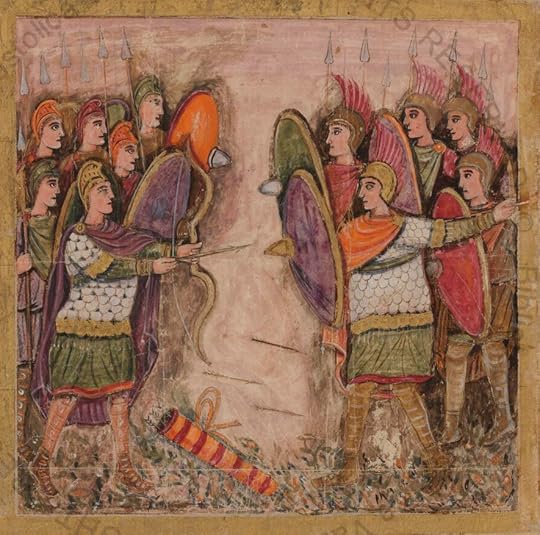 War of Troy, from Vergilius Romanus
War of Troy, from Vergilius RomanusÎεÏÏείÏαι[0] ÏÎ¿Î»Ï ÏιθανÏν ÏÏι η Îλιάδα και η ÎδÏÏÏεια ÏÏ Î½ÎµÏÎθηÏαν ÏÏοÏοÏικά ÏÏοκειμÎÎ½Î¿Ï Î½Î± άδονÏαι ενÏÏιον Ïοι ÎºÎ¿Î¹Î½Î¿Ï ÎºÎ±Î¹, με βάÏη Î±Ï Ïήν Ïην ÏαÏάÏÏαÏη, καÏαγÏάÏηκαν με Ï ÏαγÏÏÎµÏ Ïη καÏά Ïο δεÏÏεÏο ήμιÏÏ ÏÎ¿Ï 8Î¿Ï Î±Î¹. Ï.Χ. ΣÏμÏÏνα με οÏιÏμÎÎ½Î¿Ï Ï Î±ÏÏÎ±Î¯Î¿Ï Ï ÏÏ Î³Î³ÏαÏείÏ, οι ΠειÏιÏÏÏαδίδεÏ, ÏÏÏαννοι ÏÎ·Ï ÎθήναÏ, ÏÎ¿Ï ÎºÏ Î²ÎÏνηÏαν Ïην ÏÏλη αÏÏ Ïο 560 ÎÏÏ Ïο 510 Ï.Χ., ÎÏαιξαν ÏημανÏÎ¹ÎºÏ ÏÏλο ÏÏον καθοÏιÏÎ¼Ï ÏÎ·Ï Î¿ÏγανÏÏεÏÏ ÏÏν βιβλίÏν Ïε κάθε ÎÏοÏ. ΣÏην ÏÏαγμαÏικÏÏηÏα, Ïο ÏÏνολο ÏÏν ÎºÏ Î»Î¯Î½Î´ÏÏν ÏÎ¿Ï ÏαÏήÏθηÏαν καÏά Ïη βαÏιλεία ÏÎ¿Ï Ï Î±ÏεÏÎλεÏε Ïην βάÏη γιά Ïην ÏαÏάδοÏη ÏειÏογÏάÏÏν ÏÎ¿Ï Î®Ïαν γνÏÏÏή ÏÏÎ¿Ï Ï ÎλεξανδÏινοÏÏ Î¼ÎµÎ»ÎµÏηÏÎÏ Î±ÏÏ Ïον ÏÏίÏο αιÏνα Ï.Χ. και μεÏά. ÎÎ½Ï Î¿Î¹ ÏÏ Î³Î³ÏαÏÎµÎ¯Ï ÏÎ¿Ï ÏÎμÏÏÎ¿Ï Î±Î¹Ïνα αναÏÎÏÎ¿Ï Î½ Ïα ÎμηÏικά ÏοιήμαÏα ÏÏ Î®Î´Î· καθιεÏÏμÎνα ÎÏγα, Ïα ÏαλαιÏÏεÏα ÏÏζÏμενα θÏαÏÏμαÏα ÏÏν ÏοιημάÏÏν ÏÎ¿Ï Î±Î½Î±ÎºÎ±Î»ÏÏθηκαν ÏÏην ÎÎ¯Î³Ï ÏÏο ÏÏονολογοÏνÏαι αÏÏ Ïον ÏÏίÏο αιÏνα Ï.Χ. Îενικά, ο αÏιθμÏÏ ÏÏν ÎμηÏικÏν ÏαÏÏÏÏν είναι ενÏÏ ÏÏÏιακÏÏ, εÏιβεβαιÏνονÏÎ±Ï Ïην ÏÏ Î½ÏÏιÏÏική ÏαÏÎ¿Ï Ïία ÏÏν ÏοιημάÏÏν ÏÏην εκÏÎ±Î¯Î´ÎµÏ Ïη και Ïη λογοÏεÏνική ÎºÎ¿Ï Î»ÏοÏÏα ÏÎ¿Ï Î±ÏÏÎ±Î¯Î¿Ï ÎºÏÏÎ¼Î¿Ï . ÎÏιÏλÎον, ο ÎμηÏÎ¿Ï ÏÏ Ïνά ξεÏεÏνοÏÏε Ïα ÏÏια ÏÎ·Ï ÏÏ Î¼Î²Î±ÏÎ¹ÎºÎ®Ï ÎµÎºÏαιδεÏÏεÏÏ Î³Î¹Î± να ειÏÎλθει ÏÏο βαÏίλειο ÏÎ·Ï ÎºÎ±Î¸Î·Î¼ÎµÏÎ¹Î½Î®Ï Î¶ÏήÏ, ÏÏÏÏ ÏÏο ÏαÏÎ¹Î´Î¹ÎºÏ ÎµÎ³ÏειÏίδιο ÏελεÏÎ¿Ï ÏγικÏν ξοÏκιÏν για ιαÏÏικά ÏÏοβλήμαÏα ÏÎ¿Ï ÏεÏιγÏάÏονÏαι ÏαÏακάÏÏ, ÏÏÎ¿Ï Î¼ÎµÏικÎÏ Î³ÏαμμÎÏ Î±ÏÏ Ïην Îλιάδα Îμειναν αμεÏάÏÏαÏÏεÏ. ÎÏÏÏ Î¼Î¬Î»Î¹ÏÏα ο αναγνÏÏÏÎ·Ï Î½Î± γνÏÏιÏε μια ιδιαίÏεÏη θεÏαÏεία ÏÏοÏÎÏονÏÎ±Ï Ïα ελληνικά ÏÏο ÏÏÏÏÏÏÏ Ïο.ÎαÏÎ¬Î»Î¿Î³Î¿Ï ÏÏν νηÏν & αÏάλανÏοÏΣε άÏθÏο ÏÎ¿Ï Î¿ Calverts Watkins εÏιÏειÏεί να ÏÏÏίÏει γλÏÏÏολογικά και αÏÏαιολογικά οÏιÏμÎÎ½Î¿Ï Ï ÎμηÏικοÏÏ ÏÏÏÎ¿Ï Ï.[1] ÎναÏεÏÏÎ¼ÎµÎ½Î¿Ï Î»Î¿Î¹ÏÏν ÏÏο αÏÏÏÏαÏμα ÏÎ¿Ï ÎαÏαλÏÎ³Î¿Ï ÏÏν ÎηÏν Ïο ÏÏεÏÎ¹ÎºÏ Î¼Îµ Ïην ÎÏήÏη, Il.2.654-651, διαÏιÏÏÏνει αÏÏικά ÏÏι η ÏÏάÏη ÏÎ¿Ï ÏεÏιγÏάÏει Ïον ÎηÏιÏνη ÏÏÎÏει για γλÏÏÏικοÏÏ Î»ÏÎ³Î¿Ï Ï Î½Î± ÏÏονολογείÏαι Ïο αÏγÏÏεÏο μÎÏÏι Ïην ΥΠIIIa. Το αÏÏαÏÎºÏ ÎµÏίθεÏο á¼ÏάλανÏοÏ[2] αναÏÎÏεÏαι ÏÏ ÏεÏαιÏÎÏÏ Î±ÏÏδειξη ÏÎ·Ï ÏÏÏÎ¹Î¼Î·Ï ÏÏÎ¿Î½Î¿Î»Î¿Î³Î¯Î±Ï ÏÎ¿Ï Î±ÏοÏÏάÏμαÏοÏ: ÏÏοÏανÏÏ Î¿Î¹ Î¶Ï Î³Î¿Î¯ ÏÏηÏιμοÏοιήθηκαν μÏνον ÏÏ ÏαÏικά ανÏικείμενα για μια ÏÏνÏομη ÏεÏίοδο ÏÏÎ¿Ï Ï Î ÏÏÎ¹Î¼Î¿Ï Ï ÎÏ ÎºÎ·Î½Î±ÏκοÏÏ ÏÏÏÎ½Î¿Ï Ï, ÏÏιν αÏÏ Ïο 1400 Ï.Χ. ÎεβαίÏÏ Î¿Î¹ Î¶Ï Î³Î¿Î¯ ÏεÏιλαμβάνονÏαι μεÏÎ±Î¾Ï ÏÏν ÏÏ Î»Î»Î±Î²Î¿Î³ÏαμμάÏÏν αμÏοÏÎÏÏν ÏÏν ÎÏαμμικÏν ÎÏαÏÏν. ΣÏο ίδιο αÏÏÏÏαÏμα αÏÏ Ïην Îλιάδα, ÏÏÏον η ÎνÏÏÏÏ ÏÏο και η ÎÏÏÏÏ Î½Î± αναÏÎÏονÏαι ÏÏ Î±Î½Î®ÎºÎ¿Ï ÏÎµÏ ÏÏην ηγεμονία ÏÎ¿Ï ÎδομενÎÏÏ. ÎεδομÎÎ½Î¿Ï ÏÏι ο αÏÏαιÏÏεÏÎ¿Ï Î¿Î¹ÎºÎ¹ÏμÏÏ ÏÎ·Ï ÎÏÏÏÏ Î½Î¿Ï ÏÏονολογείÏαι ÏÏην ΥΠIIIb2, οι δÏο ÏÏÎ»ÎµÎ¹Ï Î¸Î± μÏοÏοÏÏαν να Ï ÏάÏÏÎ¿Ï Î½ ÏÎ±Ï ÏÏÏÏονα μÏνο εάν γίνει δεκÏή η ÏÏιμη ημεÏομηνία ÏÏονολογήÏεÏÏ ÏÎ¿Ï Palmer για Ïην καÏαÏÏÏοÏή ÏÎ·Ï ÎνÏÏοÏ, ήÏοι η ΥΠIIIb, ÏεÏί Ïο 1225 Ï.Χ.
ΠμικÏογÏαÏική ζÏÏÏÏÎ¿Ï ÏÎ·Ï ÎήÏÎ±Ï ÎºÎ±Î¹ η εÏική ÏοίηÏη ÏÎ·Ï ÎÏοÏÎ®Ï ÏÎ¿Ï Î§Î±Î»ÎºÎ¿Ï[4]AÏÏ Ïην Î±Î½Î±ÎºÎ¬Î»Ï Ïή ÏÎ¿Ï Ï Ïο 1972 οι μικÏογÏαÏικÎÏ ÏοιÏογÏαÏÎ¯ÎµÏ ÏÎ·Ï ÎÏ ÏÎ¹ÎºÎ®Ï ÎÎ¹ÎºÎ¯Î±Ï ÏÎ¿Ï ÎκÏÏÏηÏÎ¯Î¿Ï ÎÏÎ¿Ï Î½ ÏÏαβήξει Ïο ενδιαÏÎÏον ÏÎ·Ï ÎµÏιÏÏÎ·Î¼Î¿Î½Î¹ÎºÎ®Ï ÎºÎ¿Î¹Î½ÏÏηÏÎ¿Ï ÎµÎ½ÏÏÏ ÏÏν οÏίÏν ÏÏν ÏÏ Î³ÏÏονικÏν και ÏεÏνικÏν μελεÏÏν ÏÏν αÏÏαιολÏγÏν ÏÎ¿Ï ÎινÏÎ¹ÎºÎ¿Ï ÏολιÏιÏμοÏ. Îι μελεÏηÏÎÏ ÏÎ·Ï ÏÏοÏÏÏοÏÎ¯Î±Ï ÎÏÎ¿Ï Î½ αÏκήÏει Ïην ειδικÏÏηÏά ÏÎ¿Ï Ï ÎµÏί ÏÏν ÏοιÏογÏαÏιÏν, ÎÏÎ¿Ï Î½ Ï ÏοÏÏηÏίξει Ïην Îιγαιακή ÏεÏιοÏή ενδιαÏÎÏονÏÏÏ ÏÎ¿Ï Ï ÎºÎ±Ïά ÏÏοβλÎÏιμο ÏÏÏÏο και ÎÏÎ¿Ï Î½ διεÏÎµÏ Î½Î®Ïει μοÏÏολογικÎÏ ÏÎ»ÎµÏ ÏÎÏ ÏÎ¿Ï ÏÏÎ¿Ï Ï ÎºÎ±Î¹ ÏÎ¿Ï Î¸ÎμαÏοÏ. ΠμελÎÏη αÏÏ Ïην εÏιÏÏημονική κοινÏÏηÏα ÎÏει ÏαÏαμείνει ÏιÏÏή ÏÏÎ¹Ï ÏαλαιÏÏεÏÎµÏ ÎµÏμηνείεÏ, ÏαÏά Ïα νÎα ÏÏοιÏεία εκÏÏÏ ÎήÏÎ±Ï ÎºÎ±Î¸ÏÏ ÎºÎ±Î¹ ÏÎ¹Ï Î½ÎÎµÏ Î±ÏÏÏÎµÎ¹Ï ÏÎ¹Ï ÏÏεÏικÎÏ Î¼Îµ Ïην ÎÏοÏή ÏÎ¿Ï Î§Î±Î»ÎºÎ¿Ï. ÎÏ ÏÏ ÏÎ¿Ï ÎÏει Ïαθεί είναι η ενÏÏηÏα και η ÎµÏ ÏÏÏεÏη ÏημαÏία â ÏÏÎ¿Ï Î´Î±Î¹ÏÏηÏα Î±Ï ÏÏν ÏÏν ÏοιÏογÏαÏιÏν. Î ÏÏÏÏαÏÏική Ïηγή ÏÎ¿Ï Ï ÎµÎ¯Î½Î±Î¹ ÎÎ½Î±Ï ÎµÏικÏÏ Î® ηÏÏικÏÏ Î¼ÎµÏαÏÏημαÏιÏμÏÏ ÏÎ·Ï Î¹ÏÏοÏÎ¹ÎºÎ®Ï ÎµÎ¼ÏειÏÎ¯Î±Ï Î¿ οÏÎ¿Î¯Î¿Ï ÏÏ Î½ÎµÏάγεÏαι / Ï ÏαινίÏÏεÏαι} Ïην ÏÎ±Ï ÏÏÏÏονη ÏÏαÏξη ÏοιήÏεÏÏ. Îία ÏÏγκÏιÏη ÏÏν οÏÏικÏν εικÏνÏν με ÏοιηÏικά θÎμαÏα, ÏÏεÏεÏÏÏ Ïα και εÏειÏÏδια καθιÏÏά ÏÎ¹Ï Î¼Î¹ÎºÏογÏαÏικÎÏ ÏοιÏογÏαÏÎ¯ÎµÏ Îνα ÏÏÏιμο και ÏημανÏÎ¹ÎºÏ ÏεκμήÏιο για Ïην ÏÏοÏÏÏοÏία ÏÎ·Ï ÎÎ»Î»Î·Î½Î¹ÎºÎ®Ï ÎµÏÎ¹ÎºÎ®Ï ÏαÏαδÏÏεÏÏ ÎºÎ±Î¹ Ïην εξÎλιξη ÏÎ·Ï Î±ÏηγημαÏÎ¹ÎºÎ®Ï ÏÎÏνηÏ. ÎÏ Ïή η ÏÏοÏÎγγιÏη ÏÏ Î¼ÏÏνεί με ÏÏÏÏÏαÏα ÏÏ Î½Î±ÏÏαÏÏικά εÏιÏεÏγμαÏα ÏÎ·Ï ÎÎ¹Î³Î±Î¹Î±ÎºÎ®Ï Î±ÏÏÎ±Î¹Î¿Î»Î¿Î³Î¯Î±Ï ÎºÎ±Î¹ ÏιλολογίαÏ, ÏÏÏε να ÏÏημαÏίζεÏαι Îνα ÏειÏÏÎ¹ÎºÏ ÎµÏιÏείÏημα Ï ÏÎÏ ÏÎ·Ï Ï ÏάÏξεÏÏ ÎµÏÎ¹ÎºÎ®Ï ÏοιήÏεÏÏ Î®Î´Î· αÏÏ Ïην ÏÏÏιμη ÎÏ ÎºÎ·Î½Î±Ïκή ÏεÏίοδο. ÎÎ½Î±Ï ÎºÏÏ ÏÏÏ ÏκοÏÏÏ ÏÎ·Ï ÏαÏοÏÏÎ±Ï ÎµÎºÎ¸ÎÏεÏÏ ÎµÎ¯Î½Î±Î¹ να ÏÏοκαλÎÏει μελÎÏη - ÏκÎÏη και ÏÏ Î¶Î®ÏηÏη εÏί ÏÎ·Ï ÏÏÎÏÎ¿Ï ÏÎ±Ï Î¼ÎµÎ¸Î¿Î´Î¿Î»Î¿Î³Î¯Î±Ï ÏÏην Îιγαιακή αÏÏαιολογία, ÏεÏνηÏά αÏομονÏμÎÎ½Î·Ï Î±ÏÏ Ïα ÏεκμήÏια και Ïα αÏοÏελÎÏμαÏα εÏÎµÏ Î½Ïν ÏÏην κλαÏική Ïιλολογία και αÏÏαιολογία.[6]
Îι εικονογÏαÏικÎÏ Î»ÎµÏÏομÎÏÎµÎ¹ÎµÏ ÏÎ·Ï Î¼ÎµÎ³Î±Î»Ï ÏÎÏÎ±Ï ÏÏλεÏÏ .. Î±Î½Î®ÎºÎ¿Ï Î½ ÏÏον κÏÏμο ÏÎ·Ï ÎÎ¹Î³Î±Î¹Î±ÎºÎ®Ï ÏοÏογÏαÏÎ¯Î±Ï Î±Î»Î»Î¬ εÏίÏÎ·Ï ÏαÏαÏÎμÏÎ¿Ï Î½ ÏÏην ÏοιηÏική ÏεÏιγÏαÏή Î±Ï ÏÎ¿Ï ÏÎ¿Ï ÏÏÏÎ¿Ï ÏÏον ÎμηÏο.. . Îδ.13.96-101..
Το βÏαÏÏÎ´ÎµÏ Î±ÎºÏÏÏήÏιο, οι κολÏίÏκοι οι οÏοίοι αÏοκÏÏÏÏÎ¿Ï Î½ ÏκάÏη ακÏμη δε και Ïο ÏαÏαÏηÏηÏήÏιο ή ÏκοÏίη[6a] Ïλα εμÏανίζονÏαι {ÏλÏν γίνεÏαι Ï ÏαινιγμÏÏ Î® νÏξη..} ÏÏην ÏοιÏογÏαÏία (εικ. 3), Ïο ÏÎµÎ»ÎµÏ Ïαίο δε ÏÏοιÏείο {ήÏοι η ÏκοÏίη} εμÏανίζεÏαι ÏÏα ÏÏία μικÏά κÏίÏια, ÏÏÎ¿Ï ÏÏο Îνα αÏÏ Î±Ï Ïά ÏαÏίÏÏαÏαι μία μικÏή μοÏÏή μÏÏοÏÏά ÏÏην είÏÎ¿Î´Ï ÏÎ¿Ï .. ΤÏÎµÎ¯Ï Î¬Î½Î´ÏÎµÏ Î±Î½ÎµÎ²Î±Î¯Î½Î¿Ï Î½ ÏÏÎÏονÏÎ±Ï ÏÏÎ¿Ï Ïην κοÏÏ Ïή ÏÎ¿Ï Î»ÏÏÎ¿Ï (ÏÏοεÏÏÏμενοι αÏÏ Ïην ÏÏλη ?) ÎµÎ½Ï Î´Ïο εÏιÏÏÏÎÏÎ¿Ï Î½ ÏÏÎ¿Ï Ïο καÏÎ¬Î»Ï Î¼Î±: ÏÏÏκειÏαι για Ïην μεÏάδοÏη νÎÏν για Ïην άÏιξη ÏÎ¿Ï ÏÏÏÎ»Î¿Ï , με άλλα λÏγια, ο ÏαÏαÏηÏηÏÎ®Ï ÏαξιδεÏει αÏÏ Ïο ÏαÏαÏηÏηÏήÏιο ÏÏÎ¿Ï Ïην ÏÏλη, με λεÏÏομÎÏÎµÎ¹ÎµÏ Î¿Î¹ οÏÎ¿Î¯ÎµÏ ÎµÎ½ÏÎ½Î¿Ï Î½-ÏÏ Î½Î´ÎÎ¿Ï Î½ Ïα Ïλοία και Ïην ÏÏλη Ïε μία ÏÏ Î½Î´Ï Î±ÏμÎνη αÏήγηÏη. ΤÏÏον η ÏοίηÏη ÏÏον και η γεÏγÏαÏία ÏαÏÎÏÎ¿Ï Î½ ομοιÏÏηÏÎµÏ â ÏαÏαλληλιÏμοÏÏ Î±Ï ÏÎ¿Ï ÏÎ¿Ï ÎµÎ¯Î´Î¿Ï Ï ÏÎ¿Ï Î¿ÏοÏÎ®Î¼Î¿Ï {ÏοÏοÏÎ®Î¼Î¿Ï } και ÏÎ·Ï ÏÏÎÏεÏÏ ÏÎ¿Ï Î¼Îµ Ïα αÏÏικά καÏαλÏμαÏα. ΠληÏίον ÏÎ·Ï ÎμηÏÎ¹ÎºÎ®Ï Î¤ÏÎ¿Î¯Î±Ï Î¿ ÏαÏÏ ÏÏδαÏÎ¿Ï Î±Î½Î¹ÏÎ½ÎµÏ ÏÎ®Ï â ÏαÏαÏηÏηÏÎ®Ï Î Î¿Î»Î¯ÏηÏ, Ï Î¹ÏÏ ÏÎ¿Ï Î ÏÎ¹Î¬Î¼Î¿Ï , είÏε ÏÏήÏει Ïο ÏαÏαÏηÏηÏήÏÎ¹Ï ÏÎ¿Ï ÏÏον ÏÏμβο ÏÎ¿Ï ÎιÏÏ Î®ÏÎ¿Ï , Îλ.2.790-794. ÎÏ Ïή η ÏολλαÏλή λειÏÎ¿Ï Ïγία ενÏÏ Î´Î¹Î±ÎºÎµÎºÏιμÎÎ½Î¿Ï {εμÏανοÏÏ, εξÎÏονÏοÏ, ÏεÏιÏÏÏÎ¿Ï } ÏοÏογÏαÏÎ¹ÎºÎ¿Ï ÏαÏακÏηÏιÏÏÎ¹ÎºÎ¿Ï {γνÏÏίÏμαÏοÏ} θα ÏÏÎÏει να βοηθά ÏÏην ÏαξινÏμηÏη {καÏάÏαξη} ÏÏν θÎÏεÏν ÏÏην Îιγαιακή αÏÏαιολογία. Îια ÏαÏάδειγμα Ïο ÏοÏίο ÏÎ·Ï ÏÏοÏÏÏοÏÎ¹ÎºÎ®Ï ÎÎÎ±Ï ÎµÎ¯Î½Î±Î¹ Îνα αÏÏ Ïα Ïολλά για να ÏÏ Î¼ÏληÏÏÏει Î±Ï Ïήν Ïην ÏοιÏογÏαÏία. ΠβαθÏÏ ÎºÏλÏÎ¿Ï ÏÎ¿Ï ÎÎ¿Ï ÏκαÏÎ¯Î¿Ï ÏÏοÏÏαÏεÏει Ïα Ïλοία και Ïην ÏÏλη ÏÎ·Ï ÎÎ³Î¯Î±Ï ÎιÏήνηÏ, ÎµÎ½Ï Î· κοÏÏ Ïή ÏÎ¿Ï Î¤ÏοÏÎ»Î»Î¿Ï ÏιθανÏÏ Î»ÎµÎ¹ÏÎ¿Ï ÏγοÏÏε ÏÏ ÏαÏαÏηÏηÏήÏιο αλλά και ιεÏÏÏ ÏÏÏοÏ, ÏÏÏÏ Ï ÏοÏÏηÏίζει ο Gaskey με αναÏοÏά ÏÏον ÏÏμβο ÏÎ¿Ï ÎιÏÏ Î®ÏÎ¿Ï . Î ÏÏÎ¼Î²Î¿Ï ÎµÎ½ÏÏ Î¬Î»Î»Î¿Ï Î®ÏÏÎ¿Ï ÏÏην ΤÏοία εÏίÏÎ·Ï Î»ÎµÎ¹ÏοÏÏγηÏε ÏÏ Î¹ÎµÏÏÏ ÏÏÏÎ¿Ï ÎºÎ±Î¹ ÏÏÏÎ¿Ï ÏÏ Î³ÎºÎµÎ½ÏÏÏÏεÏÏ {ÏÏ Î½Î±Î¸ÏοίÏεÏÏ}, Îλ. 10.415, 11.166-167.[7a], [8]
ÎανÎνα ÏÏ Î³ÎºÎµÎºÏιμÎνο ÎÎ¹Î³Î±Î¹Î±ÎºÏ ÏοÏίο δεν μÏοÏεί να διεκδικήÏει Ïην αÏοκλειÏÏική ÏÎ±Ï ÏοÏοίηÏή ÏÎ¿Ï Î¼Îµ Ïην μεγάλη ÏÏλη ÏÎ¿Ï ÏαÏίÏÏαÏαι ÏÏην ÏοιÏογÏαÏία (νÏÏιο διάζÏμα, λεÏÏομÎÏεια: ÏÏÏÎ»Î¿Ï ÎºÎ±Î¹ δεÏÏεÏη ÏÏλη), οÏÏε ÎÏηÏικÏ, ÎÏ ÎºÎ»Î±Î´Î¹ÎºÏ, ÎÏ ÎºÎ·Î½Î±ÏκÏ, οÏÏε ÏÎ¿Ï Î¯Î´Î¹Î¿Ï ÏÎ¿Ï ÎκÏÏÏηÏÎ¯Î¿Ï ÏÎ·Ï ÎήÏαÏ. . . Îι ÏληÏιÎÏÏεÏοι ÏÏ Î³Î³ÎµÎ½ÎµÎ¯Ï ÏÎ·Ï ÏÏλεÏÏ Î±Ï ÏÎ®Ï Î±Î½Î®ÎºÎ¿Ï Î½ ÏÏην γεÏγÏαÏία ÏÎ·Ï ÏανÏαÏίαÏ, ÏÏÏÏ Î³Î¹Î± ÏαÏάδειγμα ÏÏην ÏεÏιγÏαÏή ÏÎ·Ï Î£ÏεÏÎ¯Î±Ï Î±ÏÏ Ïην ÎÎ±Ï Ïικά (Îδ.6.262-269):. .ΤÏÏον η ζÏγÏαÏική ÏÏον και η ÏοίηÏη ÏÏ Î¼ÏÏνοÏν ÏÏην εικÏνα ενÏÏ ÏολιÏιÏÎ¼Î¿Ï ÎºÎ»Î¯Î½Î¿Î½ÏÎ¿Ï ÏεÏιÏÏÏÏεÏο ÏÏÎ¿Ï Ïην θαλαÏÏοÏλοÎα ÏαÏά ÏÏÎ¿Ï Ïον ÏÏλεμο, και Î¼Î¯Î±Ï ÏÏλεÏÏ Î· οÏοία ÏÏοÏÏÎÏει {διαθÎÏει} ÏÏμο, κÎÏÎ´Î¿Ï & ξεινία, ζÏÏικά ÏÏοιÏεία ÏολιÏιÏÎ¼Î¿Ï Î±ÏÎ¿Ï ÏιάζονÏα αÏÏ Ïην Îήμνο[9] (Soph.Phil.302-303). ÎÏο μοÏÏÎÏ ÏÎÏÎ¿Ï ÏÎµÏ ÏÎ¬ÎºÎ¿Ï Ï ÎµÏί κονÏÏν ÏÎ¬Î½Ï ÏÏÎ¿Ï Ï ÏÎ¼Î¿Ï Ï ÏÎ¿Ï Ï Î´ÏαÏÎºÎµÎ»Î¯Î¶Î¿Ï Î½ μια γλÏÏÏα Î³Î®Ï Î¼ÎµÏÎ±Î¾Ï ÏÎ·Ï ÏκοÏÎ¯Î·Ï ÎºÎ±Î¹ ÏÎ¿Ï Î´ÎµÏ ÏÎÏÎ¿Ï Î»Î¹Î¼ÎνοÏ, ÏÏÎ¿Ï Î´Ïο Ïλοία μικÏÏÏεÏα Î±Ï ÏÏν ÏÎ¿Ï ÏÏÏÎ»Î¿Ï Î¼Î¿Î¹Î¬Î¶Î¿Ï Î½ ÏÏ ÏοÏÏηγά. Î ÏοιηÏÎ®Ï ÎºÎ±Î¹ ο ζÏγÏάÏÎ¿Ï ÏÏÏÎÏονÏαι ÏÏην Îιγαιακή ζÏή για να αÏεικονίÏÎ¿Ï Î½ μια ÏανÏαÏÏική ÏÏλη. ..Το ÎÏηÏÎ¹ÎºÏ Î±Î½Î¬Î»Î¿Î³Î¿ ÏÎ¿Ï Î¿ÏÎ¿Î¯Î¿Ï Î³Î¯Î½ÎµÏαι ÎºÏ ÏίÏÏ ÎµÏίκληÏη {ÏÏήÏη} ÏÏην αÏÏιÏεκÏονική ÏοÏιογÏαÏία είναι Î±Ï ÏÏ ÏÎ¿Ï ÏαÏÎ¿Ï ÏιάζεÏαι ÏÏο ÎÏÏαÏÎºÏ Î ÏλεÏÏ.[10]ÎÏÏοÏικÎÏ Î±Î½ÏανακλάÏÎµÎ¹Ï ÏÏον ÎμηÏο: ÎαÏÎ¬Î»Î¿Î³Î¿Ï Ïῶν ÎηÏνΠÏάγμαÏι, η ÏεÏιγÏαÏή ÏÎ¿Ï ÏÏ Î½Î±ÏÏιÏÎ¼Î¿Ï ÏÏν κÏαÏÏν ÏÎ·Ï Î²Î¿ÏÎµÎ¹Î¿Î´Ï ÏÎ¹ÎºÎ®Ï ÎναÏολίαÏ, γνÏÏÏÎ¿Ï ÏÏ Assuwa, ÏÏÏÏ Î±Î½Î±ÏÎÏεÏαι ÏÏα ÎÏÏαία ÏÎ¿Ï Tudhaliya II, ÎÏει ομοιÏÏηÏα με Ïον 'ΤÏÏÎ¹ÎºÏ ÎαÏάλογο' ÏÎ¿Ï Î²ÏÎθηκε ÏÏην Îλιάδα ÏÎ¿Ï ÎμήÏÎ¿Ï , Il.2. 815-879,[12] ο οÏÎ¿Î¯Î¿Ï Î¸ÎµÏÏείÏαι με Ïην ÏειÏά ÏÎ¿Ï Î±Ï Î¸ÎµÎ½Ïική εÏιβίÏÏη ÏÎ·Ï ÎÏÏεÏÎ·Ï ÎÏοÏÎ®Ï ÏÎ¿Ï Î§Î±Î»ÎºÎ¿Ï, και μάλιÏÏα ÏÏονικÏÏ ÏÏοηγοÏμενη ÏÏν ΤÏÏικÏν![16]Î ÎλμÏÏÎ¬Î¹Ï Ïο ÎθεÏε Ïιο ÏÏ Î½Î¿ÏÏικά, μÏαγιάÏικα
ÎÏÏοÏικÎÏ Î±Î½ÏανακλάÏÎµÎ¹Ï ÏÏον ÎμηÏο: Το δίÏÏÏ Ïο ÏÎ¿Ï ÎελλεÏοÏÏνÏη
Î Shear ÏημειÏνει ÏÏι oι ομοιÏÏηÏÎµÏ Î¼ÎµÏÎ±Î¾Ï ÏÎ·Ï ÏεÏιγÏαÏÎ®Ï ÏÏην Îλιάδα και ÏÎ¿Ï Î±Î½Î±Î´Î¹ÏλοÏÎ¼ÎµÎ½Î¿Ï - ÏÏÏ ÏÏÏÎ¼ÎµÎ½Î¿Ï Î¾ÏÎ»Î¹Î½Î¿Ï Ïίνακα ÏÎ¿Ï Î½Î±Ï Î±Î³Î¯Î¿Ï ÎµÎ¯Î½Î±Î¹ ÏÏοÏανείÏ, αλλά η ÏιθανÏÏηÏα η Ïινακίδα ÏÎ¿Ï ÎελλεÏοÏÏνÏη να είναι ÏÏοιÏÏοÏική ÎÏει ÏαÏÏÏ â ζÏηÏά - ενÏÏνÏÏ Î±ÏοÏÏιÏθεί,[18] Ï ÏογÏαμμίζονÏÎ±Ï ÏÏοÏθÎÏονÏÎ±Ï ÏÏι άν και οι αÏÏÏÎµÎ¹Ï ÏÎ¿Ï Bellamy και ιδιαιÏÎÏÏÏ ÏÎ¿Ï Heubec μνημονεÏονÏαι - ÏÏηÏιμοÏοιοÏνÏαι ÏÏ Ïνά ÏÏÎ¿Ï Ï ÏοÏÏήÏιξη Î±Ï ÏÎ®Ï ÏÎ·Ï Î¸ÎÏεÏÏ, αÏοÏιÏÏάÏαι ÏÏι αμÏÏÏεÏοι οι μελεÏηÏÎÏ Î´Î·Î¼Î¿ÏÎ¯ÎµÏ Ïαν Ïα ÏÏ Î¼ÏεÏάÏμαÏά ÏÎ¿Ï Ï ÏÏίν Ïην Î±Î½Î±ÎºÎ¬Î»Ï Ïη ÏÏν διÏÏÏÏÏν ÏÎ¿Ï Î½Î±Ï Î±Î³Î¯Î¿Ï ÏÎ·Ï ÎνÏιÏÎÎ»Î»Î¿Ï . ΠαÏâ Ïλα Î±Ï Ïά η εÏμηνεία ÏÎ¿Ï Ï ÎµÎ¾Î±ÎºÎ¿Î»Î¿Ï Î¸ÎµÎ¯ να γίνεÏαι αÏοδεκÏή και να εÏαναλαμβάνεÏαι αÏÏ ÏÎ¿Ï Ï Î¼ÎµÎ»ÎµÏηÏÎÏ ÏÎ·Ï ÎÎ»Î»Î·Î½Î¹ÎºÎ®Ï Î³ÏαμμαÏείαÏ, βλ. εÏί ÏαÏαδείγμαÏι Ïον Knox.[20]
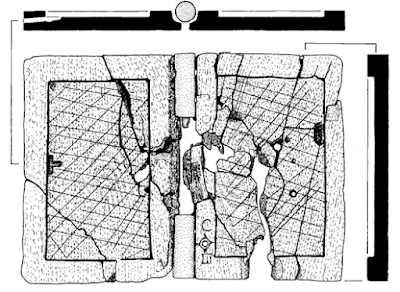 ÎίÏÏÏ
Ïο αÏÏ Ïο ναÏ
άγιο ÏÎ·Ï ÎνÏιÏÎλλοÏ
ÎίÏÏÏ
Ïο αÏÏ Ïο ναÏ
άγιο ÏÎ·Ï ÎνÏιÏÎλλοÏ
ÎÏÏοÏικÎÏ Î±Î½ÏανακλάÏÎµÎ¹Ï ÏÏον ÎμηÏο: Τα 'δÏο δοÏÏεα'ΣÏολιάζονÏÎ±Ï Ïην ÏαÏάÏÏαÏη ÏÏο ÏÏ ÏÏ Schimmel ÏημειÏναμε:[22]ΠίÏÏ Î±ÏÏ Ïην καθιÏÏή θεά καÏακÏÏÏ Ïα ÏοÏοθεÏημÎνα εικονίζονÏαι δÏο δÏÏαÏα, ανήκονÏα Î¼Î±Î¶Ï Î¼Îµ Ïον Ïάκκο και Ïην ÏαÏÎÏÏα ÏÏο ÏÏνολο Ïο οÏοίο ÏημαÏοδοÏεί Ïο ÎºÏ Î½Î®Î³Î¹, Î¼Î±Î¶Ï Î¼Îµ Ïο ιεÏÏ Î´ÎνδÏο και Ïην ÎλαÏο - θήÏαμα.[14_146] Το ζεÏÎ³Î¿Ï ÏÏν δοÏάÏÏν ÏαÏαÏÎμÏει ÏÏα âδÏο δοÏÏεαâ ÏÏα οÏοία εÏανειλημμÎνÏÏ Î±Î½Î±ÏÎÏεÏαι ο ÎμηÏÎ¿Ï ÏÏα ÎÏγα ÏÎ¿Ï ,[14_147] εÏÏηÏιμοÏοιοÏνÏο δε ÏÏÏον ÏÏο ÎºÏ Î½Î®Î³Î¹ ÏÏον και ÏÏον ÏÏλεμο, ÏÏο Îιγαίο και Ïην ÎναÏολία, ήδη αÏÏ Ïα μÎÏα ÏÎ·Ï Î´ÎµÏ ÏÎÏÎ±Ï ÏιλιεÏÎ¯Î±Ï ÏÏίν αÏÏ Ïην εÏοÏή μαÏ.[14_148] Σε ξίÏÎ¿Ï Î±Î½ÎµÏ ÏεθÎν ÏÏον ÏάÏο V ÏÏν ÎÏ ÎºÎ·Î½Ïν αÏεικονίζεÏαι ÎºÏ Î½Î·Î³ÎµÏική ÏολεμοÏÎ±Î½Î®Ï ÏαÏάÏÏαÏη ήÏÏÎ¿Ï Î¿ οÏÎ¿Î¯Î¿Ï Ï ÏοÏάÏÏει λÎονÏα, ÏÏ Î¼Î²Î¿Î»Î¯Î¶oνÏα ÏÎ¿Ï Ï ÎµÏθÏοÏÏ, ενÏ, αναλÏγÏÏ, ÏÏην ΧεÏÏιÏική εικονογÏαÏία Ïο ÎºÏ Î½Î®Î³Î¹ αÏεικονίζεÏαι ÏÏ Î²Î±Ïιλική δÏαÏÏηÏιÏÏηÏα με θÏηÏÎºÎµÏ ÏÎ¹ÎºÏ ÏαÏακÏήÏα.[14_149] ΠαÏάÏÏαÏη ÏÏν δÏο δοÏάÏÏν ÎÏÎ¿Ï Î¼Îµ για ÏÏÏÏη ÏοÏά ÏÏην ÏοιÏογÏαÏία ÏÎ·Ï ÎνÏÏÏÎ¿Ï ÏÏÎ¿Ï Î±ÏεικονίζεÏαι ο ÎÏÏηγÏÏ ÏÏν ÎαÏÏÏν,[14_150] αλλά και Ïε ÏοιÏογÏαÏία ÎºÏ Î½Î·Î³Î¯Î¿Ï Î±ÏÏ Ïην ΤίÏÏ Î½Î¸Î± καθÏÏ ÎºÎ±Î¹ Ïε αγγεία αÏÏ Ïην ΤίÏÏ Î½Î¸Î± και Ïο ÎÎµÏ ÎºÎ±Î½Ïί.[14_151]
ΣÎÎÎÎΩΣÎÎΣ
[0]. Online Exhibits, s.v. Translating an Oral Tradition into Writing.
[1]. Kadmos Mitteilungen 1990.29.1.84; Watkins 1987.
[2]. Mallory 1988, p. 177: Î¥ÏÏ Ïην Îννοια 'ίÏÎ¿Ï ÎºÎ±Ïά βάÏοÏ'.
[4]. Morris 1989: αÏοÏÏάÏμαÏα.
[6]. Ï.Ï. p. 511.
[6a] ÏÏ
νηθÎÏÏαÏα κοÏÏ
Ïή λÏÏοÏ
, LSJ: ÏκοÏ-ιά, Ion. ÏκοÏ-ιή, ἡ, lookout-place, in Hom. esp. a hill-top, ÏκοÏιὴν Îµá¼°Ï ÏαιÏαλÏεÏÏαν Od.10.97; á¼Ïὸ ÏκοÏιá¿Ï εἶδεν Il.4.275, Od.4.524; á¼¥Î¼ÎµÎ½Î¿Ï á¼Î½ ÏκοÏιῠIl.5.771; á½ÏÏá¿ÏÎ±Ï Î´á½² καÏá½° ÏκοÏÎ¹á½°Ï á½¤ÏÏÏ
να νÎεÏθαι each to his lookout-place, Od.14.261; á¼Î³Î³ÎµÎ»Î¿Ï . . á¼Ïὸ ÏηλαÏ
γÎÎ¿Ï ÏαινÏÎ¼ÎµÎ½Î¿Ï Ï. Thgn.550; watch-tower, Hdt.2.15; á½¥ÏÏÎµÏ á¼Ïὸ Ï. μοι ÏαίνεÏαι Pl.R. 445c. 2. peak, height, of Cithaeron, Simon.130; of Athos, S.Fr.237 (anap.); á¼¸Î»Î¹á½°Ï Ï., of the Trojan acropolis, E.Hec.931 (lyr.), cf. Ph.233 (lyr.), Ar.Nu.281 (lyr.), etc.; ÎάÏοÏ
ÏκοÏιαί JHS29.93: metaph., Pi.N.9.47:âÏκοÏιαί personified as women (Oreads), Philostr.Im.2.4. II. look-out, watch, ÏκοÏιὴν á¼Ïειν to keep watch, Od.8.302; οὠκῠÏÏÏÏÏ Ï. á¼ÏονÏÎµÏ ÏοÏÏÏν Hdt.5.13; κÏÏ
ÏÏαὶ Ï. X.Eq.Mag.4.10; ÏκοÏιὴν ÏÏ
λάÏÏειν Arat.883.
[7a]. Î ÏÏκειÏαι γιά Ïο μνήμα ÏοÏ
ÎλοÏ
, LSJ, s.v. Ïá¿Î¼Î±: sign by which a grave is known, mound, cairn, barrow, Il.2.814, etc.; âÏοῦ δὲ ÏάÏον καὶ Ïá¿Î¼á¾½ á¼ÏÎ´á½²Ï ÏοίηÏεν á¼Î½Î±Ï
ÏοÏâ Hes.Sc.477; á¼Ïὶ Ïá¿Î¼á¾½ á¼Ïεεν raised a mound, Il.6.419, etc.;}), ⦠{Ïο Ïήμα sign και ÏÏ sign by which a grave is known, mound, cairn, barrow !!!
[8]. Ï.Ï. p. 518.
[9]. Soph.Phil.300-303:
ΦέÏâ, ὦ Ïέκνον, νῦν καὶ Ïὸ Ïá¿Ï νήÏοÏ
μάθá¿Ï.ΤαύÏá¿ Ïελάζει ναÏ
βάÏÎ·Ï Î¿á½Î´Îµá½¶Ï á¼Îºá½½Î½Â·
Î¿á½ Î³á½±Ï ÏÎ¹Ï á½
ÏÎ¼Î¿Ï á¼ÏÏιν, οá½Î´â á½
Ïοι ÏλέÏν
á¼Î¾ÎµÎ¼ÏολήÏει κέÏÎ´Î¿Ï á¼¢ ξενώÏεÏαι.
Îá½Îº á¼Î½Î¸á½±Î´â οἱ ÏλοῠÏοá¿Ïι Ïá½½ÏÏοÏιν βÏοÏῶν...
και Ïε Îεοελληνική αÏÏδοÏη Î. Î. ÎÏÏ
ÏάÏη (https://www.greek-language.gr/greekLa...
ΤÏÏ' άκοÏ
και για Ïο νηÏί ÏÏÏ ÎµÎ¯Î½Î±Î¹Â·
ÎºÎ±Î½ÎµÎ¯Ï Î´ÎµÎ½ Ïιάνει ÎµÎ´Ï ÎºÎ±ÏαβοκÏÏηÏ
με θÎλημα ÏοÏ
, Ï' οÏÏε Îνα λιμάνι
δεν ÎÏει ÏοÏ
για κÎÏÎ´Î¿Ï Î¼Î¹Î± ÏÏαμάÏεια
να εμÏοÏεÏ
Ïή ή να βÏη κονάκι ο ξÎνοÏ·
ÏÎ¿Î¹Î¿Ï ÎÏαÏε Ïο νοÏ
ÏοÏ
ÎµÎ´Ï Î½Î± ÏιάÏη;
[16]. Page 1963, p. 140. Îλ. wikipedia, s.v. Trojan Battle Order.[18]. Shear 1998, n.4. [20]. Knox 1996, p. 20 ('Introduction', in Homer. The Odyssey).[22]. ÎονιδάÏÎ·Ï 2022, Ïελ. 216.[14-146]. ÎονιδάÏÎ·Ï 2022, Ïελ. 216, Ïημ. 14_146.[14-147]. ÎονιδάÏÎ·Ï 2022, Ïελ. 216, Ïημ. 14_147.[14-148]. ÎονιδάÏÎ·Ï 2022, Ïελ. 216, Ïημ. 14_148.[14-149]. ÎονιδάÏÎ·Ï 2022, Ïελ. 216, Ïημ. 14_149.
ÎÎÎÎÎÎÎΡÎΦÎÎ
https://www.degruyter.com/document/do...
https://www.scribd.com/document/36814...
Kadmos Mitteilungen 1990.29.1.84
"MITTEILUNGEN, The Third International Congress on Santorini (Thera)," Kadmos 29 (1), pp. 84-88.
Watkins, C. 1987. âLinguistic and Archaeological Light on some Homeric Formulas,â in Proto-Indo-European: The Archaeology of a Linguistic Problem. Studies in Honor of Marija Gimbutas, ed. S. Nacev and E. C. Polomé, Washington, pp. 286-298.
https://www.cambridge.org/core/journa..., J. 1988. Rev. of Susan Nacev Skomal & Edgar C. Polome (ed.), Proto-Indo-European: the archaeology of a linguistic problem: essays in honor of Marija Gimbutas, in Antiquity 62 (234), pp. 177-178.
http://art.buffalo.edu/coursenotes/ah..., S. P. 1989. âA Tale of two Cities: The Miniature Frescoes from Thera and the Origins of Greek Poetryâ, AJA 93 (4), pp. 511-535.
http://kernos.revues.org/1096Dietrich, B.C. 1994. âTheology and Theophany in Homer and Minoan Crete,â Kernos 7, pp. 59-74.
Page, D. 1963. History and the Homeric Iliad, Berkeley, Los Angeles: University of California Press.
Knox, B. 1996. Introduction to the Odyssey, Homer, trans. B. Fagles, New York, p. 20. 'Introduction', in Homer. The Odyssey.
https://www.academia.edu/355137/1997_...
Cline, Î. Î. 1997. âCrossing Achilles in Anatolia: Myth, History, and the Assuwa Rebellion,â in Crossing Boundaries and Linking Horizons. Studies in Honor of Michael C. Astour on His 80th Birthday, ed. G. D. Young, M. W. Chavalas, and R. E. Averbeck, Bethesda, pp. 189-210.--p. 198: .. certain motifs found in Homer were taken from earlier poetry; p. 201: .. the 'Trojan Catalogue' found in Homer's Iliad (Il.926-89), which is itself thought to be an authentic survival of the Late Bronze Age.50Albright put it most concisely, staling: If the Assuwan Confederacy was really centered in the northwestern part of the peninsula.. .it corresponded strikingly in makeup and geographical extension to the Trojan confederation in the Iliad.51p. 202: e LM IA Thera Frescoes might provide.. p. 206: Thus, according to the legends of the ancient Greeks, Mycenae, Tiryns, and Argos all traced at least part of their ancestry back to the same area of Anatolia wherein lay the coalition of states known as Assuwa.---------------------------------------------------------------------------------------------------------------------------https://www.jstor.org/stable/632241?s..., I. M. 1998. âBellerophon Tablets from the Mycenaean World? A tale of seven bronze hinges,â JHS 118, pp. 187â189. DOI: http://dx.doi.org/10.2307/632241
ÎονιδάÏηÏ, Î. 2022. Îι ΧεÏÏαίοι και ο κÏÏÎ¼Î¿Ï ÏÎ¿Ï ÎÎ¹Î³Î±Î¯Î¿Ï , γ' εÏÎ·Ï Î¾. ÎκδοÏη, Îθήνα.
Online Exhibits, s.v. Translating an Oral Tradition into Writing, <https://apps.lib.umich.edu/online-exh... (26 May 2022). -------------------------------------------------------------------------------------https://www.jstor.org/stable/23048961
Alexandra Rozokoki, A. 2011. The Significance of the ancestry and eastern origins of Helen of Sparta," Quaderni Urbinati di Cultura Classica, New Series 98 (2), pp. 35-69.
June 19, 2022
Sericulture and Han Silk
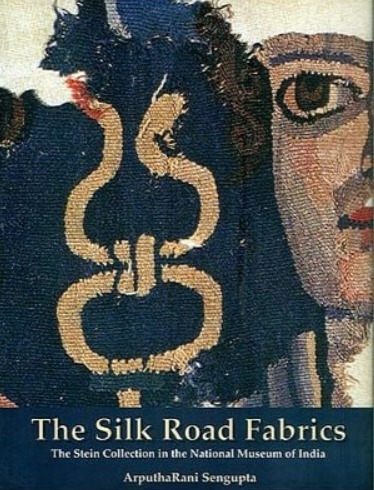
PrefaceTHE very notion of silk was shaped by China's adventure with sericulture. It profoundly affected the economic and cultural development of the ancient world. The rarity and antiquity of textiles from Sir Marc Aurel Stein's three expeditions are best conveyed by Stein's assistant Fred Andrews who in his article in The Burlington Magazine (1920) stated that "the first impression of a casual examination of the specimens was the absence of general resemblance to anything in textiles with which we are familiar". Commencing from Stein's crucial discovery of burial silks in the Tarim Basin in 1913, over 2,000 textile fragments have been recovered during three of his expeditions in the first two decades of the twentieth century. Sir Stein's gigantic contribution to Central Asian archaeology was due to his amazing stamina, courage, intuition, and luck. The varieties of textile excavated by him span several centuries, from the first century BCE to the eleventh century CE. Classified by the sites of their discovery, relics from Loulan and Astana constitute the majority. The exotic fragments were shared between the museums in London and New Delhi. Parts of the Stein Collection in London include those in the British Museum and some 700 textiles on loan to the Victoria and Albert Museum. The importance of over 600 textile pieces in the National Museum at New Delhi cannot be underemphasized. The deliberation on the high quality and artistic value of the Stein Collection in India is intended to fill a lacuna and realize at least in part the worldwide interest to study a significant segment of the Stein Collection not in view. This was made possible by the liberal consent of Kuniko Ono, the publisher of Shikosha Artbooks. First published in Japan in 1979, the reproduction of the Stein Collection in Fabrics from the Silk Road in the National Museum of India has helped to exemplify Sir Stein's Central Asian expedition in the four volumes of Innermost Asia published in 1928.
Besides Stein's assemblage, Central Asian burial textile in the State Hermitage Museum in Leningrad is a major collection. Our knowledge of antique textile comes mainly from these museum pieces. Archaeological textile studies are an important source of information for anthropological and technological inquiry. At Copenhagen John Becker's reconstruction of Han Pattern and Loom resulted in the instructive A Practical Study of the Development of Weaving Techniques in China, Western Asia and Europe first published in 1986. Moreover color is the single most remarkable quality of any Central Asian textile. The sources of natural dyes and method of fixing hold a number of clues. The discovery of heritage textiles from Central Asia and China is comparatively recent. Even so, the admirable work of scholars and ever-growing demand in a collector's market have increased the number of publications on ancient textiles in museums and art galleries. The Metropolitan Museum of Art and The Cleveland Museum of Art came together and held an exhibition of the Asian textiles dating from the eighth to the early fifteenth century CE. The catalog When Silk Was Gold: Central Asian and Chinese Textiles published in 1997 by the collaborating museums admirably fulfilled a function in this category. Since 1950 the second period in archaeological excavation of textiles was undertaken by the People's Republic of China in well over 100 burial sites in south central China, Mangolia and Central Asia. In collaboration with worldwide institutions The Silk Road International Dunhuang Project documentation makes research in this area infinitely expandable.
The mysterious innovations in silk weaving in Central Asia are astonishing in the light of the fact that the technology was known for centuries in West Asia. Chinese Central Asia without the proto-weaving techniques of twining and plaiting suddenly accomplished sericulture and professional silk weaving. The fully developed and technically unsurpassed figure weaves from a landlocked region defined by its deserts, inhospitable climate and limited rainfall are rather mysterious. The greatest advantage was the native mulberry bush in the rearing of Bombyx mori for the finest and longest of silken thread. The convergence of sericulture and silk weaving had definitive form and function. Exposed to freezing nights and searing heat during the day, graves yielded stunning silk furnishing symptomatic of a drastic change in funerary customs. Ethno- archaeology not only reveals technical excellence in weaving but also offers proof of faith in afterlife. The discovery of these historic fabrics preserved in Japan, Africa and Europe exposes their identity and character. In addition, the textile designs actually have a notable function in Parthian and Greco-Buddhist architectural reliefs in Persia and South Asia. Riboud's discussion on Han dynasty textiles compares the animal style to early Indian sculpture. The shared motifs in mortuary art indicate that a full exploration in this direction is a challenging but a rewarding task. When that cultural context is not acknowledged a great amount of historical realism is also lost. To address this problem consideration of religious symbolism, funerary customs and folklore inherent to the burial silk and artifacts recovered along the Silk Road is essential.
As the most preferred funerary goods silk worth its weight in gold is the most significant factor in the trade along the Silk Road. Caught in the dynamics of history are the geopolitical plot and the emerging distinction between China, Inner Asia and Eurasia in the geographical sense of the term. It was not yet populated by either self- contained or self-defined nationalities. Ethnically and culturally indistinct nationalities intermingled in the Crossroads of Asia. As the carriers of ideas and commodities and also religions, merchants and travelers not only connected Mongolia-China with Syria, Turkey, and Egypt but several of them even adopted new homelands. Commercial contacts have a longer lasting life and an immense potential to cement the bonds between various countries. As a result, the Greco-Buddhist reliquary cult in South Asia flourished precisely due to the lucrative silk trade with Rome. It is in this light that several of the figured textiles will be viewed in terms of their affirmed function. One of the astonishing by-products of the Silk Road is the jade garment. Depending on the station of the person buried, body suits made of pieces of jade are exceptional. These are fashioned mostly with square or rectangular and occasionally triangular, trapezoid and rhomboid plaques knitted together by gold, silver or copper wire. The most fabulous among these is the jade burial suit at the Mausoleum Museum of the Nanyue King in Cuangzhou. The "patchwork suit" is made of 2,291 pieces of jade pieces connected by red silk thread or silk ribbon overlapping the edges of the plaques. The world's oldest textile printing blocks in bronze from this Han tomb are also part of the Nanyue culture. Indicating that Guangzhou in the ancient Silk Route was exposed to diverse influences, the tomb contained in addition to extraordinary Chinese burial goods, five African elephant tusks, frankincense and a silver box from Persia.
Patchwork robe refers to clothing pieced together from bits of precious cloth. It indicates that even small pieces of textile fragments were treasured. Seated Buddha from the Mathura school in north India wears scraps of fabric sewn together. A votive frieze from Amaravati (now in Los Angeles) also depicts patchwork garment with square patches. In philosophic terms the "patchwork robe of salvation" in the Greco- Buddhist cult might be a treasured spiritual vestment or simply a skillful means of teaching (upaya):
Zen master Tongan asked, "What is the business under the patchwork robe?" Liangshan had no answer.
Tongan said, "It is wretched if you don't reach this state. You ask me and I'll tell you."
IntroductionThe main commodity in the international trade was silk produced in China. Seres, the Greek word for silk, became synonymous for China, the land of silk. The Latin serieum is derived from the Greek ser. The adoption of Greek and Latin words for silk is evident in other languages: sieg in Chinese, modern ssu for silk thread, sir in Korean, sirket in Mongolian, seale in Russian, and silk in English. Referring to the ancient overland silk trade routes, the nineteenth-century German geographer Ferdinand von Richthofen first coined the word Seidenstrassen or Silk Road between East and West. Most of the medieval sources refer to the famous highway as Big Route (botshaom targovam puti) or Shawari Caravan (Shahrahibuzurg) and even as Silk Road (Rahiabrasnami) To reach the Syrian markets it had to cross the deserts and mountains of Asia. Along the most dangerous stretches of the route fortified strongholds were built to protect the precious caravans. In the first centuries of the Christian era Hatra in Iraq among the great Parthian cities continued to flourish as a major Arab staging-post. In the chain Hatra linked Palmyra (sacked CE 272) and Dura-Europos in Syria (deserted CE 256), Petra in Jordan (declined CE 235), and Baalbeck in Lebanon, all having the eclectic identity of a mixed population merged with the Greek settlers. Pliny the Elder and others identify Petra, the capital of the Nabataeans, as the center of caravan trade. The caravan route of the Silk Road branched off at certain points for practical purpose. In Bactria the route turned southwards, continuing by sea through the Persian Gulf and then to Alexandria by way of the Red Sea. Thus on its western end the Silk Road began on the Mediterranean coast, in the ports of Alexandria and Antioch. It wound its way through the caravan cities in northern Iran, Chorasrnia and Ferghana, and then through western Turkistan, notably the city of Samarkand in Sogdiana. The arterial route then scaled the Pamir range, the Roof of the World. It then became the T'ien Shan South Road that skirted the Takla Makan Desert, passing through such oasis towns as Kashgan and Kucka along the way. Entering China through Loulan or Dunhuang, the Silk Road finally reached Ch' ang-an, the city known today as Sian (0.1). To the Han the economic factor of silk was significant. A speech by the Grand Secretary to the early western Han Council recorded in 81 BCE proclaims the importance of silk trade with the nomad tribes in the north:
For a piece of Chinese plain silk article several pieces of gold can be exchanged with the Hsiung-nu, and thereby reduce the resources of our enemy. Thus mules, donkeys and camels cross the frontier in unbroken lines; horses, dapples and bays and prancing mounts, come into our possession. The furs of sables, marmots, foxes and badgers, colored rugs and decorated carpets fill the imperial treasury, while jade and auspicious stones, corals and crystals become national treasures.
Above all, the supply of lustrous silk to Rome by way of Parthia and Palmyra filled the coffers of the eastern kingdoms. And as planned, it also reduced the vital resources of their common enemy. The Syrian glass factories established at this time in Central Asia were probably part of the reciprocal exchange between China and Syria. By shifting important local industries from the subject nations, there appears to be a concerted effort to deny Rome the benefits of its imperial power. This ploy made Rome pay exorbitant amounts of gold to buy the luxurious silk and precious gems, cut glasses and crystals, aromatics and medicines, as well as wine from Ferghana it craved for. Pliny complained that the luxury goods were depleting the Roman treasury to the extent of fifty million sesterces annually.' A vital section of the Silk Route was owned by the Parthians and due to concerns caused by the expansionism of Rome, for about fifty years silk intended for Rome traveled through Media, Armenia and on to Colchis and the Black Sea coast. In CE 66 the ploy of crowning the Parthian ruler Trididates in Rome did not yield expected results and the Sasanians who supplanted Parthians continued to resist the advances of Rome and levied heavy taxes on the caravans passing through their territories.
The Silk Route
Roughly the size of Australia, Central Asia covers the immense expanse of the empire of the steppes called Russian and Chinese Turkistan. The overland caravan contact along the southern limits of the region became possible with the domestication of the Bactrian camel in the first centuries of the Common Era (0.2). Following camel trails nomads in the Eurasian Kazakhstan still gallop across the steppes and the high mountain pass. Ancient traditions are kept alive by the craftsmen in the vibrant markets and caravanserais of Kazakhstan, Turkmenistan, Uzbekistan and Xinjiang. It is a mysterious land of myths and legends in which the Silk Road has left behind ruined cities and tombs. The Chinese autonomous Province of Xinjiang has Takla Makan Desert and Kunlun Mountains in the south sharing borders with Tibet and Pakistan where Gilgit is located on the ranges of Karakoram. The major sites in Xinjiang are Loulan, Astana, Niya, Bezeklik, Taxkurgan and Fiaoche. In Western Kinghay, cultural counterparts of Xinjiang are Sholak Korgon, Koshoy Korgon, Shirdakbek, Lap Nor and Gandhara. Consequent to Alexander's conquest, Sogdiana between River Amu Darya and Syr Darya played an important role in the religious and cultural development of Central Asia. Until the eighteenth century, the merchants who took the hazardous journey were mostly Sogdians, a Greco-Iranian people (0.3). Thereafter the Uyghurs, a Turkic people of Central Asia, took over and established settlements along the way (0.4). Two trade routes were most traversed. One passed through the land from the hilly areas of Gilan to Alburz that came to an end at the Caspian Sea. The Hindu Kush and the Pamirs cut off Inner Asia from India and the Tibetan Plateau. The route went by way of Khurasan and Kabul and entered the Indian subcontinent. The third turned south from Samarkand and went through Bactria toward Gandhara, which is now part of Afghanistan and Pakistan. By land and sea the Silk Route linked Tamluk on the Bay of Bengal. As a thriving cult center it introduced exotic votive terracotta that glorified the goddess wrapped in splendid gold and diaphenous silk (0.5).
Far from being a monolithic entity like Egypt, China did not have nationalistic lines either in geographical or cultural terms. Chinese territory from the Yellow River to its western frontiers extended towards Afghanistan and north-eastward to the Karakoram Range and the Tian Shan Mountains, which encompass the Tarim Basin. From the Carpathians in the west, grasslands stretch north of the Black Sea across the Dnieper, Don, and Volga rivers eastward to the drainage of the Irtysh River north of Lake Balkash and on to the foothills of the Altai Mountains. The mountain barriers of Hindu Kush, Karakoram, Kuen Lun, and the Western Himalayas did not prevent the merchants and religious zealots in their activities. South of the Kazakh Steppe is the extremely arid Turkistan and its Takla Makan Desert. The far-flung region's survival centered on natural oases on the caravan routes along Samarkand (Marakanda), Bukhara, Khiva, Merv, Kokand, Kashi (Kashgar), Yarkand, and Turpan (Turfan). The Silk Route went through ancient cities in which Chang'an, Dunhuang, Kashgar, Yarkand, Khotan, Herat, and Almaty linked East and West. The relatively safe overland routes under the Mongols from the Black Sea to the Pacific Ocean were used later by the Polo Brothers.Sericulture and Han Silk
Out of the range of craft material the magical silk fabric is probably the most distinctively Chinese. Silk wearing requiring specialized skills, equipment, and process increased its prestige; pure kanaus silk is still called podshoki, the "Emperor's Cloth" in Central Asia. Silk was a major economic factor and signifier of social status. This was nevertheless not so noteworthy compared to its demand as shroud and as grave goods since silk was perceived to be a unique material effecting metamorphoses. The lustrous stuff spun from the cocoons was believed to reward rebirth and eternal life. To be buried in a silken shroud was actually not beyond one's dream in Central Asia. The silk fragments, apart from its historic and artistic significance, provide information on ancestor worship in the funerary cult that is deep-seated in China. The Chinese believed that the dead ancestors continued to be part of the family and had their own need in afterlife. The dead were thus cared for and propitiated with burial goods in which silk was a vital component. From Han dynasty (206 BCE-ca 220) onwards silk was currency for immortality. As Late as Ming (1368-1644) and Qing (1644-1911) period, a kind of furnace (kabala) was erected in the royal tombs near Beijing to burn messages on silk to communicate with the emperor's soul. With regard to veneration of ancestors, Matteo Ricci, who worked in China from 1582 until his death in 1610, wrote in his memoir:
The most solemn thing among the literati and in use from the exalted king down to the very least person is the annual offering they make to the dead at certain times of the year â of meat, fruit, perfumes, incense and pieces of silk cloth â and paper among the poorest. And in this act they make the fulfilment of their duty to their relatives, namely, "to serve them in death as though they were alive".'
A brief description by Phan shows that despite its ancient origins veneration of ancestors continued to be the most important ritual in China. In funerary rituals a piece of paper or white cloth bearing the name of the deceased is placed in front of the corpse prepared for burial. After burial, this name tag is brought home to the family altar to receive prayers and acts of piety. Eventually it is replaced by a piece of wood called the "spirit tablet". On its front the name, family status, and societal rank of the deceased are written, and on its back, the dates of birth and death. Since the soul of the deceased is believed to reside in this tablet, characters such as shen wei or Iing wei or shen zur meaning "the seat of the spirit" are inscribed on it. Venerated ancestors' portraits are placed in the family altar and on special occasions like birthday or death anniversary spirit of the dead is given offerings. On festivals such as the New Year and on the first and fifteenth days of the month of the lunar calendar, graves are tended and family members gather to feast on sacrificial food and drink and pay respect, burn silk, incense and paper money. Days are set aside in the traditional Chinese calendar for these duties, the most important being the "clear and bright" (qing ming) full-moon day in early April. At the heart of all these ancestor rites is filial piety (hsiao), the most important virtue in Confucian ethics, by which a person lives out five relationships (wu lun) â ruler and subject, parent and child, husband and wife, older and younger siblings, and friends.
Silk in Pre-Han EurasiaAncient-most excavated Han textiles according to style and motif belong to Western Han (207 BCE - c. 9) and Western Han (10-221),[2] Because of its social and economic status the secrets of silk manufacture were guarded by strict regulations, with threat of torture and death to those who break the restrictions. At Augustus Censer's demise in 14 CE the exotic iridescent silk was banned in Rome and was hence hoarded like gold. Silk shrouds in burials are much more visible than silk currency in barter or payment to army officers. As such the secrets of silk recovered from burials hold the reality of what life was for countless generations of the dead. A unique culture emerged out of a distinctive historic setting. The search is to discover the favorable conditions to the development of Han silk industry and how the wide market for silk in Central Asian burials was linked to the escalation of the Greco-Buddhist relicary cull in South Asia.[3] The evidence, strangely enough, might lie in the birth of as new era filled with renewed hope in resurrection and afterlife.
.............................
been and is and will be; and no mortal has ever lifted my mantle" had universal concurrence.[39] Apart from being a valuable stuff, the worth of silk is further enhanced by its magical motifs. From an early date the winged griffin in textiles was developed to manifest the divine. The garment worn by the Sasanian king on the rock carvings of Taq-i-Bustan in Iran depicts winged Serimurvs (Simurgh) set in an overall pattern of small medallions enclosing, rosette with four petals to convey immortality (2.34a). The Senmury caftan depicted on the left wall of the Great Ivan is similar to the ninth-century silk caftan with embroidered senmurvs conserved in the Hermitage Museum. It is made up of Sasanian and Chinese silk pieces decorated with the fabled senmurv. Textile design displaying unity of form and content demonstrates skillful organization of motifs based on clearly understood agenda. The senmurv carved on the costume of a Sasanian king at Taq-i-Bustan in western Iran reveals its extraordinary breadth and geographical span (2.34b). Senmurv, the winged griffin in Sasanian art, is a dog-faced winged lion embossed in gold applique (2.34c). The popular motif within a circular border in a treasured parcel gilt silver plate of a Sasanian king is typical of the wide varietyt of contexts (2.34d).
One of the remarkable Sasanid weft-faced silk twill woven with simurgh is the reliquary of Saint Len in Paris (2.35). A fragment of this fabric in compound weave is in the Victoria and Albert Museum in London (8579-1863). The weft-faced compound structure utilize single or paired warp sets with plain weave or twill binding systems. Some of them are excavated in Egypt, northern Caucasus, India and China. The senmurv is enclosed in interlocking pearl roundels with stylized floral motifs filling the interstices. The framed senmurv replicated in Sogdian silk is interconnected at the tangent points by a crescent within smaller pearl medallion. The peacock tail of the senmurv is intricately woven and its distinctive armband with svmbolic motif reflects a taste for opulent textiles that extended outward from the Mediterranean basin. The crescent on the Alexandrian copper coin of Augustus as symbol of redeeming goddess IsisâDemeter recurs in the woven textiles of seventh-eighth century CE. In seventh and eighth centuries its original function was reclaimed in sculptures carved on several funerary monuments in Iran (2.36), A similar wall panel from the same site in Chal Tarhan but in a better condition is in the British Museum (A ME 1973.7-25.3). The Persian griffin widely used in textiles and metalwork as emblem of Sasanian kingship appeared first as necromantic sign on Greco-Buddhist reliquary mounds (2.37). The
[p. 98] been and is and will be; and no mortal has ever lifted my mantle" had universal concurrence.[39] Apart from being a valuable stuff, the worth of silk is further enhanced by its magical motifs. From an early date the winged griffin in textiles was developed to manifest the divine. The garment worn by the Sasanian king on the rock carvings of Taq-i-Bustan in Iran depicts winged Serimurvs (Simurgh) set in an overall pattern of small medallions enclosing, rosette with four petals to convey immortality (2.34a). The Senmury caftan depicted on the left wall of the Great Ivan is similar to the ninth-century silk caftan with embroidered senmurvs conserved in the Hermitage Museum. It is made up of Sasanian and Chinese silk pieces decorated with the fabled senmurv. Textile design displaying unity of form and content demonstrates skillful organization of motifs based on clearly understood agenda. The senmurv carved on the costume of a Sasanian king at Taq-i-Bustan in western Iran reveals its extraordinary breadth and geographical span (2.34b). Senmurv, the winged griffin in Sasanian art, is a dog-faced winged lion embossed in gold applique (2.34c). The popular motif within a circular border in a treasured parcel gilt silver plate of a Sasanian king is typical of the wide varietyt of contexts (2.34d).
One of the remarkable Sasanid weft-faced silk twill woven with simurgh is the reliquary of Saint Len in Paris (2.35). A fragment of this fabric in compound weave is in the Victoria and Albert Museum in London (8579-1863). The weft-faced compound structure utilize single or paired warp sets with plain weave or twill binding systems. Some of them are excavated in Egypt, northern Caucasus, India and China. The senmurv is enclosed in interlocking pearl roundels with stylized floral motifs filling the interstices. The framed senmurv replicated in Sogdian silk is interconnected at the tangent points by a crescent within smaller pearl medallion. The peacock tail of the senmurv is intricately woven and its distinctive armband with svmbolic motif reflects a taste for opulent textiles that extended outward from the Mediterranean basin. The crescent on the Alexandrian copper coin of Augustus as symbol of redeeming goddess IsisâDemeter recurs in the woven textiles of seventh-eighth century CE. In seventh and eighth centuries its original function was reclaimed in sculptures carved on several funerary monuments in Iran (2.36), A similar wall panel from the same site in Chal Tarhan but in a better condition is in the British Museum (A ME 1973.7-25.3). The Persian griffin widely used in textiles and metalwork as emblem of Sasanian kingship appeared first as necromantic sign on Greco-Buddhist reliquary mounds (2.37). The
...
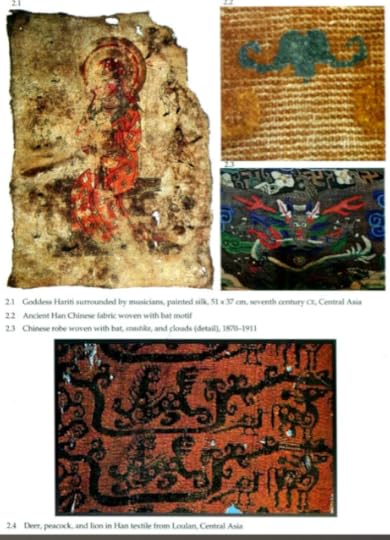
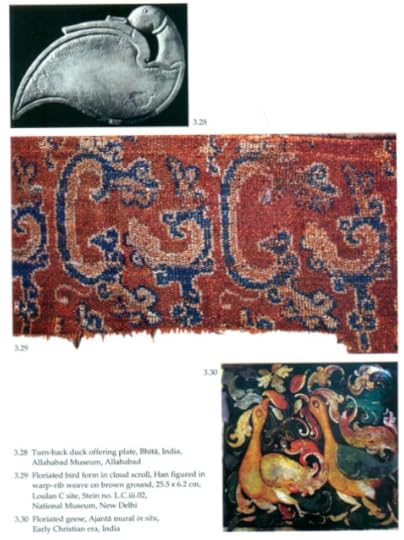
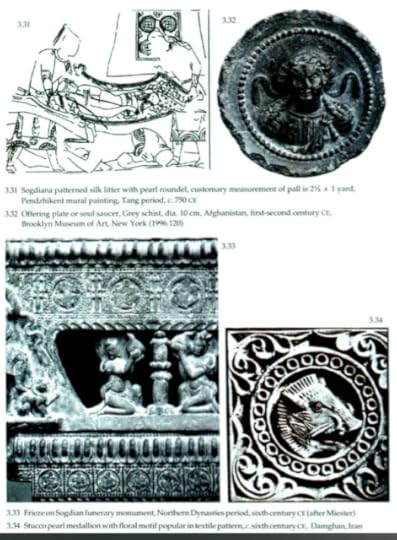
[p. 248]. remains from the Parthian artifacts from Grave IV at Tillya Tepe in Afghanistan establish that embellishment of silk with gold thread was already in practice in the first century CE. The exquisitely crafted costumes and gold jewellery from the six graves in the "gold mound" were probably manufactured in Syria and Cyprus. The extraordinary geographical span of textiles originating in Central Asia has equally remarkable breadth of time. A fragment of Faimid-era door panel from Cairo depicts within a circular pearl roundel a celestial musician in a costume embellished with characteristic Sogdian circular motif within lattice framework (4.14).
Besides spreading cultural interchange, the "intercultural style" of silk continued to be a form of currency. Silk served as salary, reward, tax, and a means of barter and glorification until the medieval period. However, there was a marked reduction in the volume of trade due to the expansion of Islam when the explosive situation along the Silk Road stretched from Syria (636 CE), Alexandria (641 CE), and the whole of North Africa (647-98 CE). Islam held sway over commerce in the Red Sea and the Nile by capturing the caravan routes of North Africa, Spain (712 CE), and Persia. It introduced a gradual transition from Sasanian, Coptic, and Byzantine traditions in the form of highly valued Persian tiraz often inscribed with the names of kings, dates, and sites. Bestowed as sign of honor, fragments of many lines on tiraz used as shroud have been preserved in Egyptian tombs. These embroidered textiles provide window into political and religious life of early Islam. Bypassing the religious turmoil then besetting the West, China's trade during the Tang dynasty (618-906 ce) prospered due to the alternate East-West trade over the southern route by way of Ceylon and Tamil Nadu in south India. At the height of Tang dynasty, silk weaving in Kancipuram in Tamil Nadu flourished under the Pallava dynasty (fourth-late ninth century ce). Simultaneously, woodblock printing and dyeing workshops in South Asia produced less expensive substitutes for South-East Asia, Egypt, and West Africa. A group of seafaring Persians, Ethiopians, and Syrians traded in Chinese and Indian goods while the Chinese traded in lndo-China, Korea, India, and Ceylon from where her products reached Egypt, Eurasia, Persia, and the Byzantine Empire. Chinese raw silk was the most important single item of trade since the inception of the Roman Empire. Strategic geographic position of Persia enhanced trade with Syria and Byzantium that bought Chinese raw silk at inflated price till the fifth century. To maximize profit., the Soghdians in 550, like the Syrians of the Roman province, managed
Epilogue 249
to bypass both the Sasanian and Byzantine courts, and achieved great success in silk trade.[14] Their commercial interest was limited to the reselling of silk yarn and readymade raw silk from the Chinese to the merchants who supplied the Persians, Syrians, Byzantines, and Indians. The Sogdian cycle of mural paintings at Afrasiab in the so-called "hall of the ambassadors" represents not only their gorgeous silks and wealth but also their expectations in afterlife (2.22). The local ruler of Samarkand and Soghdiana, represented in the cycle of mural paintings, is identified as the governor (650-55 CE) sent by the Chinese emperor Gaozong (649-83 ce).[15] Efficient relay stations for the mounted messengers helped management of export and inter-regional trade. China imported from Syria precious and semi-precious stones and artificial glass gems. woven silk, wrought garments, and gold. Persia monopolized pearl and coral trade to China since these were important ingredients in Chinese magic potions and used as elixir of life in religious rituals. Iran's export to China also included wasma (woad âindigo) obtained from Egypt. In addition, the Persians sold enormous quantities of Persian brocades woven with Chinese yarn to meet the artificial demand created in Byzantium due to court restrictions. However, from mid-fifth to mid-sixth century CE Sasanian Iran suffered blockade by the Hephtalites rulers in Central Asia. The war with Byzantium for a century from 527 ce onwards was also a bleak period for the Sasanids (226-651 ce), when Turks made most of the embargo placed on Persian commodity by strengthening their hold on transit trade in silk combined with the traffic of dancing girls from Samarkand and Khotan. By taking control of the Silk Road the Turks benefited from direct trade with Byzantium and the Caspian regions. But these two vexing problems may ultimately be connected. One is the development of technology for its religious application in burial textiles and the recognition of the commercial advantage of the distribution of patterned silks in weft-faced compound weaves. Roger II of Sicily (1095-1154 CE), the nephew of Norman chief Guiscard, succeeded â¦
[14] Through the envoy led by Maniah the Sogdiarts at fiat sought free trade with Persia but it failed when Shah Khosro torched their silk in front of their eyes to prove that they had no need of the silk from the Sogdians or the Turks. The Sogdians were then encouraged by their Turkish rulers to negotiate directly with the Byzantines, the fiercest enemies of the Persians.
[15] Chavannes, Documenf Sur les Tou-kiue (Tyres) Occidentaux, SI. Petersburg, Ma 135. Quoted by Matteo Cornpareti, in Further Evidence for the interpretation of the 'Indian Scene' in the Pre-Islamic Paintings at Afrasiab (Samarkand).
https://www.exoticindiaart.com/book/d...
Sengupta, Arpurathani. 2018. The Silk Road Fabrics (The Stein Collection in the National Museum of India),
June 7, 2022
WOMAN AT THE WINDOW
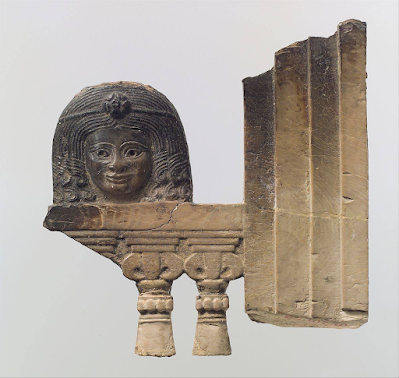 ÎιάÏÏηÏη Ïλάκα εÏιÏλÏÏεÏÏ Î¼Îµ ' γÏ
ναίκα ÏÏο ÏαÏάθÏ
Ïο'[NOTE0]
ÎιάÏÏηÏη Ïλάκα εÏιÏλÏÏεÏÏ Î¼Îµ ' γÏ
ναίκα ÏÏο ÏαÏάθÏ
Ïο'[NOTE0]ÎΠΠΤΠÎΣÎÎ ÎΣÎÎΤΩΠΤÎÎ¥ Yair Zakovitch[NOTE1]
Îια άλλη Φοινικική ÏαÏάÏÏαÏη Î³Ï Î½Î±Î¯ÎºÎ±Ï ÏÏο ÏαÏÎ¬Î¸Ï Ïο, Î±Ï Ïή Ïη ÏοÏά Ïήλινο ομοίÏμα ιεÏÎ¿Ï Î¼Îµ Î³Ï Î½Î±Î¯ÎºÎ± ÏÏο ÏαÏÎ¬Î¸Ï Ïο, βÏÎθηκε ÏÏην νεκÏÏÏολη ÏÎ¿Ï ÎÎ´Î±Î»Î¯Î¿Ï ÎÏÏÏÎ¿Ï .[10] Îίναι ενδιαÏÎÏον ÏÏι ÏÏÎ¹Ï ÎεÏαμοÏÏÏÏÎµÎ¹Ï ÏÎ¿Ï (βιβλίο 14, γÏαμμÎÏ 696-7611, ο ÎÎ²Î¯Î´Î¹Î¿Ï Î±ÏηγείÏαι Ïην ιÏÏοÏίαâÏÎ¿Ï , ÏÏοÏθÎÏει, ήÏαν ÏÎ¿Î»Ï Î³Î½ÏÏÏή Ïε Ïλη Ïην ÎÏÏÏο - ÏÎ·Ï ÎναξαÏÎÏηÏ, Î¼Î¹Î±Ï ÏÏιγκίÏιÏÏÎ±Ï ÏÎ¿Ï Î±Î´Î¹Î±ÏοÏοÏÏε για Ïην αγάÏη ενÏÏ ÎµÏÏÏÎµÏ Î¼ÎÎ½Î¿Ï Î½ÎÎ¿Ï , ο δε αÏελÏιÏμÎÎ½Î¿Ï Î½ÎµÎ±ÏÏÏ Î±Ï ÏοκÏÏνηÏε και, καθÏÏ Î· ÏÏιγκίÏιÏÏα ÎβλεÏε Ïην νεκÏική ÏομÏή ÏÎ¿Ï Î½Î± ÏεÏνά κάÏÏ Î±ÏÏ Ïο ÏαÏÎ¬Î¸Ï ÏÏ ÏηÏ, ολÏκληÏο Ïο ÏÏμα ÏÎ·Ï Îγινε ÏÎÏÏα,[11] Îνα άγαλμα ÏÎ·Ï ÏÏιγκίÏιÏÏαÏ, ÏÏοÏθÎÏει ο ÎβίδιοÏ, βÏίÏκεÏαι ÏÏην Σαλαμίνα. Î Anni Caubert[12] ενÏÏÏιÏε ÏÎ¹Ï ÏÏÏÏÎµÏ ÎµÎ¼ÏανίÏÎµÎ¹Ï ÏÎ¿Ï Î¸ÎμαÏÎ¿Ï ÏÎ·Ï Î³Ï Î½Î±Î¯ÎºÎ±Ï ÏÏο ÏαÏÎ¬Î¸Ï Ïο Ïε ÎινÏικÎÏ ÏοιÏογÏαÏίεÏ[13] αÏÏ Ïην δεÏÏεÏη ÏιλιεÏία Ï.Χ., μαζί με ÏαÏαÏÏάÏÎµÎ¹Ï ÏÎ·Ï Î§Î¬Î¸Î¿Ï, ÏÎ·Ï ÎιγÏÏÏÎ¹Î±Ï Î¸ÎµÎ¬Ï ÏÏÏον ÏÎ¿Ï Î½Ï ÎºÏεÏÎ¹Î½Î¿Ï ÏÏον και ÏÎ¿Ï Î¿Ï ÏÎ±Î½Î¿Ï ÏÎ·Ï Î·Î¼ÎÏÎ±Ï (ο δίÏÎºÎ¿Ï ÏÎ¿Ï Î¿ Î®Î»Î¹Î¿Ï Î¹ÏοÏÏοÏεί ανάμεÏα ÏÏα κÎÏαÏα ÏÎ·Ï Î±Î³ÎµÎ»Î¬Î´Î±Ï ÏÏο κεÏάλι ÏηÏ),[14] θεά ÏÎ¿Ï ÎÏÏÏα και θεά ÏÏν νεκÏÏν.[15] ΠεικÏνα ÏÎ·Ï Î³Ï Î½Î±Î¯ÎºÎ±Ï ÏÏο ÏαÏÎ¬Î¸Ï Ïο ÏÏ Î½Î´Îθηκε ÏÏην Φοινικική ÏÎÏνη με Ïην ÏοÏνεία και Ïον κάÏÏ ÎºÏÏμο.[16] Τι είναι Î±Ï ÏÏ Î¼Îµ Ïη Î³Ï Î½Î±Î¯ÎºÎ± ÏÏο ÏαÏÎ¬Î¸Ï Ïο ÏÎ¿Ï ÏÏοκάλεÏε ÏÏÏο εÏίμονο ενδιαÏÎÏον; Î Î³Ï Î½Î±Î¯ÎºÎ± ÏÎ¿Ï ÎºÎ±ÏαÏκοÏεÏεÏαι αÏÏ Ïο ÏαÏÎ¬Î¸Ï Ïο βÏίÏκεÏαι μÎÏα ÏÏα ÏÏια ÏÎ¿Ï Î¿Î¯ÎºÎ¿Ï ÏηÏ, ÏÎ¿Ï Î¿Î¯ÎºÎ¿Ï ÏÎ¿Ï Ïαινομενικά ÏÏοÏÏαÏεÏει Ïην αγνÏÏηÏά ÏÎ·Ï ÎºÎ±Î¹ Ïην ÏÏοÏÏαÏεÏει αÏÏ ÏεÏίεÏÎ³Î¿Ï Ï Î¬Î½Î´ÏεÏ. ΣημειÏÏÏε Ïη ÏÏ Î¼Î²Î¿Ï Î»Î® ÏÎ¿Ï Ben Sira ÏÏÎ¿Ï ÏÎ¿Ï Ï ÏαÏÎÏÎµÏ ÏÏεÏικά με Ïη ÏÏλαξη ÏÎ·Ï ÏÎ¹Î¼Î®Ï ÏÏν κοÏιÏÏιÏν ÏÎ¿Ï Ï: «ΠÏοÏÎξÏε να μην Ï ÏάÏÏει δικÏÏ ÏÏÏ ÏλÎγμα ÏÏο δÏμάÏÎ¹Ï ÏηÏ, κανÎνα Ïημείο ÏÎ¿Ï Î½Î± βλÎÏει ÏÎ¹Ï ÏÏοÏεγγίÏÎµÎ¹Ï ÏÎ¿Ï ÏÏιÏιοÏ» (42:11). {Î Ben Sira, εÏίÏÎ·Ï Î³Î½ÏÏÏÏÏ ÏÏ Shimon ben Yeshua ben Eliezer ben Sira ή Yeshua Ben Sirach, ήÏαν ελληνιÏÏικÏÏ ÎβÏÎ±Î¯Î¿Ï Î³ÏαμμαÏÎαÏ, ÏοÏÏÏ ÎºÎ±Î¹ ÏÏοÏήÏÎ·Ï Î±ÏÏ Ïην ελεγÏÏμενη αÏÏ ÏÎ¿Ï Ï Î£ÎµÎ»ÎµÏ ÎºÎ¯Î´ÎµÏ ÎεÏÎ¿Ï Ïαλήμ ÏÎ·Ï ÏεÏιÏÎ´Î¿Ï ÏÎ¿Ï Î´ÎµÏÏεÏÎ¿Ï Î½Î±Î¿Ï. Îίναι ο ÏÏ Î³Î³ÏαÏÎÎ±Ï ÏÎ¿Ï Sirach, εÏίÏÎ·Ï Î³Î½ÏÏÏÏÏ ÏÏ "Îιβλίο ÏÎ¿Ï ÎκκληÏιαÏÏικοÏ"} {Î ÎÏεν ΣίÏα γνÏÏÏÏÏ ÎºÎ±Î¹ ÏÏ Î£Î¹Î¼Ïν μÏεν ÎιεÏιοÏα μÏεν ÎλιÎÎ¶ÎµÏ Î¼Ïεν ΣίÏα (ש××¢×× ×× ×××שע ×× ××××¢×ר ×× ×¡×ר×) ή ο Yeshua Ben Sirach (ελεγÏÏÎ¼ÎµÎ½Î¿Ï Î±ÏÏ Ïον 2ο αιÏνα Ï.Χ. ÎλληνιÏÏÎ¹ÎºÏ ÎεÏÏγιο, αÏÏ Ïον ΣελοκÏάÏο ÎεÏÏγιο και Ïον ΣελοκÏάÏοÏα), Ïην ÏεÏίοδο ÏÎ¿Ï Î´ÎµÏÏεÏÎ¿Ï Î½Î±Î¿Ï. Îίναι ο ÏÏ Î³Î³ÏαÏÎÎ±Ï ÏÎ¿Ï Sirach, γνÏÏÏÎ¿Ï ÎºÎ±Î¹ ÏÏ Â«Îιβλίο ÏÎ¿Ï ÎκκληÏιαÏÏικοÏ». ÎγÏαÏε Ïο ÎÏγο ÏÎ¿Ï ÏÏα εβÏαÏκά, ÏιθανÏÏ ÏÏην ÎλεξάνδÏεια ÏÎ·Ï ÎιγÏÏÏÎ¿Ï ÏÏο Î ÏολεμαÏÎºÏ ÎαÏίλειο ÏεÏίÏÎ¿Ï . 180â175 Ï.Χ., ÏÏÎ¿Ï Î¸ÎµÏÏείÏαι ÏÏι ίδÏÏ Ïε ÏÏολή} ÎÏÏ Ïην οÏÏική γÏνία ÏÎ·Ï Î³Ï Î½Î±Î¯ÎºÎ±Ï, ÏÏ Ïικά, ο Î¿Î¯ÎºÎ¿Ï ÏεÏιοÏίζει Ïην ÎµÎ»ÎµÏ Î¸ÎµÏία ÏÎ·Ï ÎºÎ±Î¹ οι ÏοίÏοι ÏÎ¿Ï Î¿ÏÎ¯Î¶Î¿Ï Î½ Ïον κÏÏμο ÏηÏ. Σε κάθε ÏεÏίÏÏÏÏη, Ïο ÏαÏÎ¬Î¸Ï Ïο καÏαλαμβάνει Îνα οÏÎ¹Î±ÎºÏ Ïημείο.
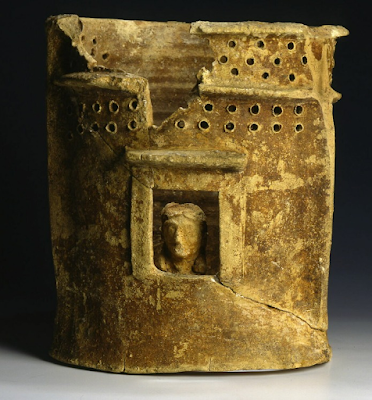 ÎμοίÏμα ιεÏÎ¿Ï Î¼Îµ 'γÏ
ναίκα ÏÏο ÏαÏάθÏ
Ïο' (ÎÏ
ÏÏο - αÏÏÎ±Î¹ÎºÏ 600 - 475 Ï.Χ.) LOUVRE N III 3293 [NOTE5]
ÎμοίÏμα ιεÏÎ¿Ï Î¼Îµ 'γÏ
ναίκα ÏÏο ÏαÏάθÏ
Ïο' (ÎÏ
ÏÏο - αÏÏÎ±Î¹ÎºÏ 600 - 475 Ï.Χ.) LOUVRE N III 3293 [NOTE5]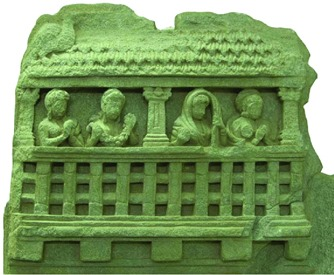 ÎνάγλÏ
Ïο ÏÎ·Ï Butkara I με αÏεικÏνιÏη κÏ
ÏιÏν Ïε θεÏÏείο
ÎνάγλÏ
Ïο ÏÎ·Ï Butkara I με αÏεικÏνιÏη κÏ
ÏιÏν Ïε θεÏÏείοαÏÏÏÏαÏμα αÏÏ Ïο Î ÎÎÎÎÎÎÎÎΣ Î ÎÎÎΤÎΣÎÎΣ ÎÎÎ ÎÎ ÎÎÎÎÎÎÎÎΣ ÎÎ ÎÎΡÎΣÎÎΣ[NOTE7]
ÎÏÏ ÏληθÏÏα ÏεκμηÏίÏν αÏοκαλÏÏÏεÏαι ÏÏι ο εÏιÏκÎÏÏÎ·Ï ÏÏν ÎÎ¿Ï Î´Î¹ÏÏικÏν ιεÏÏν ανÏιμεÏÏÏίζεÏο ÏÏι ÏÏ Î±ÏλÏÏ Î¸ÎµÎ±ÏÎ®Ï Î±Î»Î»Î¬ ÏÏ Î±Ï ÏÏÏÏÎ·Ï Î¼Î¬ÏÏÏ ÏÎ±Ï ÏÏ Î¼Î¼ÎµÏÎÏÏν Ïε μιάν αλληλεÏίδÏαÏη η οÏοία εÏεÏÏγÏανε Ïην ÎνÏαξή ÏÎ¿Ï ÏÏα ÏεκÏαινÏμενα και Ïην αÏοÏελεÏμαÏική καÏήÏηÏή ÏÎ¿Ï ÏÏÎ¹Ï Î½ÎÎµÏ Î¹Î´ÎεÏ.[7_225a1] ÎÏ ÏÏÏ Î¿ ÏÏÏÏÎ¿Ï ÎµÏικοινÏÎ½Î¯Î±Ï Î¼Îµ ÏÎ¿Ï Ï Î®Î´Î· ÏιÏÏοÏÏ ÏÏον και ÏÎ¿Ï Ï ÎµÎ½ Î´Ï Î½Î¬Î¼ÎµÎ¹ είÏε ÏÏ ÏκοÏÏ Ïην αÏοÏελεÏμαÏική Î´Î·Î¼Î¹Î¿Ï Ïγία Î¼Î¹Î¬Ï ÎºÎ¿Î¹Î½ÏÏηÏÎ±Ï ÎµÎ½ÏεÏαγμÎÎ½Î·Ï ÏÏα νÎα ÏιÏÏεÏÏ, Ï ÏήÏξε δε αÏαÏαίÏηÏÎ¿Ï Î¹Î´Î¹Î±Î¯ÏεÏα λÏÎ³Ï ÏÎ·Ï Î±ÏÎ¿Ï ÏÎ¯Î±Ï Î³ÏαÏÏÎ¿Ï Î»ÏÎ³Î¿Ï .O ÏÏολιαζÏÎ¼ÎµÎ½Î¿Ï ÎµÎ´Ï ÏÏÏÎ¿Ï ÏÏοÏλήÏεÏÏ Ï ÏοβάλλεÏαι ιδιαίÏεÏα ÏÏÎ¹Ï Î»ÎµÎ³ÏÎ¼ÎµÎ½ÎµÏ Î±ÏηγημαÏικÎÏ ÏκηνÎÏ ÏÎ¹Ï ÏÏεÏικÎÏ Î¼Îµ Ïην αναÏαÏάÏÏαÏη ÏÎ·Ï Î¶ÏÎ®Ï ÏÎ¿Ï ÎοÏδα. Σε Î±Ï ÏÎÏ ÎµÎ¯Î½Î±Î¹ ÏÏ Î½Î®Î¸Î·Ï Î· αÏεικÏνιÏη θεαÏÏν, ενÏÏÏ Î¸ÎµÏÏείÏν ή εÏί εξÏÏÏη, οι οÏοίοι ÏαÏÎ±ÎºÎ¿Î»Î¿Ï Î¸Î¿Ïν Ïα γεγονÏÏα ÏÏ ÎµÎ¬Î½ ÎµÏ ÏίÏκονÏο οι ίδιοι ÏÏο ÏÏοÏκήνιο και μάλιÏÏα δίÏλα ÏÏον ίδιο Ïον ÎοÏδα.[7_225a2] ΠενεÏγÏÏ ÏÏ Î¼Î¼ÎµÏοÏή ÏÏν θεαÏÏν Ïε κάÏοια ÎµÎ´Ï Ï ÏονοοÏμενη ÏαÏάÏÏαÏη Ï ÏογÏαμμίζεÏαι αÏÏ Ïα κομÏά ενδÏμαÏα και Ïα ÏεÏίÏεÏνα κοÏμήμαÏα ÏÎ¿Ï Î±Ï Ïοί αÏεικονίζονÏαι να ÏÎÏÎ¿Ï Î½, ÎµÎ½Ï Î· Ïκηνή ÏÏ Ïνά διακοÏμείÏαι αÏÏ Î±Î½Ïικείμενα Ï ÏÎ·Î»Î®Ï ÏÎÏÎ½Î·Ï ÏÏÏÏ Î±Î³Î³ÎµÎ¯Î±. Îε λίγα λÏγια η ÏαÏÎ¿Ï Ïία ÏÎ¿Ï âθεαÏή ενÏÏÏ ÏÎ·Ï ÎµÎ¹ÎºÏναÏâ ανÏαÏοκÏίνεÏαι Ïε μιαν οÏÏική ÏÏÏαÏηγική ÏÎ¿Ï ÎµÏιÏειÏεί να Ïον καÏαÏÏήÏει âÎ±Ï ÏÏÏÏη μάÏÏÏ Ïαâ εÏιÏÏ Î³ÏάνονÏÎ±Ï ÎÏÏι Ïην ÏÏνδεÏή ÏÎ¿Ï Î¼Îµ Î±Ï ÏοÏÏ ÏÎ¿Ï ÎµÎºÏÏοÏÏÏοÏνÏαι ÏÏÎ¹Ï Î±ÏηγημαÏικÎÏ ÏκηνÎÏ ÎºÎ±Î¹ Î´Î·Î¼Î¹Î¿Ï ÏγÏνÏÎ±Ï Î¼Î¹Î± νÎα κοινοÏική θÏηÏÎºÎµÏ Ïική κοινÏÏηÏα.
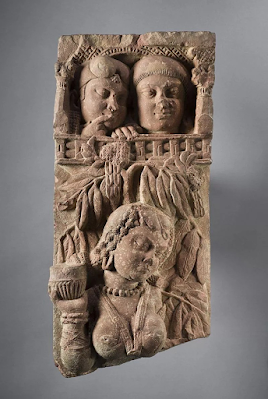 ΠαÏαÏηÏηÏÎÏ Î¸Î±Ï
μάζοÏ
ν ÏÏ
ÏÎ¹ÎºÏ ÏνεÏμα,[20]
ΠαÏαÏηÏηÏÎÏ Î¸Î±Ï
μάζοÏ
ν ÏÏ
ÏÎ¹ÎºÏ ÏνεÏμα,[20] ÎÎΥΠΤΠΤÎÎ¥ Î ÎÎÎ¥ÎÎΤÎΣ YAKSI ÏÏο ÎÎΥΣÎÎÎ LACMA[30]
Το ÏÏ ÏÎ¹ÎºÏ ÏνεÏμα (yaksi) εÏί ÎºÎ¯Î¿Î½Î¿Ï ÎºÎ¹Î³ÎºÎ»Î¹Î´ÏμαÏÎ¿Ï Î±Î½Î®ÎºÎ¿Î½ÏÎ¿Ï ÏÏην ÏÏ Î»Î»Î¿Î³Î® ÏÎ¿Ï ÎÎ¿Ï ÏÎµÎ¯Î¿Ï Î¤ÎÏÎ½Î·Ï ÏÎ·Ï ÎομηÏÎµÎ¯Î±Ï ÏÎ¿Ï ÎÎ¿Ï ÎνÏζελεÏ, Ïο Î±Î½Î¬Î³Î»Ï Ïο Î¼Î¹Î±Ï Î³Ï Î½Î±Î¯ÎºÎ±Ï ÏÎ¿Ï Î¹ÏÏεÏει Î±Î½Î¬Î³Î»Ï Ïο γÏÏÏα (Îικ. 202) και Ïο αναθημαÏÎ¹ÎºÏ Î±Î³Î±Î»Î¼Î±Ïίδιο Î³Ï Î½Î±Î¯ÎºÎ±Ï Î±ÏÏ Ïο Faizabad (Îικ. 203) ανÏιÏÏοÏÏÏεÏÎ¿Ï Î½ ÏαÏαδείγμαÏα Î³Ï Î½Î±Î¹ÎºÎµÎ¯Ïν μοÏÏÏν ÏÎ¿Ï Î±ÏοδίδονÏαι με Ïην Ï ÏηλÏÏεÏη ÏοιÏÏηÏα, Ïιο ολοκληÏÏμÎνη καÏαÏÎºÎµÏ Î®, εÏάμιλλη με Î±Ï Ïή ÏÏν μοÏÏÏν ÏÎ¿Ï ÏÏ Î»Ïνα Kathika. ÎÏοÏοÏν να ÏÏονολογηθοÏν ÏÏα μÎÏα ÎÏÏ Ïα ÏÎλη ÏÎ¿Ï ÏÏÏÏÎ¿Ï Î±Î¹Ïνα Ï.Χ. λÏÎ³Ï ÏÏν Ï ÏολογικÏν ÏαÏακÏηÏιÏÏικÏν ÏÎ¿Ï Ï ÎºÎ±Î¹ ÏÏ Î³ÎºÎ±ÏαλÎγονÏαι μεÏÎ±Î¾Ï Î¼ÎµÏικÏν αÏÏ Ïα καλÏÏεÏα Î³Î»Ï ÏÏά ÏÏην ιÏÏοÏία ÏÎ·Ï ÏÎÏÎ½Î·Ï Mathura.Το θÏαÏÏμα Î¼Î¹Î±Ï ÎºÎ¿Î»ÏÎ½Î±Ï Î±ÏÏ ÎºÎ¹Î³ÎºÎ»Î¯Î´Ïμα ή ÎºÎ¿Ï ÏαÏÏή, ανήκον ÏÏÏα ÏÏην ÏÏ Î»Î»Î¿Î³Î® ÏÎ¿Ï LACMA, αÏεικονίζει μια Î³Ï Î½Î±Î¹ÎºÎµÎ¯Î± μοÏÏή, θÏÎ±Ï ÏμÎνη κάÏÏ Î±ÏÏ Ïο εÏίÏεδο ÏÏν μαÏÏÏν. ΣÏο ÏÎÏι ÏÎ·Ï ÏÎ¿Ï ÏÏζεÏαι κÏαÏά Ïηλά Îνα κÏÏελλο Î¿Î¯Î½Î¿Ï , η μοÏÏή ÏÎ¿Ï Î¿ÏÎ¿Î¯Î¿Ï Î¼ÏοÏεί να ανιÏÎ½ÎµÏ Î¸ÎµÎ¯ ÏÏÎ¹Ï ÎÎÎÎÎÎΣΤÎÎÎΣ ÏηγÎÏ. O Pratapaditya Pal ÏÏÏÏθεÏε ÏÏι Ïο Î±Ï Î»Î±ÎºÏÏÏ ÎºÏÏελλο Î¿Î¯Î½Î¿Ï Î±Î½Î±ÏÎÏεÏαι ÏÏο ÏελεÏÎ¿Ï ÏÎ³Î¹ÎºÏ bakula dohada, καÏά Ïο οÏοίο μια νεαÏή κοÏÎλα Ïεκάζει Ïο δÎνÏÏο bakula με οίνο αÏÏ Ïο ÏÏÏμα ÏÎ·Ï ÏÏοκειμÎÎ½Î¿Ï Î½Î± Î±Ï Î¾Î®Ïει Ïην ικανÏÏηÏά ÏÎ¿Ï Î½Î± αÏοδίδει καÏÏοÏÏ.[39] ΣÏÎκεÏαι κάÏÏ Î±ÏÏ Îνα ανθιÏμÎνο δÎνÏÏο, κάÏι ÏÎ¿Ï Ï ÏοδηλÏνει ÏÏι είναι vrksadeata ή yaksi. ÎÎ½Î±Ï Î¬Î½Î´ÏÎ±Ï ÎºÎ±Î¹ μια Î³Ï Î½Î±Î¯ÎºÎ± Ïην κοιÏÎ¬Î¶Î¿Ï Î½ με αÏοÏία και ÎκÏληξη ÏÎ¬Î½Ï Î±ÏÏ Ïο κιγκλίδÏμα (Îικ. 200).[40] ΠεικÏνα ÏÏο ÏÏÎ½Î¿Î»Ï ÏÎ·Ï Î±Î½Î±ÏÎÏεÏαι ÏÏην ομοÏÏιά ÏÎ·Ï Î±ÏÎ¸Î¿Î½Î¯Î±Ï ÎºÎ±Î¹ ÏÎ·Ï ÏαÏαγÏγικÏÏηÏÎ±Ï ÏÏμÏÏνα με ÏÎ¹Ï Î±ÏÏÎÏ ÏÎ·Ï ÎºÎ¿ÏÎ¼Î¿Î»Î¿Î³Î¯Î±Ï ÏÎ¿Ï ÏδαÏοÏ, ÏÎ·Ï Î¿ÏÎ¿Î¯Î±Ï Î¿Î¹ εικÏÎ½ÎµÏ Î³ÎμιÏαν ÏÎ¿Ï Ï ÎµÎ¾ÏÏεÏικοÏÏ ÏÏÏÎ¿Ï Ï ÏÏν ιεÏÏν μνημείÏν ÏÎ·Ï ÏαÏαδοÏÎ¹Î±ÎºÎ®Ï ÎνδίαÏ.Το ÏνεÏμα yaksi ÏÏÎκεÏαι Ï ÏÏ Î³Ïνία ÏÏ ÏÏÎ¿Ï Ïον θεαÏή, με Ïο κεÏάλι ÏÎ·Ï Î½Î± γÎÏνει αÏαλά ÏÏÎ¿Ï Ïην μία ÏÎ»ÎµÏ Ïά, ÏÏÏÏ Î· ανδÏική μοÏÏή ÏÏον ÏÏ Î»Ïνα κολÏνα Kathika (Îικ. 188), μια ÏÏάÏη ÏÎ¿Ï ÏαίνεÏαι να ήÏαν δημοÏÎ¹Î»Î®Ï Î±Ï Ïήν Ïην ÏεÏίοδο. ΠμοÏÏή ÏÎ·Ï Î´Î¹Î±ÏοÏίζεÏαι αÏÏ Î¼Î¹Î± αίÏθηÏη ναÏÎ¿Ï ÏαλιÏÎ¼Î¿Ï ÎµÎ¼ÏανοÏÏ ÏÏην αÏαλÎÏ ÎºÎ±Î¼ÏÏλεÏ, ÏÏÎ¿Ï Ï ÏÏÎ±Î¯Î¿Ï Ï ÏÎ³ÎºÎ¿Ï Ï ÏÏν Î¼Î¬Î³Î¿Ï Î»Ïν και ÏÎ¿Ï ÏÏÎ®Î¸Î¿Ï Ï ÏÎ·Ï ÎºÎ±Î¹ Ïε λεÏÏομÎÏÎµÎ¹ÎµÏ ÏÏÏÏ Î· ελαÏÏιά αιÏÏηÏη ÏÎ¿Ï ÏÏÎ¿Î»Î¹Î´Î¹Î¿Ï Î¼Î±Î»Î»Î¹Ïν ÏÎ¬Î½Ï Î±ÏÏ Ïο μÎÏÏÏÏ ÏÎ·Ï ÏÏ Î±ÏάνÏηÏη ÏÏην κλίÏη ÏÎ¿Ï ÎºÎµÏÎ±Î»Î¹Î¿Ï ÏηÏ. Τα ÏαÏακÏηÏιÏÏικά ÏÎ¿Ï ÏÏοÏÏÏÎ¿Ï ÏÎ·Ï ..
ΣÎÎÎÎΩΣÎÎΣ[NOTE0]. Openwork furniture plaque with a "woman at the window", ca. 8th century B.C., MET 59.107.18.[NOTE1]. Yair Zakovitch 2019, p. 55.[NOTE5]. https://collections.louvre.fr/en/ark:.... ÎονιδάÏÎ·Ï Î. Ï ÏÏ Îκδ.[7_225a1]. ÎÎ´Ï Î³Î¯Î½ÎµÏαι αναÏοÏά ÏÏην θεÏÏία ÏÎ·Ï ÏÏοÏλήÏεÏÏ - διανοηÏÎ¹ÎºÎ®Ï ÎºÎ±Î¹ ÏÏ Î½Î±Î¹ÏθημαÏÎ¹ÎºÎ®Ï - ÏÎ¿Ï ÎºÎ±Î»Î»Î¹ÏεÏÎ½Î¹ÎºÎ¿Ï ÎÏÎ³Î¿Ï (Rezeptionsästhetik), βλ. Penzel 2020.[7_225a2]. Galli 2011, pp. 321-323, nn. 83, 84.[20] Onlookers admiring a Yakshi, Mathura, India, 20 BCE, <https://collections.lacma.org/node/24.... Sonya Rhie Quintanilla 2007, p. 160.
ÎÎÎÎÎÎÎΡÎΦÎÎ
https://books.google.gr/books?id=Azhs...
Yair Zakovitch. 2019. The Song of Songs: Riddle of Riddles, London.
https://journals.openedition.org/cchy..., B. 2016. Maquettes antiques dâOrient. De lâimage au symbole, Picard, Paris, 2016, 296 pages, XIII pl., 176 figures, index, glossaire. ISBN 978-2-7084-1012-1Cahiers du Centre dâÃtudes Chypriotes, 47 | 2017, 344-346
https://www.academia.edu/44434211/MUL..., B. 2014. "'Architectural models' of the Near-East and Eastern Mediterranean: a Global Approach Introduction (Neolithic-Ist millenium BC) ," in Proceedings of the 8th ICAANE, ed. P. Bielinski, M. Gawlikowski, R. Kolinski, D. Lawecka, A. Soltysiak, Z. Wygnanska, pp. 123-149.
https://books.google.gr/books?id=rtqv... Rhie Quintanilla. 2007. History of Early Stone Sculpture at Mathura: Ca. 150 BCE - 100 CE, Bosten / Leyden.
ÎονιδάÏÎ·Ï Î. Ï ÏÏ Îκδ. Î ÎινεζικÏÏ ÏολιÏιÏμÏ; και οι ÎλλαδικÎÏ ÎµÏιδÏάÏειÏ, Îθήνα.
Î ÎÎÎΠΠΡÎÎΦÎΤÎΣ ÎÎÎ ÎÎΥΤÎΣÎÎΣ - ÎÎ ÎÎÎÎÎÎÎ: 070622
May 29, 2022
THE HITTITES AND THE AEGEAN WORLD, ed. 2022
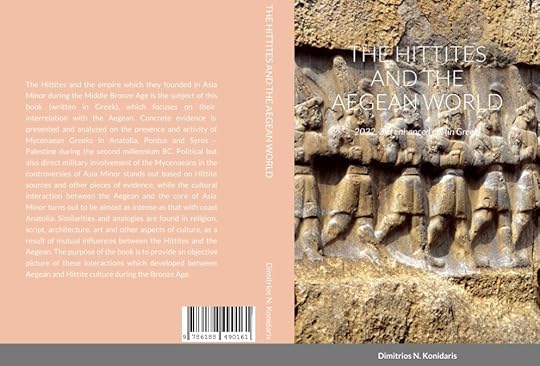
ISBN 978-618-84901-6-1Î ÎÎÎÎÎΣ Î ÎΡÎÎΧÎÎÎÎΩΠΣÏνοÏη ..................................................................................................................................x ΠΡΩΤΠÎÎÎΤÎΤΠ............................................................................................................ 1 1. Î âÎ±Î½Î±ÎºÎ¬Î»Ï Ïηâ ÏÏν ΧεÏÏαίÏν, οι ÏηγÎÏ.......................................................................1 ÎÎΥΤÎΡΠÎÎÎΤÎΤΠ.......................................................................................................3 2. Î âÏ ÏεÏÏονιÏμÏÏâ ÏÎ¿Ï ÎÎ»Î»Î·Î½Î¹ÎºÎ¿Ï Î Î±ÏάγονÏα ÏÏην ÎÏμηνεία ÏÎ¿Ï ÎÏÏοÏÎ¹ÎºÎ¿Ï Î Î±ÏελθÏνÏÎ¿Ï ........................................................................................................................3 ΤΡÎΤΠÎÎÎΤÎΤÎ.............................................................................................................. 3. ÎÏηÏÏÏληÏαν οι ÎÏ ÎºÎ·Î½Î±Î¯Î¿Î¹ Ïο ενδιαÏÎÏον ÏÏν ΧεÏÏαίÏν;......................................9 ΤÎΤÎΡΤΠÎÎÎΤÎΤÎ..................................................................................................... 4. Îξ ÎναÏολÏν Ïο ΦÏÏ; ................................................................................................... 13 Î ÎÎΠΤΠÎÎÎΤÎΤÎ...................................................................................................... 5. Îι ΧεÏÏαίοι: ÏÏνÏομη ÏÏνοÏη...................................................................................... 17 5.1 ÎλÏÏÏα - ΠολιÏική .................................................................................................17 5.2 ÎÏηÏκεία................................................................................................................ 20 5.3 ÎνÏιλήÏÎµÎ¹Ï Î³Î¹Î± Ïον θάναÏο...................................................................................23 5.4 ÎεÏÎ±Î»Î»Î¿Ï Ïγία....................................................................................................... 28 ÎÎΤΠÎÎÎΤÎΤÎ............................................................................................................ 6. ÎνÏÏιζαν οι ÎÎ»Î»Î·Î½ÎµÏ ÏÎ¿Ï Ï Î§ÎµÏÏÎ±Î¯Î¿Ï Ï;....................................................................... 30 6.1 Îιγαίο και Î ÏνÏοÏ................................................................................................... 31 6.2 Îιλικική âÎÏαÎαâ - Que..........................................................................................33 6.3 ÎνομαÏικÎÏ ÎºÎ±Î¹ Î¬Î»Î»ÎµÏ Î±Î½Î±ÏοÏÎÏ.........................................................................37 6.4 ΣÏÏλια..................................................................................................................... 38 ÎÎÎÎÎÎ ÎÎÎΤÎΤÎ..................................................................................................... 40 7. Îι ÎλλαδίÏÎµÏ ÎºÎ±Î¹ η Î. ÎÏία ....................................................................................... 40 7.1 ÎÏ ÎºÎ»Î±Î´Î¯ÏÎµÏ â ÎινÏίÏÎµÏ - ÎÏ ÎºÎ·Î½Î±Î¯Î¿Î¹ και η ÏαÏάλια Î. ÎÏία........................ 42 vii 7.1.1 ÎίληÏÎ¿Ï ........................................................................................................... 42 7.1.2 ÎολοÏÏν (Müsgebi)..................................................................................... 45 7.1.3 ÎενεμÎνη (Panaztepe)................................................................................ 45 7.1.4 ÎαÏÏÏ................................................................................................................ 46 7.1.5 ΤÏεÏμÎÏ........................................................................................................... 47 7.1.6 ÎνίδοÏ.............................................................................................................. 48 7.1.7 ΤÏοία................................................................................................................ 48 7.1.8 ÎÏεÏοÏ............................................................................................................ 50 7.1.9 ÎÎγαÏÏÎ¿Ï ........................................................................................................ 51 7.1.10 ÎλαζομενÎÏ .................................................................................................... 51 7.1.11 Îιλικία .............................................................................................................53 7.2 Îι Îιγαίοι και η ÎικÏαÏιαÏική ενδοÏÏÏα .........................................................55 7.2.1 ΧαÏοÏÏα ...........................................................................................................55 7.2.2 ÎÏ Ïική ÎναÏολία â ÎÏÎ¾ÎµÎ¹Î½Î¿Ï Î ÏνÏÎ¿Ï ..........................................................61 7.2.3 ÎναÏολική ÎναÏολία â AliÅar..................................................................... 65 7.3 Î£Ï Î¼ÏεÏαÏμαÏικά ÏÏÏλια......................................................................................66 ÎÎÎÎÎ ÎÎÎΤÎΤÎ......................................................................................................... 70 8. Î ÏαÏÎ¿Ï Ïία ÏÏν ÎλλαδιÏÏν ÏÏην Î£Ï Ïο -ΠαλαιÏÏίνη............................................. 70 8.1 Îι αÏαÏÏÎÏ ÏÎ·Ï ÎÎ¹Î³Î±Î¹Î±ÎºÎ®Ï ÏαÏÎ¿Ï ÏίαÏ............................................................... 70 8.2 Ugarit...................................................................................................................... 76 8.3. Gezer ..................................................................................................................... 778.4 Tell Arad (Negev)................................................................................................80 8.5 Kumidi (Kamid el-Loz) .....................................................................................80 8.6 ÎινÏικÎÏ ÏοιÏογÏαÏίεÏ........................................................................................ 82 8.7 ΦιλιÏÏαÏκή μεÏανάÏÏÎµÏ Ïη................................................................................... 84 8.8 Îιγαιακά κÏαÏίδια ÏÏην Î£Ï Ïο â ΠαλαιÏÏίνη ................................................... 86 8.9 Îι ΦιλιÏÏαίοι καÏά Ïην Î¥ÎΧ............................................................................... 92 8.10 Îι Î¦Î¿Î¯Î½Î¹ÎºÎµÏ ÎºÎ±Î¹ Ïο Îιγαίο.................................................................................. 95 8.10.2 Acco ή ÎκÏÏ ............................................................................................... 96 8.10.1 Arwad ή ÎÏÎ±Î´Î¿Ï (ÎÏάδην)........................................................................ 98 8.10.3 Tell Abu Hawam........................................................................................ 98 8.10.4 ΣιδÏν.................................................................................................................. 99 8.10.5 ÎÏβλοÏ.........................................................................................................102 8.10.6 ΣάÏεÏÏα (Sarepta)....................................................................................106 8.10.7 ÎαÏαληκÏικά ÏÏÏλια.................................................................................106 8.11 ΣÏνοÏη..................................................................................................................108 viii ÎÎÎÎΤΠÎÎÎΤÎΤÎ.......................................................................................................111 9. Îι Îιγαίοι και η ÎÏ ÏÏÏη καÏά Ïην ÎÏοÏή ÏÎ¿Ï Î§Î±Î»ÎºÎ¿Ï: αÏÏ Ïον μÏθο ÏÏην (ÏÏο)ιÏÏοÏία.......................................................................................................................111 9.1 ÎβηÏική .................................................................................................................... 111 9.2 ÎαÏÏιÏεÏÎ¯Î´ÎµÏ ÎήÏοι..............................................................................................119 9.3 Σκανδιναβία ..........................................................................................................125 9.4 ÎενÏÏική ÎÏ ÏÏÏη ................................................................................................127 9.5 MαÏÏη ÎάλαÏÏα (ÏÏÏÏθεÏα ÏÏοιÏεία)............................................................132 9.6 Î ÎÏÏική ιδεολογία και η ÎÏ ÏÏÏαÏκή Îοινή ÎγοÏά ÏÎ·Ï ÎÏοÏÎ®Ï ÏÎ¿Ï Î§Î±Î»ÎºÎ¿Ï .........................................................................................................................135 9.7 Ex Oriente lux ενανÏίον Ex Occidente lux: κοινÏÏ ÏαÏονομαÏÏήÏ............138 ÎÎÎÎΤΠÎÎÎΤÎΤΠ.....................................................................................................149 10. ÎÏαÏή ..........................................................................................................................149 10.1 ÎιγαιακÎÏ Î³ÏαÏÎÏ...............................................................................................149 10.2 ΧεÏÏιÏική γÏαÏή.................................................................................................157 10.3 ΧεÏÏιÏική ÏÏÏÎ±Î³Î¹Î´Î¿Î³Î»Ï Ïία ..............................................................................160 10.4 ΠΤαÏκÏνδημοÏ, ο αÏοδιοÏομÏÎ±Î¯Î¿Ï ÏÏÎ¬Î³Î¿Ï ÎºÎ±Î¹ η Îλληνική ÏκÎÏη ..........164 10.4.1 Î ÏελεÏÎ¿Ï Ïγία ÏÎ¿Ï Î±ÏοδιοÏομÏÎ±Î¯Î¿Ï ÏÏÎ¬Î³Î¿Ï .........................................168 ÎÎÎÎÎÎΤΠÎÎÎΤÎΤÎ................................................................................................ 177 11. ÎÏ ÎºÎ¯Î± â Îιλικία: ÏεÏιÏÎÏεια ÏÏν ΧεÏÏαίÏν ή ενδιάμεÏη ÏεÏιοÏή;..................... 177 11.1 ÎÏ ÎºÎ¯Î±......................................................................................................................17711.2 Kizzuwatna .........................................................................................................179 11.3 TarhuntaÅ¡Å¡a .........................................................................................................181 ÎΩÎÎÎÎΤΠÎÎÎΤÎΤÎ...............................................................................................185 12. ÎÎ¾ÎµÎ¹Î´Î¹ÎºÎµÏ Î¼Îνοι εÏαγγελμαÏÎ¯ÎµÏ (η ÏεÏίÏÏÏÏη ÏÏν θεÏαÏÎµÏ ÏÏν)......................185 ÎÎÎÎΤΠΤΡÎΤΠÎÎÎΤÎΤÎ........................................................................................187 13. ÎμοιÏÏηÏÎµÏ Î¼ÎµÏÎ±Î¾Ï ÎÎ»Î»Î±Î´Î¹ÎºÎ®Ï ÎºÎ±Î¹ ΧεÏÏιÏÎ¹ÎºÎ®Ï Î¿Î¹ÎºÎ¿Î´Î¿Î¼Î¹ÎºÎ®Ï ÎºÎ±Î¹ αÏÏιÏεκÏÎ¿Î½Î¹ÎºÎ®Ï ............................................................................................................................................187 ÎÎÎÎΤΠΤÎΤÎΡΤΠÎÎÎΤÎΤÎ.................................................................................193 14. ΣÏολιαÏμÏÏ ÏÏιÏμÎνÏν θεÏÏοÏμενÏν ÏÏ Î§ÎµÏÏιÏικÏν ÎÏγÏν ÏÎÏνηÏ.................193 14.1 Îενικά....................................................................................................................193 14.2 Î Î ÏÏÏÎ¼Î¿Ï âΧÏÏ ÏοÏÏ ÎιÏνâ ÏÎ·Ï ÏÏίÏÎ·Ï ÏιλιεÏÎ¯Î±Ï ÎºÎ±Î¹ η ÎÎÏη ÎÏοÏή ÏÎ¿Ï Î§Î±Î»ÎºÎ¿Ï .........................................................................................................................194 14.3 Alaca Hüyük......................................................................................................200 14.4 ÎεÏαμεικά Îγγεία.............................................................................................202 14.4.1 ÎάνθαÏοι......................................................................................................204 14.4.2 ÎÏÏÏαÏ........................................................................................................205 14.5 Î¡Ï ÏÏ ÏάÏÎ¿Ï IV ÎÏ ÎºÎ·Î½Ïν..................................................................................208 14.6 ΠθεÏÏ ÏÎ·Ï ÎºÎ±ÏαιγίδαÏ.......................................................................................212 14.7 Î¡Ï ÏÏ Schimmel .................................................................................................. 213 14.8 ΣÏίγγεÏ................................................................................................................218 14.9 ÎÏÏληξη â λαβή ÏκήÏÏÏÎ¿Ï Î±ÏÏ Ïα Îάλια .................................................. 222 14.10 ÎαÏαληκÏικά ΣÏÏλια ...................................................................................... 223 ÎÎÎÎΤΠΠÎÎΠΤΠÎÎÎΤÎΤΠ................................................................................ 229 15. Î£Ï Î¼ÏεÏάÏμαÏα.......................................................................................................... 229 ΣÎÎÎÎΩΣÎÎΣ ................................................................................................................ 239 ÎÎÎÎÎÎÎΡÎΦÎÎ..............................................................................................................337 ÎÎÎÎÎÎΣ ........................................................................................................................460 ΣΥÎΤÎÎÎÎΡÎΦÎÎΣ.................................................................................................... 472 ÎΥΡÎΤÎΡÎÎ ÎÎÎÎÎΤΩÎ......................................................................................... 474
ΣÏνοÏη ΠκαθηγηÏÎ®Ï Muhly* δημοÏÎ¯ÎµÏ Ïε Ïo 1974 άÏθÏο με ÏίÏλο âThe Hittites and the Aegean Worldâ, ÏÏο ÏεÏÎ¹Î¿Î´Î¹ÎºÏ Expedition ÏÎ¿Ï ÎÎ¿Ï ÏÎµÎ¯Î¿Ï ÎÏÏÎ±Î¹Î¿Î»Î¿Î³Î¯Î±Ï ÎºÎ±Î¹ ÎνθÏÏÏÎ¿Î»Î¿Î³Î¯Î±Ï ÏÎ·Ï Pennsylvania, ÏÏÎ¿Ï ÏÏÏε ήÏαν εÏÎ¯ÎºÎ¿Ï ÏÎ¿Ï ÎºÎ±Î¸Î·Î³Î·ÏήÏ. Το άÏθÏο αναÏÎÏεÏαι ÏÏην ΧεÏÏιÏική Î±Ï ÏοκÏαÏοÏία, μία ÏÏν μεγάλÏν Î´Ï Î½Î¬Î¼ÎµÏν ÏÎ·Ï ÏεÏιÏÎ´Î¿Ï 1700-1200 Ï.Χ., ÏμÏÏ Î±Î½ÏιμεÏÏÏίζει Ïην ιÏÏοÏική και ÏολιÏιÏÏική ÏαÏÎ¿Ï Ïία ÏÏν ÎιγαίÏν ÏÎ·Ï ÎÏοÏÎ®Ï ÏÎ¿Ï Î§Î±Î»ÎºÎ¿Ï Î¼Îµ Ï ÏοÏιμηÏÎ¹ÎºÏ ÏÏÏÏο, ο οÏÎ¿Î¯Î¿Ï Î´ÎµÎ½ ÏÏ Î½Î¬Î´ÎµÎ¹ με Ïην αÏÏαιολογική και ιÏÏοÏική ÏÏαγμαÏικÏÏηÏα. Îι Ï ÏοÏÏηÏιζÏÎ¼ÎµÎ½ÎµÏ ÏÏο άÏθÏο αÏÏÏÎµÎ¹Ï ÎµÎ½ÏάÏÏονÏαι ÏÏο ÏεÏμα ÏÏν ÎναÏολιÏÏÏν, ήÏοι εκείνÏν οι οÏοίοι Ï ÏοÏÏηÏÎ¯Î¶Î¿Ï Î½ Ïο δÏγμα ÏÎ·Ï Î±ÏÏ Î±Î½Î±ÏολÏν ÏÏοελεÏÏεÏÏ ÎºÎ±Î¹ διαδÏÏεÏÏ ÏÎ¿Ï ÏολιÏιÏÎ¼Î¿Ï (ex oriente lux). Î ÏαÏοÏÏα εÏγαÏία ÏÏοÎÎºÏ Ïε αÏÏ Ïην ÏÏοÏÏάθεια αναÏÎºÎµÏ Î®Ï ÏÎ¿Ï ÏαÏαÏÎ¬Î½Ï Î¬ÏθÏÎ¿Ï , ÏμÏÏ Î±Î½ÎµÏÏÏÏθη ÏεÏαιÏÎÏÏ Î¼Îµ ÏκοÏÏ Î½Î± καλÏÏει ÏÏÏÏθεÏÎµÏ ÏÎ»ÎµÏ ÏÎÏ ÏÎ¿Ï Î¯Î´Î¹Î¿Ï Î¸ÎµÎ¼Î±ÏÎ¹ÎºÎ¿Ï ÏÏ Ïήνα. ÎÏÏι ÏεÏιλαμβάνει αναÏκÏÏηÏη ÏÎ·Ï ÏÏεÏÎ¹ÎºÎ®Ï Î²Î¹Î²Î»Î¹Î¿Î³ÏαÏίαÏ, ανάδειξη ÏÏοιÏείÏν και εÏÎ¼Î·Î½ÎµÏ ÏικÏν ÏÏημάÏÏν Ïα οÏοία δεν ÎÏÎ¿Ï Î½ ÏÏοβληθεί εÏαÏκÏÏ Î® δεν είναι καλÏÏ Î³Î½ÏÏÏά, ενÏ, Ïε κάÏÎ¿Î¹ÎµÏ ÏεÏιÏÏÏÏειÏ, αÏοÏειÏάÏαι να ÏαÏάÏÏει μια νÎα εÏμηνεία â ÏÏοÏÎγγιÏη ÏÏν εγειÏÏμενÏν θεμάÏÏν. Îι ΧεÏÏαίοι, εμÏανιÏθÎνÏÎµÏ Î±Î¹ÏνιδίÏÏ ÏÏο ιÏÏοÏÎ¹ÎºÏ ÏÏοÏκήνιο καÏά Ïην ÎÎÏη ÎÏοÏή ÏÎ¿Ï Î§Î±Î»ÎºÎ¿Ï, δημιοÏÏγηÏαν μιά ιÏÏÏ Ïή Î±Ï ÏοκÏαÏοÏία με ÏÏ Ïήνα Ïην κενÏÏική ÎικÏά ÎÏία, η δε ÎºÏ ÏιαÏÏία και εÏιÏÏοή ÏÎ¿Ï Ï ÎºÎ±Ïά ÏεÏιÏÎ´Î¿Ï Ï ÎµÏεκÏείνεÏο και άλλοÏε ÏÏ ÏÏικνοÏÏο ÏÏην κενÏÏική και αναÏολική ÎναÏολία. ÎνÎÏÏÏ Î¾Î±Î½ Îνα αξιÏλογο ÏÏÏÏημα διοικήÏεÏÏ ÎºÎ±Î¹ γÏαÏειοκÏαÏίαÏ, καÏά ÏεÏιÏÎ´Î¿Ï Ï Î´Îµ αÏκοÏÏαν Î±Ï Î¾Î·Î¼Îνη εÏιÏÏοή Ïε μια ÏειÏά Ï ÏοÏελÏν κÏαÏιδίÏν ÏÎ·Ï ÎµÏ ÏÏÏεÏÎ·Ï ÏεÏιοÏήÏ. Î Î±Ï ÏοκÏαÏοÏία ÏÏ Î½Î±ÏοÏελείÏο αÏÏ Îνα μÏÏαÏÎºÏ ÏÏ Î»ÎµÏικÏν και ÏοÏικιÏÏικÏν κοινοÏήÏÏν, οι οÏÎ¿Î¯ÎµÏ Î¿Î¼Î¹Î»Î¿ÏÏαν διάÏοÏÎµÏ Î³Î»ÏÏÏÎµÏ ÎºÎ±Î¹ ενεÏάνιζαν ÏημανÏική ÏολιÏιÏÏική διαÏοÏοÏοίηÏη. ΣÏα ÏλαίÏια ÏÎ·Ï ÎµÏγαÏÎ¯Î±Ï Î³Î¯Î½ÎµÏαι καÏâ αÏÏήν αναÏοÏά ÏÏα ίÏνη ÏÏν ÎιγαίÏν ÏÏον Î ÏνÏο, Ïην ÏαÏάλια αλλά και Ïην ηÏειÏÏÏική ÎικÏά ÎÏία, ήδη ÏÏίν xi Ïην εμÏάνιÏη ÏÏν ΧεÏÏαίÏν. ÎδιαίÏεÏα αναÏÏÏÏÏονÏαι ÏÏοιÏεία ÏÏεÏικά με Ïην ÏαÏÎ¿Ï Ïία και δÏαÏÏηÏιοÏοίηÏη ÏÏν ÎλλαδιÏÏν ÏÏÎ¹Ï Î±ÎºÏÎÏ ÏÎ·Ï ÎναÏÎ¿Î»Î¯Î±Ï ÎºÎ±Î¹ Ïην Î£Ï Ïο â ΠαλαιÏÏίνη καÏά Ïην δεÏÏεÏη ÏιλιεÏία ÏÏίν αÏÏ Ïην εÏοÏή μαÏ, ÎµÎ½Ï Î³Î¯Î½ÎµÏαι εÏίÏÎ·Ï Î±Î½Î±ÏοÏά ÏÏην εÏίδÏαÏη ÏÎ¿Ï ÎÎ¹Î³Î±Î¯Î¿Ï ÏÏην Î±Î½Î¬Î´Ï Ïη ÏÎ·Ï ÎÏοÏÎ®Ï ÏÎ¿Ï Î§Î±Î»ÎºÎ¿Ï ÏÏην ÎÏ ÏÏÏη. Î ÏολιÏική αλλά και άμεÏη ÏÏÏαÏιÏÏική εμÏλοκή ÏÏν ÎÏ ÎºÎ·Î½Î±Î¯Ïν ÏÏÎ¹Ï Î±Î½ÏιÏαÏαθÎÏÎµÎ¹Ï ÏÎ·Ï ÎικÏÎ¬Ï ÎÏÎ¯Î±Ï Î±Î½Î±Î´ÎµÎ¹ÎºÎ½ÏεÏαι με βάÏη ΧεÏÏιÏικÎÏ Î³ÏαÏÏÎÏ ÏηγÎÏ ÎºÎ±Î¹ λοιÏά ÏεκμήÏια, ÎµÎ½Ï Î· ÏολιÏιÏÏική αλληλεÏίδÏαÏη μεÏÎ±Î¾Ï ÏÎ¿Ï ÎÎ¹Î³Î±Î¹Î±ÎºÎ¿Ï ÏÏÏÎ¿Ï ÎºÎ±Î¹ ÏÎ¿Ï ÏÏ ÏÎ®Î½Î¿Ï ÏÎ·Ï ÎικÏÎ¬Ï ÎÏÎ¯Î±Ï Î±ÏοδεικνÏεÏαι ÏÏι ολίγον μÏνον Ï ÏολειÏÏÏαν Î±Ï ÏÎ®Ï Î¼Îµ Ïην ÏαÏάλια ÎναÏολία.. ÎδιαίÏεÏα ÏÏολιάζονÏαι καλλιÏεÏνικά ÎÏγα Ïα οÏοία ÏÏ Î½Î®Î¸ÏÏ Î±ÏοδίδονÏαι ή, ÎÏÏÏ, ÏÏ ÏÏεÏίζονÏαι με ÏÎ¿Ï Ï Î§ÎµÏÏÎ±Î¯Î¿Ï Ï, ÏαÏÎÏονÏαι δε ÏÏοιÏεία Ïα οÏοία Ïε Î¬Î»Î»ÎµÏ ÏεÏιÏÏÏÏÎµÎ¹Ï Î±Î½Î±ÏÏÎÏÎ¿Ï Î½ Ïην καθιεÏÏμÎνη άÏοÏη, Ïε Î¬Î»Î»ÎµÏ Î´Îµ ενÏοÏÎ¯Î¶Î¿Ï Î½ και Ï ÏογÏÎ±Î¼Î¼Î¯Î¶Î¿Ï Î½ Ïην ÏÏαÏξη Ïε Î±Ï Ïά ÎιγαιακÏν ÏÏοιÏείÏν Ïα οÏοία ÎÏÎ¿Ï Î½ αÏοÏιÏÏηθεί! ÎκÏιμάÏαι ÏÏι η ÏÏ Î½Î¿ÏÏική Î±Ï Ïή Î±Î½Î¬Î»Ï Ïη ÏαÏÎÏει μια ÏεÏιÏÏÏÏεÏον ολοκληÏÏμÎνη και ανÏικειμενική εικÏνα ÏÎ¿Ï ÎÎ»Î»Î±Î´Î¹ÎºÎ¿Ï ÏολιÏιÏμοÏ, ÏÎ·Ï Î¸ÎÏεÏÏ ÏÎ¿Ï ÏÏον κÏÏμο ÏÎ·Ï ÎÏοÏÎ®Ï ÏÎ¿Ï Î§Î±Î»ÎºÎ¿Ï ÎºÎ±Î¹ ÏÏν εÏιÏÏοÏν ÏÎ¿Ï Î±Ï ÏÏÏ Î¬ÏκηÏε εÏί ÏÎ¿Ï Î§ÎµÏÏιÏικοÏ, ÏÏÏÏ ÎºÎ±Î¹ ÏÏν εÏιδÏάÏεÏν ÏÎ¹Ï Î¿ÏÎ¿Î¯ÎµÏ ÎµÎ´ÎÏθη αÏÏ Î±Ï ÏÏν. Σε ÏÏÏιÏÏÎÏ ÎµÏγαÏίεÏ, αλλά ÏÏα ÏλαίÏια ÏÎ·Ï Î¯Î´Î¹Î±Ï ÏειÏάÏ, αναλÏονÏαι οι άλλοι μεγάλοι ÏολιÏιÏμοί ÏÎ·Ï ÎµÏοÏήÏ: ο ÏολιÏιÏμÏÏ ÏÎ·Ï ÎακÏÏÎ¯Î±Ï â ÎαÏγιανήÏ, ÏÎ·Ï ÎºÎ¿Î¹Î»Î¬Î´Î±Ï ÏÎ¿Ï ÎνδοÏ, ο ÎÎ¹Î³Ï ÏÏιακÏÏ ÎºÎ±Î¹ ο ÎινεζικÏÏ, ÏάνÏα εν ÏÏÎÏει με ÏÎ¹Ï ÎλλαδικÎÏ ÎµÏιδÏάÏειÏ. ÎλÏίζεÏαι ÏÏι ÏαÏÎÏεÏαι ÎÏÏι μια ÏληÏÎÏÏεÏη εικÏνα ÏÎ¿Ï ÏολιÏιÏÎ¼Î¿Ï ÏÎ¿Ï ÎÎ¹Î³Î±Î¯Î¿Ï ÎºÎ±Î¹ ÏÏν ÏÏÎÏεÏν ÏÎ¿Ï Î¼Îµ ÏÎ¿Ï Ï Î¬Î»Î»Î¿Ï Ï Î¼ÎµÎ³Î¬Î»Î¿Ï Ï ÏÏγÏÏÎ¿Î½Î¿Ï Ï ÏολιÏιÏμοÏÏ ÏÎ·Ï ÎÏοÏÎ®Ï ÏÎ¿Ï Î§Î±Î»ÎºÎ¿Ï, αÏηλλαγμÎνη - ÏÏο μÎÏÏο ÏÎ¿Ï Î´Ï Î½Î±ÏÎ¿Ï - αÏÏ ÏÏοκαÏαλήÏÎµÎ¹Ï ÎºÎ±Î¹ ιδεοληÏίεÏ.
May 17, 2022
EARLY EGYPTIAN CIVILISATION AND ITS AEGEAN AFFINITIES
ΠΠΡΩÎÎÎΣ ÎÎÎΥΠΤÎÎÎÎΣ Î ÎÎÎΤÎΣÎÎΣ ÎÎÎ ÎÎ ÎÎÎÎÎÎÎ ÎÎΡÎΣÎÎΣ ÎΠΤΠÎÎÎÎÎÎ
βâ εÏÎ·Ï Î¾Î·Î¼Îνη ÎκδοÏη
[image error]
https://archiv.ub.uni-heidelberg.de/propylaeumdok/5337/
May 11, 2022
Marsia, Platone, Dante, Giovanni di Paolo: alcune considerazioni in merito ad una miniatura dantesca, Giulio Coppola
ÎÏ Ïή είναι η ÏεÏίÏημη ανÏίθεÏη μεÏÎ±Î¾Ï ÏÏν Î±Ï Î»Î·ÏÏν (ανÏιÏÏοÏÏÏÎµÏ Î¿Î¼ÎνÏν αÏÏ Ïον ÎαÏÏÏα) και ÏÏν κιθαÏÏδÏν (Ï ÏÏ Ïην αιγίδα ÏÎ¿Ï ÎÏÏλλÏνοÏ), μια διαλεκÏική ÏÎ¿Ï ÎµÎ½ÏάÏÏεÏαι ÏÏον ÎµÎ»Î»Î·Î½Î¹ÎºÏ ÏÏοβλημαÏιÏÎ¼Ï Î³Î¹Î± Ïα αÏοÏελÎÏμαÏα ÏÎ¿Ï ÏÏοκαλεί η Î¼Î¿Ï Ïική ÏÏην ÏÏ Ïή ÏÎ¿Ï Î±ÎºÏοαÏή. ΣÏο ÏκεÏÏÎ¹ÎºÏ ÏÎ¿Ï ÏÏηÏίζει ο ΣÏκÏάÏÎ·Ï ÏÏην ΠολιÏεία,[35] αÏÎ¿Ï ÎµÎ¾ÎÏαÏε ÏÎ¿Ï Ï Î´Î¹Î¬ÏοÏÎ¿Ï Ï ÏÏÏÎ¿Ï Ï á¼ÏÎ¼Î¿Î½Î¯Î±Ï (Î¼ÎµÎ¹Î¾Î¿Î»Ï Î´Î¹ÎºÎ®, ÏÏ Î½ÏÎ¿Î½Î¿Î»Ï Î´Î¹ÎºÎ®, ιÏνική, Î»Ï Î´Î¹ÎºÎ® κ.λÏ.) με ÏÎ¹Ï ÏÏεÏικÎÏ ÏÏ Î½ÎÏÎµÎ¹ÎµÏ ÏÏÎ¿Ï Ï Î±ÎºÏοαÏÎÏ, αÏαγοÏεÏεÏαι η ÏÏÏÏβαÏη ÏÏην ιδανική ÏÏλη Ïε οικοδÏÎ¼Î¿Ï Ï ÎºÎ±Î¹ ÏλογÎÏαÏ. ÏÏÏÏ ÎµÎ¯Î½Î±Î¹ Ïο ÏÏγανο εξαιÏεÏικά ÎµÏ ÎλικÏο και Î¹ÎºÎ±Î½Ï Î½Î± Î´Î·Î¼Î¹Î¿Ï Ïγεί ÏολλαÏλÎÏ Î±ÏÎ¼Î¿Î½Î¯ÎµÏ Î¹ÎºÎ±Î½ÎÏ Î½Î± αναÏÏαÏÏÎ½Î¿Ï Î½ ÏÎ¹Ï ÏÏ ÏÎÏ.[36] Το κλείÏιμο ÏÎ·Ï ÏκÎÏεÏÏ ÏÎ¿Ï Î£ÏκÏάÏÎ¿Ï Ï [37] είναι εξαιÏεÏικά ÏημανÏικÏ:
Îá½Î´Îν γε, ἦν δ᾽ á¼Î³Ï, καινὸν Ïοιοῦμεν, ὦ Ïίλε, κÏίνονÏÎµÏ Ïὸν á¼ÏÏÎ»Î»Ï ÎºÎ±á½¶ Ïá½° Ïοῦ á¼ÏÏλλÏÎ½Î¿Ï á½Ïγανα ÏÏὸ ÎαÏÏÏÎ¿Ï Ïε καὶ Ïῶν á¼ÎºÎµÎ¯Î½Î¿Ï á½ÏγάνÏν.ήÏοι:
Îαι δε Î¼Î¿Ï ÏαίνεÏαι να κάνομε και ÏίÏοÏα ÏεÏίεÏγο ÏÏάγμα, Ïίλε Î¼Î¿Ï , αν ÏÏοÏιμοÏμε Ïον ÎÏÏλλÏνα και Ïα ÏÏγανα ÏÎ¿Ï ÎÏÏλλÏÎ½Î¿Ï Î±ÏÏ Ïον ÎαÏÏÏα και Ïα ÏÏγανά ÏÎ¿Ï .[37a]
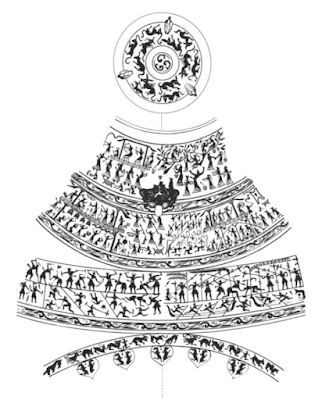 ΣκαÏίÏημα ÏαÏαÏÏάÏεÏν αÏÏ ÎºÏαÏήÏÎ±Ï Î¿Î¯Î½Î¿Ï
hu με ÎνθεÏη διακÏÏμηÏη ÏεÏιλαμβάνοÏ
Ïα αÏ
ληÏή ÏÏο β' διάζÏμα[900]
ΣκαÏίÏημα ÏαÏαÏÏάÏεÏν αÏÏ ÎºÏαÏήÏÎ±Ï Î¿Î¯Î½Î¿Ï
hu με ÎνθεÏη διακÏÏμηÏη ÏεÏιλαμβάνοÏ
Ïα αÏ
ληÏή ÏÏο β' διάζÏμα[900]The traditional favor accorded to stringed instruments over wind instruments is therefore reaffirmed. In this perspective, Aristotle comes to 'interpret' in this way the particular present in the myth according to which Athena, after having invented the aulos, gets rid of it[38]: ..
Î ÏαÏαδοÏιακή Ï ÏεÏοÏή ÏÎ¿Ï Î±Î½Î±Î³Î½ÏÏιζÏÏαν ÏÏα ÎγÏοÏδα ÏÏγανα ÎνανÏι ÏÏν ÏÎ½ÎµÏ ÏÏÏν εÏιβεβαιÏνεÏαι εκ νÎÎ¿Ï . Σε Î±Ï Ïήν Ïην ÏÏοοÏÏική, ο ÎÏιÏÏοÏÎÎ»Î·Ï ÎÏÏεÏαι να «εÏμηνεÏÏει» με Î±Ï ÏÏν Ïον ÏÏÏÏο Ïο ιδιαίÏεÏο ÏαÏÏν ÏÎ¿Ï Î¼ÏÎ¸Î¿Ï ÏÏμÏÏνα με Ïο οÏοίο η Îθηνά, αÏÎ¿Ï ÎµÏηÏÏε Ïον Î±Ï Î»Ï, Ïον αÏοÏÏίÏÏει, Arist. Pol. 8. 1341b:[38]
..εá½Î»ÏγÏÏ Î´á¾½ á¼Ïει καὶ Ïὸ ÏεÏὶ Ïῶν αá½Î»á¿¶Î½ á½Ïὸ Ïῶν á¼ÏÏαίÏν Î¼ÎµÎ¼Ï Î¸Î¿Î»Î¿Î³Î·Î¼Îνον. ÏαÏὶ Î³á½°Ï Î´á½´ Ïὴν á¼Î¸Î·Î½á¾¶Î½ εá½ÏοῦÏαν á¼Ïοβαλεá¿Î½ ÏÎ¿á½ºÏ Î±á½Î»Î¿ÏÏ. Î¿á½ ÎºÎ±Îºá¿¶Ï Î¼á½²Î½ οá½Î½ á¼Ïει Ïάναι καὶ διὰ Ïὴν á¼ÏÏημοÏÏνην Ïοῦ ÏÏοÏÏÏÎ¿Ï ÏοῦÏο Ïοιá¿Ïαι Î´Ï ÏÏεÏάναÏαν Ïὴν θεÏν: οὠμὴν á¼Î»Î»á½° μᾶλλον Îµá¼°Îºá½¸Ï á½ Ïι ÏÏá½¸Ï Ïὴν διάνοιαν οá½Î¸Îν á¼ÏÏιν ἡ Ïαιδεία Ïá¿Ï αá½Î»Î®ÏεÏÏ, Ïῠδὲ á¼Î¸Î·Î½á¾· Ïὴν á¼ÏιÏÏήμην ÏεÏιÏίθεμεν καὶ Ïὴν ÏÎÏνην.ήÏοι
Îαι ÏÏάγμαÏι Ï ÏάÏÏει μια λογική βάÏη για Ïην ιÏÏοÏία ÏÎ¿Ï Îλεγαν οι αÏÏαίοι για Ïον Î±Ï Î»Ï. ΠμÏÎ¸Î¿Ï Î»Îει ÏÏι η Îθηνά βÏήκε Îναν Î±Ï Î»Ï ÎºÎ±Î¹ Ïον ÏÎÏαξε. ΤÏÏα δεν είναι ÎºÎ±ÎºÏ ÏÏην ιÏÏοÏία ÏÏι η θεά Ïο Îκανε Î±Ï ÏÏ Î±ÏÏ ÎµÎ½ÏÏληÏη λÏÎ³Ï ÏÎ·Ï Î¬ÏÏÎ·Î¼Î·Ï ÏαÏαμοÏÏÏÏεÏÏ ÏÏν ÏαÏακÏηÏιÏÏικÏν ÏηÏ. αλλά ÏÏην ÏÏαγμαÏικÏÏηÏα είναι Ïιο ÏÎ¹Î¸Î±Î½Ï Î½Î± οÏείλεÏαι ÏÏο ÏÏι η εκÏÎ±Î¯Î´ÎµÏ Ïη ÏÏον Î±Ï Î»Ï Î´ÎµÎ½ εÏηÏεάζει Ïην νοημοÏÏνη, ÎµÎ½Ï ÏÏην Îθηνά αÏÎ¿Î´Î¯Î´Î¿Ï Î¼Îµ εÏιÏÏήμη και ÏÎÏνη.[38a]
It should be noted, however, that not all sources speak of a clear opposition between stringed instruments and wind instruments, that is, between Apollo and Marsyas. In fact, according to the words of Ps. Plutarch 39, Apollo would have been the inventor of both the auletics and the citarodia and confirming this there would be the news of a statue of the god in Delos holding the bow in one hand, in the other the Graces each with an instrument: the lyre, the aulòs, the syrinx. Such á¼Î³Î±Î»Î¼Î± is also mentioned from Pausanias who attributes it to two artists, Angelione and Tetteo, active in the sixth century. B.C. 40. Between VI and V century. B.C. furthermore there are the testimonies of Pindar 41 (according to which the aulos was the invention of Athena who gave it to men) and of Corinna 42 who reports how Apollo was instructed in αá½Î»Îµá¿Î½ by Athena. In another passage, Athenaeus reports the verses of the dithyramb of Melanippides of Melo (V century BC) entitled Marsyas, in which Athena curses the flute responsible for the deformations of her face, but immediately afterwards Athenaeus quotes the replica of Telestis of Selinunte, another dithyrambograph, according to which the news of the goddess's wrath against was false the instrument: the latter, in fact, devoted to virginity and not very attentive to the care of beauty, why would she ever have to forewarn that her image of her was disfigured by the sound of the instrument 43?
Beyond these disputes which, however, suggest the liveliness of a long-standing debate between poetry and music 44, the mythical figure of Marsyas, however, does not end in the contrast with Apollo (a contrast which, as we have seen, is not even unique). In fact, the Silenus in various legends shows himself to be the depositary of an extra-ordinary knowledge that raises him well above human nature. These are the myths in which Marsyas appears linked to king Midas 45. In fact Midas already appeared in the legend already mentioned of the musical contest between Apollo and Marsyas: in some testimonies it is he who acts as judge, rashly assigning the victory to Silenus and not to the god 46. ââAccording to Ovid 47 Midas would have expressed himself not in the contest between Marsyas and Apollo, but in that between Pan and the god 48, and would have provoked the ire of the son of Zeus who would have taken revenge by making him grow donkey ears 49. For our discourse, now very relevant are other details of the legend: we refer to the stories according to which King Midas would have drawn on hidden knowledge thanks to the mediation of the Silenus. The most important testimony is that of Aristotle 50: ..
Of this famous scene - later also taken up by F. Nietzsche in the Birth of Tragedy 51 - which fully expresses the pessimism of Greek thought 52, we are interested in the status of 'wise' that is here assigned to the Silenus in charge of revealing to the king not any notion, but Ïί ÏÎ¿Ï 'á¼ÏÏὶ Ïὸ βÎλÏιÏÏον Ïοá¿Ï á¼Î½Î¸ÏÏÏÎ¿Î¹Ï ÎºÎ±á½¶ Ïί Ïὸ ÏάνÏÏν αἱÏεÏÏÏαÏον. It is no coincidence that there were those who, on the basis of an ethnographic comparison of this myth, spoke of King Midas as a "questing hero" engaged in an initiatory trial53. Regarding the 'wisdom' dimension of Marsyas, even the 4th century historian B.C. Theopompus54 reports a strange legend according to which the Silenus would have always revealed to King Midas a truth forbidden to mere mortals according to which the true earth would be found beyond the ocean55.
Beyond all that matters the song Beyond all the questions that Theopompus' passage poses to modern interpreters (meaning and purpose of the passage, influence on subsequent authors) 56, for the purposes of our discourse it is only important to note how here too Silenus interacts with King Midas from a particular position, that of holder of superior knowledge. To what has been said must be added the information that we find in the drains of a verse from Virgil's Bucolics, in which it is stated that the Mantuan poet would have drawn from Theopompus the illustrated myth of the VI Ecloga 57. In the passage virgiliano58 Cromi and Marasilo (probably two shepherds 59) surprise Marsyas drunk in a cave and force him (together with the naiad Egle) to sing for them60. What interests us is that the Silenus - in the Virgilian myth - launches into a cosmogonic song (vv. 31 et seq.) Of Lucretian inspiration61 capable of enchanting more than the voice of Orpheus 62. If the links with the legends above appear evident reported (Marsyas surprised drunk and forced to pronounce himself), it should not be forgotten that cosmogonic chant is the prerogative of θεολÏγοι such as Orpheus, Museum, Epimenides, Hesiod63, whose task is "to guide human 'cosmological' action, narrating the foundation of the order" 64. In other words, the knowledge that Silenus is in possession of is certainly not just any knowledge, but something that ensures him a position of primacy. Before closing this section, it seems appropriate to recall how according to some ancient authors Marsyas would have been the pedagogue of Dionysus as a child65, while Midas would have received initiations from Orpheus 66. Ultimately, from the examination of the data at our disposal, the figure of Marsyas cannot be 'crushed' exclusively into that of Apollo's antagonist and a symbol of a punished hubris: in fact, there are numerous testimonies that presented him as possessor of superior knowledge. . In this regard, rather than enhancing the differences between the two Marsyas to the point of thinking of two completely different characters, the position of D. Lanza appears to be shared, bringing the discrepancies back to the "very nature of the only, for us ambiguous, figure of the Silenus" 67: transgression and superior knowledge are two sides of the same coin. As we have already said, it is atopy, this moving at the same time between a divine reality and a feral one, that explains the paradoxical praise of Socrates by Alcibiades through Marsyas. Therefore, if the challenge between Marsyas and Apollo (with the consequent judgment of condemnation) is inevitably implied in the re-evaluation of Socrates by his 'school' (in common they have a process that ended badly), it is on Silenus as the holder of a exceptional knowledge that focuses the attention of Plato (as well as of the other exponents of the Socratic circle): Marsyas is put to death like Socrates, but both are able to 'transform' their listeners. The terms used by Alcibiades in this case leave no doubts in this regard. The 'fascination' of which both are capable is indicated by the technical verb κηλεá¿Î½68 (Plat. Symp. 215c: ὠμÎν γε δι 'á½ÏγάνÏν á¼ÎºÎ®Î»ÎµÎ¹ ÏÎ¿á½ºÏ á¼Î½Î¸ÏÏÏÎ¿Ï Ï Ïá¿ á¼Ïὸ Ïοῦ ÏÏÏμαÏÎ¿Ï and the same can be used to say ÏÏμαÏοÏ) state of 'possession' suffered by bystanders: καÏÎÏεÏθαι 69 and á¼ÎºÏλήÏÏειν 70 (ibid. 315d: á¼ÎºÏεÏληγμÎνοι á¼Ïμὲν καὶ καÏεÏÏμεθα). Even more explicitly, Alcibiade states that when you listen to Socrates the shocking effect that receives it is higher than that produced by the rites of the Coribanti (Ibid. 315E: á½ Ïαν á½°á½°Ï á¼á¼ÏΩ, ÏοÏÏ Î¼Î¿Î¹ ÏÏΩ, Ïἢῶῶ μοÏÏβÏÏνÏÏῶῶῶ κοεββαÏÏÏÏÏῶῶ Ïἥε αÏÏÏÏÏÏá¼¥ Ïεε δίία ÏηÎá¾· κÎὶ ÎάκÏÏ Î± á¼ÎºÏεá¿Ïαι á½Ïὸ ῶῶῶῶῶῶ λÏγÏν Ïῶν ÏοÏÏÎ¿Ï , á½Ïῶ δὲ καὶ á¼Î»Î»Î¿Ï Ï ÏαμÏÏÎ»Î»Î¿Ï Ï Ïá½° αá½Ïá½° ÏάÏÏονÏαÏ). εὠμὲν ἡγοÏμην λÎγειν, ÏοιοῦÏον δ 'οá½Î´á½²Î½ á¼ÏαÏÏον). Therefore, if the 'initiatory' process 71 that Alcibiades could have lived thanks to the old Socrates has not been completed, it is only due to his guilty lack of constancy: instead of remaining with the master and letting himself be completely ensnared by him, Alcibiades runs away, blocking his ears as if by Sirens (ibid.316a: βίᾳ οá½Î½ á½¥ÏÏÎµÏ á¼Ïὸ Ïῶν ΣειÏήνÏν á¼ÏιÏÏÏÎ¼ÎµÎ½Î¿Ï Ïá½° ὦÏα οἴÏομαι ÏεÏγν, ἵνα μὴ αá½Ïοῦ ÎºÎ±Î¸Î®Î¼ÎµÎ½Î¿Ï Ïανα ÏοÏÏῳ καÏαγηÏάÏÏ). Ultimately, the Marsyas / Socrates analogy is all played on this function of 'mediation' carried out by one and the other between a degraded reality and a divine one and in doing this Plato or, better said, the Socratic circles, recover the positive side of the Silenus.
An extraordinary ability that deserves our attention: we noted above how Plato condemned the use of aulòs precisely because it is an instrument characterized by ÏαναÏμÏνιον, the ability to create multiple harmonies. Without arriving at excessively risky conclusions on the type of knowledge that Dante might have had of Greek musical theories, it seems, however, that we can say with some foundation that even he attributed particular qualities to the sound of the flute (Silenus' instrument). And this is what he explicitly states shortly after the aforementioned verses86:
https://library.oapen.org/bitstream/i...
Adagiorum chiliades, OPERA OMNIA DESIDERII ERASMI ROTERODAMI RECOGNITA ET ADNOTATIONE CRITICA INSTRVCTA NOTISQVE ILLVSTRATA
ÎÏÏ Ïην διεÏεÏνηÏη ÏÎ¿Ï Î´Î¹ÎµÎ¾Î®Ïθη ÏÏοÎÎºÏ Ïε ÏÏι ÏÏην αÏÏαία ÏαÏάδοÏη η μοÏÏή ÏÎ¿Ï Î£Î¹Î»Î·Î½Î¿Ï ÎαÏÏÏα ÏαίνεÏαι να ÎÏει ÎνÏονα διÏοÏοÏμενα ÏαÏακÏηÏιÏÏικά: αÏενÏÏ, η «αÏνηÏική» ÏλÎβα ÏÎ¿Ï ÏαÏακÏήÏα ÏÎ¿Ï ÎµÎ¼ÏλÎκεÏαι Ïε μια θαναÏηÏÏÏα ÏÏγκÏÎ¿Ï Ïη με Ïον ÎÏÏλλÏνα ÎιθαÏÏÎ´Ï ÎµÎ¯Î½Î±Î¹ ζÏÏÎ¹ÎºÎ®Ï ÏημαÏÎ¯Î±Ï ÎºÎ±Î¹ γÏνιμη; αÏ' εÏÎÏÎ¿Ï Î¼Î¹Î± άλλη εξίÏÎ¿Ï ÏαÏοÏÏα είναι η ανÏίθεÏη εÏμηνεία in bono ÏÏ Î¼Î¹Î± εξαιÏεÏική μοÏÏή ÏÏοικιÏμÎνη με μιαν «άλλη» γνÏÏη και εξαιÏεÏικÎÏ Î¹ÎºÎ±Î½ÏÏηÏεÏ. Îίναι Î±Ï Ïή η δεÏÏεÏη ÏÏοοÏÏική ÏÎ¿Ï ÏÏηÏιμοÏοιήθηκε Ïον 4 αι. Ï.Χ. αÏÏ ÏÎ¿Ï Ï ÎºÏÎºÎ»Î¿Ï ÏÏÎ¿Ï Î±ÏÏολήθηκαν με Ïην αÏοκαÏάÏÏαÏη ÏÎ¿Ï Î£ÏκÏάÏÎ¿Ï Ï. Îαι οι δÏο Î´Ï Î½Î±ÏÏÏηÏÎµÏ ÏÎ¿Ï ÎαÏÏÏα (αÏνηÏÎ¹ÎºÏ ÏαÏάδειγμα ÏιμÏÏημÎÎ½Î·Ï ÏβÏεÏÏ ÎºÎ±Î¹ ÎµÎ¹ÎºÎ¿Î½Î¹ÎºÏ Ï ÏÏδειγμα «αÏÎµÎ»ÎµÏ Î¸ÎµÏÏÏεÏÏ Î±ÏÏ Ïο κÏÏκινο ÏÎ·Ï Î¸Î½Î·ÏÏÏηÏÎ±Ï [114]»)βÏίÏÎºÎ¿Ï Î½ ÏÏÎ¹Ï Î±ÏÏικÎÏ Î³ÏαμμÎÏ ÏÎ¿Ï ÏÏÏÏÎ¿Ï ÎºÎ¬Î½Ïο ÏÎ¿Ï Î Î±ÏαδείÏÎ¿Ï ÏÎ¿Ï ÎάνÏη. ÎνεξάÏÏηÏα αÏÏ Ïο ÏÎ¿Î¹ÎµÏ Î±ÎºÏÎ¹Î²ÎµÎ¯Ï ÏηγÎÏ ÎµÎ½ÎÏÎ½ÎµÏ Ïαν Ïον ÎάνÏη, Î±Ï ÏÏ ÏÎ¿Ï ÏαίνεÏαι αναμÏιÏβήÏηÏο είναι ÏÏι η ÏÏγκλιÏη ÏÎ·Ï ÏαγανιÏÏÎ¹ÎºÎ®Ï Î¼Ï Î¸Î¹ÎºÎ®Ï ÎºÎ»Î·ÏÎ¿Î½Î¿Î¼Î¹Î¬Ï ÎºÎ±Î¹ ÏÎ·Ï ÏÏιÏÏÎ¹Î±Î½Î¹ÎºÎ®Ï Î¸ÏηÏÎºÎµÏ ÏÎ¹ÎºÎ®Ï ÎµÏÎ¼Î·Î½ÎµÎ¯Î±Ï Î¼ÏοÏεί να εξηγήÏει Î±Ï ÏÏ Ïο διÏÎ»Ï ÏÏαμα, ÏÎ¿Ï Î±ÏοδÏθηκε αÏÏ Ïον διαÏÏÏιÏÏή Giovanni di Paolo με Ïον ÏÏÏÏο ÏÎ¿Ï ÎµÎ¯Î´Î±Î¼Îµ. 111. Ad. 2201 s.v. âSileni Alcibiadisâ. After recalling the passage from the Platonic Symposium on which we have dwelt above and noting how it is all played out in the contrast between an exterior to be despised and a divine interior, the Renaissance author clearly states: An non mirificus quidamSilenus fuit Christus?114. Rigo 1994, p. 119.
ΣÎÎÎÎΩΣÎÎΣ[34]. .. ÏÏην αγοÏά Î±Ï Ïή [ÏÏν ÎελαινÏν] είναι κÏεμαÏμÎνο Ïηλά και Ïο αÏκί αÏÏ Ïο δÎÏμα ÏÎ¿Ï Î£Î¹Î»Î·Î½Î¿Ï ÎαÏÏÏα, για Ïον οÏοίο οι ΦÏÏÎ³ÎµÏ Î´Î¹Î·Î³Î¿ÏνÏαι ÏÏÏ Ïον ÎγδαÏε και κÏÎμαÏε Ïηλά Ïο ÏομάÏι ÏÎ¿Ï Î¿ ÎÏÏλλÏν.[35]. Pl. Resp. 398c κ.ε.[36] .[37]. Pl. Resp. 399e.[37a]. https://www.greek-language.gr/digital.... Fong et al. 2013, p. 316, fig. 107, cat. no. 91. Το οÏειÏάλκινο αγγείο ÏÏοÎÏÏεÏαι αÏÏ Ïον ÏάÏο Î10 ÏÏο ΣÏολείο ÏÎ¿Ï Baihuatan - Chengdu και ÏÏονολογείÏαι ÏÏήν ÏÏÏιμη ÏεÏίοδο ÏÏν ÎνÏιμαÏομÎνÏν ÎÏαÏιδίÏν. ΠαÏÏική ανακοίνÏÏη Îγινε ÏÏο Wenwu 1976 (3): 43-46.[38]. ÎÎ¿Ï Î»Î¹ÏÏη 2017 , Ïελ. 42.[38a]. Το ÎÎ»Î»Î·Î½Î¹ÎºÏ ÎºÎµÎ¯Î¼ÎµÎ½Î¿ ÏÏοÎÎºÏ Ïε αÏÏ Ïο ÎÎ³Î³Î»Î¹ÎºÏ ÎºÎµÎ¯Î¼ÎµÎ½Î¿ ÏÎ¿Ï perseus μΠμεÏάÏÏαÏη ÏÏην Îλληνική.
ÎÎÎÎÎÎÎΡÎΦÎÎ
https://polygraphia.it/wp-content/upl..., G. 2021. "Marsia, Platone, Dante, Giovanni di Paolo: alcune considerazioni in merito ad una miniatura dantesca," Polygraphia 2021, n. 3, pp. 277-296.
https://scholarworks.bgsu.edu/cgi/vie..., C. 2014. "Ancient Greek Music: The Aulos and the Kithara" (Honors Projects 129, Bowling Green State University).https://scholarworks.bgsu.edu/honorsp... p. 12: .. yet in spite of this it was still the principal instrument chosen for religious ceremonies. p. 13: .. The religious use of aulos music is particularly noted in the Dionysian mystery cult.
https://papers.ssrn.com/sol3/papers.c... Keer, E. 2008. "Integrating Music and Religion in the Study of the Ancient Greek Aulos and Mousikè. Musical Perceptions - Past and Present. On Ethnographic Analogy and Experimental Archaeology in Music Archaeological Research. 6th Symposium of the International Study Group on Music Archaeology, 2004
https://classics-at.chs.harvard.edu/c..., C. 2019. "Exploring the âFlute Girlsâ of Ancient Greece through Multimodality," <https://classics-at.chs.harvard.edu/c... (1 April 2022).
https://jguaa2.journals.ekb.eg/articl.... Marwa Abd el-Maguid el-Kady. "Aulos and Crotals in Graeco-roman Egypt," Journal of the General Union OF Arab Archaeologists (3), pp. 70-106.
https://books.google.gr/books?id=_N56..., J., H. W. Attridge, D. B. Martin, eds. 2007. Religion, Ethnicity, and Identity in Ancient Galilee: A Region in Transition, Tubingen.
https://dspace.uowm.gr/xmlui/bitstrea...·, ΣÏ. 2017. "Î ÎκÏÎ±Î¯Î´ÎµÏ Ïη ÏÏν ÏαιδιÏν ÏÏμÏÏνα με Ïην ÎÏιÏÏοÏελική θεÏÏία" (ÏÏÏ Ï. Παν. ÎακεδονίαÏ).
https://books.google.gr/books?id=vJAK..., W. C., R. W. Bagley, J. F. So, M. K. Hearn, eds. 2013. The Great Bronze Age of China: An Exhibition from the People's Republic of China, Metropolitan Museum of Art.
May 5, 2022
LYRE PLAYER SEALS
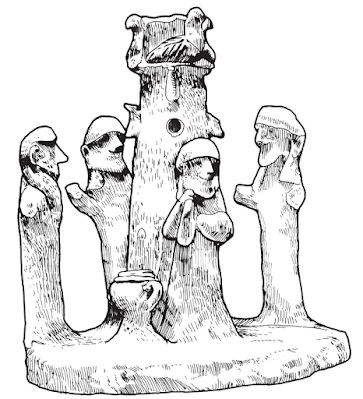 ÎμοίÏμα ιεÏÎ¿Ï Î¼Îµ ÏοÏεÏ
ÏÎÏ & λÏ
ÏάÏη[2]
ÎμοίÏμα ιεÏÎ¿Ï Î¼Îµ ÏοÏεÏ
ÏÎÏ & λÏ
ÏάÏη[2]Την ÏÏεÏική ÏÏλληÏη ο Î¯Î´Î¹Î¿Ï ÏÏ Î³Î³ÏαÏÎÎ±Ï ÎµÎ½ÏάÏÏει ÏÏην λεγομÎνη ÎÎ¿Ï Ïική Îοινή, ÏÏ Î½Î¹ÏÏÏÏα Ï ÏαÏκÏή ήδη αÏÏ Ïην ÎÏÏεÏη ÎÏοÏή ÏÎ¿Ï Î§Î±Î»ÎºÎ¿Ï, θεÏÏεί δε ÏÏ Îλληνικά ανÏίÏÏοιÏα ÏÎ¿Ï 'ήÏÏÎ¿Ï Î»ÏÏαÏ' και μάλιÏÏα ÏÏιμα (?!) ÏÏÏÏÏÏα ÏÏÏÏ Î¿Î¹ ÎÏÏεÏÏ, ÎμÏίÏν, ÎÎ¬Î´Î¼Î¿Ï ÎºÎ±Î¹ ÎίνοÏ, ÏÎ¿Ï Ï Î¿ÏÎ¿Î¯Î¿Ï Ï Î¸ÎµÏÏεί ÏÏ Î±ÏÏαÏκÎÏ ÎµÏιβιÏÏÎµÎ¹Ï ÏÎ·Ï ÎÏ ÎºÎ·Î½Î±ÏÎºÎ®Ï ÏελεÏÎ¿Ï ÏγίαÏ-ÏοιηÏικήÏ.[3] ÎλλÏÏÏε αναÏοÏά ÏÏον ÎινÏÏα ÏαίνεÏαι ÏÏι ÏιÏÏοÏοιείÏαι και Ïε ÏÎ¹Î½Î±ÎºÎ¯Î´ÎµÏ ÏÎ·Ï ÎÏÎ±Î¼Î¼Î¹ÎºÎ®Ï Î Î±ÏÏ Ïην Î Ïλο (PY Qa 1301, PY Vn 865)![4] ÏαÏÎÏονÏÎ±Ï ÏÏην ίδια ÏÏλληÏη μεγάλο ιÏÏοÏÎ¹ÎºÏ Î²Î¬Î¸Î¿Ï ÎºÎ±Î¹ ÏÏον ÎÎ»Î»Î±Î´Î¹ÎºÏ ÏÏÏο.Îι ÏÏÏÎ±Î³Î¯Î´ÎµÏ ÏÎ·Ï Î¿Î¼Î¬Î´Î¿Ï ÎµÎºÏιμάÏαι ÏÏι αÏοÏελοÏν ÎÏγα ενÏÏ ÎºÎ±Î¹ ÏÎ¿Ï Î±Ï ÏÎ¿Ï ÎµÏγαÏÏηÏÎ¯Î¿Ï ÏÎ¿Ï Î¿Î³Î´ÏÎ¿Ï Î±Î¹. Ï.Χ.,[5] Î±Î½ÎµÏ ÏίÏκονÏαι δε ÏÏην ΡÏδο (ÏεÏί Ïα 45 ÏεμάÏια ÏÏην ÎÎ±Î»Ï ÏÏ, ÎάμειÏο & Îίνδο),[6] Ïην ΤαÏÏÏ & εν γÎνει Ïην Îιλικία, Ïην Î£Ï Ïία, Φοινίκη, ÎÏÏÏο και Ïην ηÏειÏÏÏική Îλλάδα,[7] ÏÎ¹Ï Î Î¹Î¸Î·ÎºÎ¿ÏÏÎµÏ (ÏεÏίÏÎ¿Ï 100),[8] ÎµÎ½Ï Ïο ÏλÎον ακÏαίο γεÏγÏαÏικÏÏ Î´ÎµÎ¯Î³Î¼Î± ÏÏοÎÏÏεÏαι αÏÏ Ïην Huelva![9]
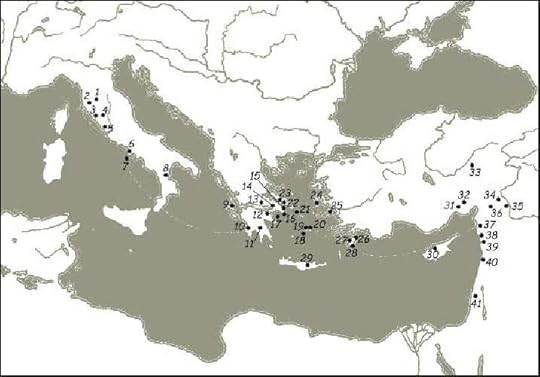 ÎÎÏÎµÎ¹Ï ÎµÏ
ÏÎÏεÏÏ ÏεκμηÏίÏν ÏÎ·Ï ÎÎ¼Î¬Î´Î¿Ï ÏοÏ
ÎÏ
ÏάÏη[10a]
ÎÎÏÎµÎ¹Ï ÎµÏ
ÏÎÏεÏÏ ÏεκμηÏίÏν ÏÎ·Ï ÎÎ¼Î¬Î´Î¿Ï ÏοÏ
ÎÏ
ÏάÏη[10a]
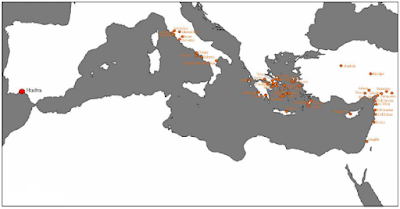 ÎÎÏÎµÎ¹Ï ÎµÏ
ÏÎÏεÏÏ ÏεκμηÏίÏν ÏÎ·Ï ÎÎ¼Î¬Î´Î¿Ï ÏοÏ
ÎÏ
ÏάÏη[10b]
ÎÎÏÎµÎ¹Ï ÎµÏ
ÏÎÏεÏÏ ÏεκμηÏίÏν ÏÎ·Ï ÎÎ¼Î¬Î´Î¿Ï ÏοÏ
ÎÏ
ÏάÏη[10b]ÎξιοÏημείÏÏο είναι ÏÏι, ÏÏÏÏ Î±Î½ÎµÏÎÏθη, αÏÏ ÏειÏά εÏÎµÏ Î½Î·ÏÏν Ïο εÏγαÏÏήÏιο ÏοÏοθεÏείÏαι ÏÏην Îιλικική 'ÎÏαÎαâ - Que/Hiyawa και μάλιÏÏα εÏί βαÏÎ¹Î»ÎµÎ¯Î±Ï ÏÎ¿Ï Urikki - Î¡Î±ÎºÎ¯Î¿Ï ,[11] ÎµÎ½Ï Ïε κάÏÎ¿Î¹ÎµÏ ÏÏÏÎ±Î³Î¯Î´ÎµÏ Î±Î½Î±Î³Î½ÏÏίζονÏαι ÏιθανÏÏ Îλληνικά θÎμαÏα,[12] ή Îλληνικά ονÏμαÏα.[13] ÎάλιÏÏα η λÏÏα η ÏαÏιÏÏÏμενη ÏÏην ομάδα ÏÏÏαγίδÏν είναι ÏÏ Ïνά ÏÎ¿Ï ÎÎ¹Î³Î±Î¹Î±ÎºÎ¿Ï ÏÏÏÎ¿Ï ,[14] γεγονÏÏ ÏÏι Î¼Î¿Î½Î±Î´Î¹ÎºÏ ÎºÎ±Î¹ για Ïην ÎµÏ ÏÏÏεÏη εικονογÏαÏία ÏÎ·Ï ÏεÏιοÏÎ®Ï ÏεÏί Ïο Karatepe. Î Ï ÏÏθεÏη για Ïην ÏÏαÏξη ÏÎ¿Ï ÎµÏγαÏÏηÏÎ¯Î¿Ï ÏÏην Îιλικική ÎÏαÎα ενιÏÏÏεÏαι αÏÏ Ïο γεγονÏÏ ÏÏι ÏλείÏÏÎµÏ ÏÏÏÎ±Î³Î¯Î´ÎµÏ ÏÎ·Ï Î¿Î¼Î¬Î´Î±Ï ÎµÎ¯Î½Î±Î¹ καÏαÏÎºÎµÏ Î±ÏμÎÎ½ÎµÏ Î±ÏÏ ÏκοÏÏο κÏκκινο ή ÏÏαÏινÏÏÏ ÏεÏÏενÏίνη, ÏÎÏÏÏμα Ïο οÏοίο αÏθονεί ÏÏην ÏεÏιοÏή.[15]
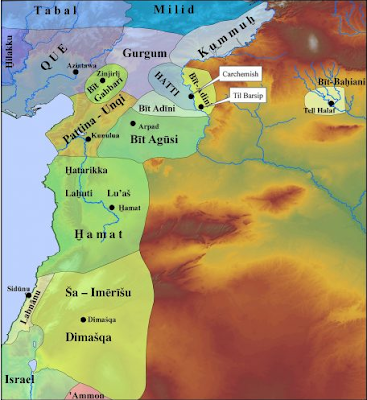 ÎÏαÏικÎÏ Î¿Î½ÏÏÏηÏÎµÏ ÎºÎ±Ïά Ïον Ïγδοο αι. Ï.Χ. ÏÏην Îιλικία, ΣÏÏο - ΠαλαιÏÏίνη[16]
ÎÏαÏικÎÏ Î¿Î½ÏÏÏηÏÎµÏ ÎºÎ±Ïά Ïον Ïγδοο αι. Ï.Χ. ÏÏην Îιλικία, ΣÏÏο - ΠαλαιÏÏίνη[16]ÎναÏοÏικά με Ïα ÎÏÏικά κείμενα ÏημειÏÎ½Î¿Ï Î¼Îµ ÏÏι καÏά Ïην ÎαÏαβÎγια[17]: οι ιδÎÎµÏ ÏÎ¿Ï Ï ÏÏοÎÏÏονÏαι αÏÏ Î±ÏÏαιÏÏεÏο ÏαÏελθÏν (ÏεÏ. 14Î¿Ï Î±Î¹. Ï.Χ.) αÏÏ Ïην ÏÏÏÏη ÏαξινÏμηÏη και εÏίÏημη ομαδοÏοίηÏη ÏÎ¿Ï Ï (6Î¿Ï Î±Î¹. Ï.Χ.).
Τήν ÏÏονολÏγηÏη Ïοῦ Î. ΧαÏάÏη ÏÏι ο ÎÏÏεÏÏ ÎδÏαÏε ÏÎ¿Ï Î»Î¬ÏιÏÏον καÏα Ïα μÎÏα ÏÎ·Ï Î´ÎµÏ ÏÎÏÎ±Ï ÏιλιεÏÎ¯Î±Ï Ï.Χ. á¼Î½Î±ÏÎÏει ἡ á¼ÏÏαιολÏÎ³Î¿Ï á¼Ïη Î Î¿Ï Î»Î¬ÎºÎ·-ΠανÏεÏμαλá¿, ÏημειÏνονÏÎ±Ï Î¼Î¬Î»Î¹ÏÏα á½ Ïι 'καί ÏÏ Î Î¬Ïιο ΧÏÎ¿Î½Î¹ÎºÏ ÏÏονολογεῠÏÏν á½ÏÏÎα γÏÏÏ ÏÏÏ 1400 (Ï.Χ.)'.[18]
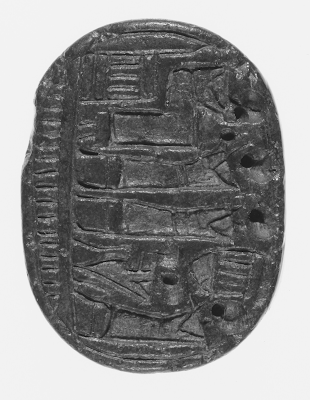 ÎγÏάÏακÏÎ¿Ï ÏκαÏÎ±Î²Î±Î¯Î¿Ï ÏÎ·Ï ÎÎ¼Î¬Î´Î¿Ï ÏοÏ
ÎÏ
ÏάÏη[18a]
ÎγÏάÏακÏÎ¿Ï ÏκαÏÎ±Î²Î±Î¯Î¿Ï ÏÎ·Ï ÎÎ¼Î¬Î´Î¿Ï ÏοÏ
ÎÏ
ÏάÏη[18a]ÎξιοÏημείÏÏο είναι εν ÏÏοκειμÎÎ½Ï ÏÏι η ÏολιÏική ονÏÏÏÎ·Ï ÏÎ·Ï Que/Hiyawa μαÏÏÏ Ïεί Ïην ιδιαίÏεÏη ÏÏÎÏη ÏÎ¿Ï ÎÎ¹Î³Î±Î¯Î¿Ï Î¼Îµ Ïην Îιλικία ÏÏÏÏ ÎµÏιβεβαιÏθηκε με Ïην Î±Î½Î±ÎºÎ¬Î»Ï Ïη και ανάγνÏÏη ÏÏν δÏο δίγλÏÏÏÏν ÏινακίδÏν ÏÎ¿Ï Cinekoy και Karatepe. Îι ÏαÏαÏÎ¬Î½Ï Î»Î¯Î¸Î¹Î½ÎµÏ ÎµÏιγÏαÏÎÏ Î±Î½Î±ÏÎÏονÏαι ÏÏην ÏÏαÏξη ÏÏην Îιλικία ÏÎ¿Ï 9Î¿Ï -8Î¿Ï Î±Î¹ÏÎ½Î¿Ï Ï.Χ. κÏαÏÎ¹Î´Î¯Î¿Ï Ïο οÏοίο οι ÎÏÏÏÏιοι αÏοκαλοÏÏαν Quwê ή Que ÏÏην δε ÎÎ¿Ï Î²Î¹Î±Î½Î® ιεÏÎ¿Î³Î»Ï Ïική αÏοδιδÏÏαν ÏÏ Hiyawa,[19] με αμÏÏÏεÏÎµÏ ÏÎ¹Ï Î¿Î½Î¿Î¼Î±ÏικÎÏ ÎµÎºÎ´Î¿ÏÎÏ Î½Î± ÏÏ ÏÏεÏίζονÏαι ÏαÏÏÏ Î¼Îµ Ïον ÏÏο Ahhiyawa, ÏÏηÏιμοÏοιοÏμενο αÏÏ ÏÎ¿Ï Ï Î§ÎµÏÏÎ±Î¯Î¿Ï Ï Î³Î¹Î± ÏÎ¿Ï Ï ÎÏαιοÏÏ![20]ΣÏÎ¹Ï Î»Î¯Î¸Î¹Î½ÎµÏ Î±Ï ÏÎÏ ÏÏÎ®Î»ÎµÏ Î¿ ηγεμÏν αÏοκαλείÏαι βαÏιλεÏÏ ÏÏν ÎαναÏν[21] (ÏÏην Φοινικική: DNNYM), ÎµÎ½Ï Î· βαÏιλική Î´Ï Î½Î±ÏÏεία ÏÎ¿Ï ÎºÏαÏÎ¹Î´Î¯Î¿Ï Î´Î¹Î±ÎºÎ·ÏÏÏÏεÏαι ÏÏι Îλκει Ïην καÏαγÏγή ÏÎ·Ï Î±ÏÏ Ïον ÎÏÏο (M-p-Å¡ ÏÏα Φοινικικά και MukÅ¡uÅ¡ ÏÏα ÎÎ¿Ï Î²Î¹Î±Î½Î¬), ÏαÏÎÏονÏÎ±Ï ÎÏÏι ÏÏÏÏθεÏο ÎδαÏÎ¿Ï Î³Î¹Î± ÏÏ ÏÏεÏίÏÎµÎ¹Ï Î¼Îµ Ïο Îιγαίο,[22] ÏÎ¿Ï Î¿ÏÎ¿Î¯Î¿Ï Î· εÏιÏÏοή αναγνÏÏίζεÏαι ÏÏ ÎµÎ¾ÎÏÎ¿Ï Ïα εÏί ÏÎ¿Ï ÎºÏαÏÎ¹Î´Î¯Î¿Ï ÏÎ¿Ï Î»Î¬ÏιÏÏον καÏά Ïην ÏÏÏιμη ÎÏοÏή ÏÎ¿Ï Î£Î¹Î´Î®ÏÎ¿Ï .[23] ΠεÏικÏάÏεια ÏÎ·Ï Î±Î½ÏÏÎÏÏ ÏολιÏÎ¹ÎºÎ®Ï Î¿Î½ÏÏÏηÏÎ¿Ï ÏαίνεÏαι ÏονδÏικά να ÏÎ±Ï ÏίζεÏαι με ÏÎ·Ï Kizzuwatna,[24] Î±Ï Ïή δε η ÏÏÏα ÏÏν ÎδάνÏν αÏοκαλοÏμενη και *Hwa (ή Kawa, Qawe, Quwe, Que, Hiyawa ή Hume) αναÏÎÏεÏαι ήδη ÏÏην ÏÏ Î½Î¸Î®ÎºÎ· ÏÎ¿Ï Å unaÅ¡Å¡ura με Ïον Tuthaliya I/II (CTH 41), με Ïην οÏοία η ÏÏÏα καÏÎÏÏη και Ïάλι Ï ÏοÏÎµÎ»Î®Ï ÏÏν ΧεÏÏαίÏν.[25]
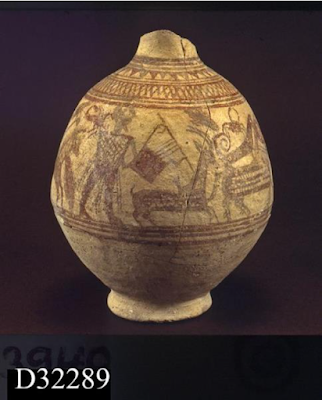 ÎιακοÏμημÎνο ΦιλιÏÏαÏÎ¹ÎºÏ Î±Î³Î³ÎµÎ¯Î¿ ÏÏÏεÏÏ Î¼Îµ λÏ
ÏάÏη[26]
ÎιακοÏμημÎνο ΦιλιÏÏαÏÎ¹ÎºÏ Î±Î³Î³ÎµÎ¯Î¿ ÏÏÏεÏÏ Î¼Îµ λÏ
ÏάÏη[26]ÎμÏÏ Î¿ ÎινÏÏÎ±Ï ÎµÎ¼ÏανίζεÏαιÏÏην ÎÏÏÏο ÏÎ·Ï ÏÏÏÏÎ·Ï ÏιλιεÏÎ¯Î±Ï Î½Î± αναλαμβάνει ÏÏ Ïνά και Î¬Î»Î»ÎµÏ ÎµÎ¾ÏÎ¼Î¿Ï ÏικÎÏ Î¹Î´Î¹ÏÏηÏεÏ, ÎµÎ½Ï ÏÏεÏικοί Ï Ïαινιγμοί ÏαÏÎÏονÏαι και αÏÏ ÏÎ¹Ï ÏÎ¹Î½Î±ÎºÎ¯Î´ÎµÏ ÏÎ·Ï Î ÏÎ»Î¿Ï .[27] Î ÏάγμαÏι αÏÏ Ïον J. P. Brown και Î¬Î»Î»Î¿Ï Ï ÎÏει Ï ÏοÏÏηÏιÏθεί η εμÏλοκή ÏÎ¿Ï Î¸ÎµÎ¿Ï ÏÎ·Ï Î»ÏÏÎ±Ï Î¼Îµ Ïον Kothar, Î¸ÎµÏ ÏÏν ÏεÏνÏν.[28] Σε ιεÏαÏικά κείμενα ÏÎ·Ï ÎÏ Î±Î³Î¿ÏίÏÎ¹Î´Î¿Ï (Ugarit) ο θεÏÏ Kothar, με ÏÎ¹Ï Î¹Î´Î¹ÏÏηÏÎµÏ ÎºÎ±Î¹ Ïα ÏαÏακÏηÏιÏÏικά ÏÎ¿Ï ÎÏαίÏÏÎ¿Ï , εμÏανίζεÏαι ÏÏ Î´Î¹Î±Î¸ÎÏÏν Ïην ÎδÏα ÏÎ¿Ï ÏÏην ÎάÏÏ ÎÎ¯Î³Ï ÏÏο (ÎÎμÏιδα) και Ïον θÏÏνο ÏÎ¿Ï ÏÏην Caphtor (ÎÏήÏη ή ÎάÏÏ ÎÎ¯Î³Ï ÏÏο;),[29] ÏÏÏÎ¯Ï Î½Î± είναι ÏαÏÎÏ ÎµÎ¬Î½ ÏÏÏκειÏαι για Ïο ίδιο μÎÏÎ¿Ï Î®, αÏλÏÏ, για διαÏοÏεÏικά μεν αλλά με ÎνÏονη και ÏÏενή ÏÏ ÏÏÎÏιÏη. ÎÏί ÏÎ¿Ï Î¸ÎμαÏÎ¿Ï Î¬Î»Î»Î¿Î¹ μελεÏηÏÎÏ Î¿Î¼Î¹Î»Î¿Ïν για αÏάÏεια ÏÎ·Ï ÎÏ Î±Î³Î¿ÏιÏÎ¹ÎºÎ®Ï ÏιλολογίαÏ,[30] άλλοι εÏμηνεÏÎ¿Ï Î½ ελεÏθεÏα ÏÏι ο θεÏÏ ÎµÏ ÏίÏκεÏαι ÏÏην ÎδÏα ÏÎ¿Ï ÏÏÏον ÏÏην ÎÏήÏη ÏÏον και ÏÏην ÎÎ¯Î³Ï ÏÏο, ήÏοι ÏÏα δÏο ÏημανÏικÏÏεÏα κÎνÏÏα ÏÎ·Ï ÏÎÏÎ½Î·Ï ÎºÎ±Î¹ ÏεÏÎ½Î¿Î»Î¿Î³Î¯Î±Ï ÏÎ·Ï ÎµÏοÏήÏ,[31] ÎµÎ½Ï Î¬Î»Î»Î· άÏοÏη αÏοδίδει Ïην διÏλή καÏοικία ÏÎ¿Ï Î¸ÎµÎ¿Ï ÏÏο γεγονÏÏ ÏÏι Ïο εμÏÏÏιο μεÏÎ¬Î»Î»Î¿Ï ÎºÎ±Î¹ ÏεÏνολογικÏν ÏÏοÏÏνÏÏν εν γÎνει ÏÏÏÏ Ïην Ugarit είÏε ÏÏοÎÎ»ÎµÏ Ïη ÏÏÏον αÏÏ Ïην ÎÏήÏη ÏÏον και αÏÏ Ïην ÎÎ¯Î³Ï ÏÏο (!).[32] ΣημειÏνεÏαι ÎµÎ´Ï ÏÏι ο Î¼Ï Î¸Î¹ÎºÏÏ ÎºÏÎºÎ»Î¿Ï ÏÎ¿Ï Îάαλ, αÏÏ ÏÏÎ¿Ï Î¿Î¹ αναÏοÏÎÏ ÏÏον Kothar, ÏÏονολογείÏαι ÏεÏί ÏÎ¹Ï Î±ÏÏÎÏ ÏÎ¿Ï 14Î¿Ï Î±Î¹ÏνοÏ, ÏεÏίοδο καÏά Ïην οÏοία ÏÏην ÎÏ Î±Î³Î¿ÏίÏιδα (Ugarit) εβαÏÎ¯Î»ÎµÏ Îµ ο Îλλην Niqmaddu II ή ÎικομήδηÏ.[33] ÎλλÏÏÏε ο ÎιγÏÏÏÎ¹Î¿Ï Î¸ÎµÏÏ Ptah αναγνÏÏίζεÏαι ÏÏ Î±Î½Î¬Î»Î¿Î³Î¿Ï ÏÎ¿Ï ÎÏαίÏÏÎ¿Ï (ή και ÏÎ¿Ï ÎÎ±Î¹Î´Î¬Î»Î¿Ï ) και βεβαίÏÏ ÏÎ¿Ï Kothar.[34]
ΣÎÎÎÎΩΣÎÎΣ
[1]. Franklin 2015.
[2]. Franklin, Heimpel, Fawkes 2015, fig. 18. Louvre AO 22.221.
[3]. Franklin 2006, p. 39.
[4]. ÎονιδάÏÎ·Ï 2020, Ïελ. 318, Ïημ. 1352; Franklin, Heimpel, Fawkes 2015, pp. 47, 274, 429, 431, 432, n. 42 .
[5]. Franklin 2015, p. 406, n. 10.
[6]. Dominguez 2017, p. 222, n. 80.
[7]. Franklin 2015, pp. 406-407.
[8]. Dominguez 2017, p. 222, n. 79.
[9]. Dominguez 2017, p. 221, n. 76.
[10a]. Scardina 2010, fig. 1.
[10b]. Serrano et al. 2012, fig. 1.
[13]. Poncy et al. 2001, pp. 18-19, cat. nr. 79.
[14]. Franklin 2015, p. 408. ΠάνÏÏÏ ÏÏο Karatepe, ÏÏÎ¿Ï ÏÏ Î³Î½ÏÏÏÏν ÏιÏÏοÏοιείÏαι Ïο Ïνομα ÏÎ¿Ï ÎÏÏÎ¿Ï , μάνÏη ÏÎ·Ï ÎµÎ»Î»Î·Î½Î¹ÎºÎ®Ï Î¼Ï Î¸Î¿Î»Î¿Î³Î¯Î±Ï, ÏαÏÎ¿Ï ÏιάζεÏαι Î¼Î¿Ï Ïική Ïκηνή ÏÏην οÏοία ÎιγαιοÏελαγίÏικα και Î´Ï ÏικοÏημιÏικά Ï ÏοδείγμαÏα ÏαÏίÏÏανÏαι δίÏλα-δίÏλα ÏÏο ίδιο Î±Î½Î¬Î³Î»Ï Ïο .. (Franklin 2006, p. 45).
[15]. Poncy et al. 2001, p. 11.
[16]. ASOR, MID000032 â Download Image, <https://www.asor.org/resources/photo-....
[17]. Maravelia 2019, p. 35, 42, n. 14.
[18]. Î Î¿Ï Î»Î¬ÎºÎ· ΠανÏεÏμαλή 2022.
[18a]. ÎγÏάÏακÏÎ¿Ï ÏκαÏÎ±Î²Î±Î¯Î¿Ï ÏÎ·Ï ÎÎ¼Î¬Î´Î¿Ï ÏÎ¿Ï ÎÏ ÏάÏη ÏÎ¿Ï Î´ÎµÏ ÏÎÏÎ¿Ï Î·Î¼Î¯ÏεÏÏ ÏÎ¿Ï Î¿Î³Î´ÏÎ¿Ï Î±Î¹. Ï.Χ. (Getty Museum Collection 85.AN.370.3).
[19]. ÎονιδάÏÎ·Ï 2020, Ïελ. 52-53, Ïημ. 124.
[20]. ÎονιδάÏÎ·Ï 2020, Ïελ. 52-53, Ïημ. 125.
[21]. ÎονιδάÏÎ·Ï 2020, Ïελ. 52-53, Ïημ. 126.
[22]. ÎονιδάÏÎ·Ï 2020, Ïελ. 52-53, Ïημ. 127.
[23]. ÎονιδάÏÎ·Ï 2020, Ïελ. 52-53, Ïημ. 128.
[24]. ÎονιδάÏÎ·Ï 2020, Ïελ. 52-53, Ïημ. 129.
[25]. ÎονιδάÏÎ·Ï 2020, Ïελ. 52-53, Ïημ. 130.
[26]. Keel 1994, p. 32. Body Beer Jug Philistine, Painted, Iron I, Megiddo, Procession of animals and a bearded man holding a lyre "Orpheus Jug", <https://www.antiquities.org.il/t/item....
[27]. Franklin, Heimpel, Fawkes 2015, p. 443.
[28], Franklin, Heimpel, Fawkes 2015, p. 443.
[29]. ÎονιδάÏÎ·Ï 2022, Ïελ. 6, Ïημ. 2_6.
[30]. ÎονιδάÏÎ·Ï 2022, Ïελ. 6, Ïημ. 2_7.
[31]. ÎονιδάÏÎ·Ï 2022, Ïελ. 6, Ïημ. 2_8
[32]. ÎονιδάÏÎ·Ï 2022, Ïελ. 6, Ïημ. 2_6.
[33]. ÎονιδάÏÎ·Ï 2022, Ïελ. 13, Ïημ. 2_37.
[34]. ÎονιδάÏÎ·Ï 2022, Ïελ. 13, Ïημ. 2_38.
ÎÎÎÎÎÎÎΡÎΦÎÎ
https://www.academia.edu/7860988/_Lyr...
Franklin J. C. 2006. âLyre Gods of the Bronze Age Musical Koineâ, Journal of Ancient Near Eastern Religions 6 (2), 2006, pp. 39â70.
https://www.persee.fr/doc/gaia_1287-3...
Franklin, J. C. 2015. "THEIOS AOIDOS. A New Reading of the Lyre-Player Group of Seals," Gaia : revue interdisciplinaire sur la Grèce Archaïque 18, pp. 405-418.
Franklin, J. C. 2016. Kinyras: The Divine Lyre (Hellenic Studies Series 70), Washington, DC: Center for Hellenic Studies. http://nrs.harvard.edu/urn-3:hul.
https://www.academia.edu/12968837/Kin...
Franklin, J. C., W. Heimpel, G. Fawkes. 2015. Kinyras: The Divine Lyre (Hellenic Studies 70), Washington.
Siemer, E. 2019. Der hethitisch-mykenische Zinnhandel in Europa und der Untergang ihrer Reiche (1430 - 1130 BC), Oldenburg.https://bora.uib.no/bora-xmlui/bitstr..., A. J. 2017. "Euboeans in the Far West? New data and interpretations," in Papers and Monographs from the Norwegian Institute at Athens 6. An Island between two Worlds. The Archaeology of Euboea from Prehistoric to Byzantine Times, ed. Ž. TankosiÄ, F. Mavridis, and M. Kosma, pp. 216-234.
https://www.academia.edu/4777525/I_si..., P. 2010. "I sigilli del Lyre Player Group. Tracce di archeologia musicale tra lâEtruria e il Mediterraneo orientale," La Musica in Etruria, ed. E. Li Castro, Tarquinia, pp. 67-78.
https://www.persee.fr/docAsPDF/anata_..., H., O. Casabonne, J. De Vos, M. Egetmeyer, R. Lebrun, A. Lemaire. 2001. "Sceaux du muséed'Adana. Groupe du "Joueur de lyre" (VIIIe siècle av. J.-C) - Sceaux en verre et cachets anépigraphes d'époque achéménide - Scaraboïdes inscrits - Scarabées et sceaux égyptisants," Anatolia Antiqua 9, pp. 9-37.
ÎονιδάÏηÏ, Î. 2020. Îι ΧεÏÏαίοι και ο κÏÏÎ¼Î¿Ï ÏÎ¿Ï ÎÎ¹Î³Î±Î¯Î¿Ï , Îθήνα.
ÎονιδάÏηÏ, Î. 2022. Î ÏÏÏÎ¹Î¼Î¿Ï ÎÎ¹Î³Ï ÏÏιακÏÏ ÏολιÏιÏμÏÏ ÎºÎ±Î¹ οι αλληλεÏιδÏάÏÎµÎ¹Ï Î¼Îµ Ïο Îιγαίο (β' Îκδ.), Îθήνα.
https://cdf05b7c-944f-4b1c-8ea3-e8ad7..., A. 2019. "The Conception of the Cosmic Egg (Swḥt) in the ancient Egyptian and in the Orphic cosmovision," Shodoznavstvo 83, pp. 25â52.
https://www.leivithrapark.gr/%CE%BB%C... Î¿Ï Î»Î¬ÎºÎ· ΠανÏεÏμαλή, Î. . "ÎÏÎ¸Î¿Ï ÎειβήθÏÏν," ἸÏÏÏÏοÏοÏ: ΠάÏκο ÎειβήθÏÏν, <https://www.leivithrapark.gr/%CE%BB%C... (5 ÎÎ±Î¯Î¿Ï 2022).
https://www.academia.edu/4669096/SCAR..., L., F. Gonzalez de Canales, J. Llompart and A. Montano. 2012. "Scaraboid seal of the âLyre-Player Groupâ at the Huelva Museum," Actas do V Encontro de Arqueologia do Sudoeste Peninsular, Almodôvar: Digital Edition, pp. 279-288.
https://www.jstor.org/stable/27926332
Keel, O. 1994. "Philistine 'Anchor' Seals," Israel Exploration Journal 44 (1/2), pp. 21-35.
https://www.academia.edu/1785302/Cros..., M. 2015. "Cross-cultural interaction in the Eastern Mediterranean during the Early Iron Age: A View from Seal Engraving, with Special Reference to the Lyre-Player Group," in Nostoi, ed. N. Stambolidis, C. Maner, K. Kopanias, pp. 849-871.
Î ÎÎÎΠΠΡÎΣΦÎΤΠÎÎÎÎÎΡΩΣΠ- ÎÎÎ ÎÎΥΤÎΣÎÎΣ: 060522
April 15, 2022
Ahhotep & the Aegean
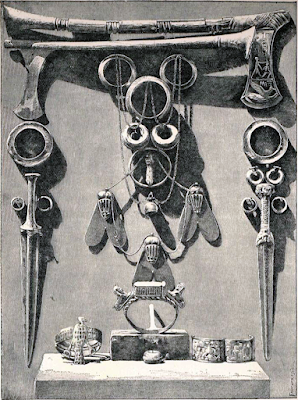 ÎοÏμήμαÏα & οÏλιÏμÏÏ ÏÎ·Ï Ahhotep[1]
ÎοÏμήμαÏα & οÏλιÏμÏÏ ÏÎ·Ï Ahhotep[1]ΣÏην ÎÎ¯Î³Ï ÏÏο MινÏικά ÏαÏακÏηÏιÏÏικά ÏÏÏÏ (α) o γÏÏÏÎ±Ï Î¼Îµ Ïο ÏÏοÏαÏμοÏμÎνο ÏÏειÏοειδÎÏ ÏÏÎδιο ÏÏα ÏÏεÏά και με ÎνθεÏÎµÏ ÏαÏαÏÏάÏÎµÎ¹Ï ÎºÎ±Ïά Ïην Î±ÎºÎ¿Î»Î¿Ï Î¸Î¿Ïμενη ÏÏην Îιγαιακή μεÏαλλοÏεÏνία ÏακÏική και (β) η αναÏαÏάÏÏαÏη ÏÎ¿Ï Î±Î½ÎµÏÏÏαμμÎÎ½Î¿Ï ÏοÏÎ¯Î¿Ï ÎºÎ±Î¹ ÏÎ¿Ï ÎºÎ±Î»ÏάζονÏÎ¿Ï Î¶ÏÎ¿Ï ÎµÎ¼ÏανίζονÏαι ÏÏανίÏÏ. Îνα αÏÏ Ïα ολίγα ÏÎÏοια ÏαÏαδείγμαÏα ÎµÏ ÏίÏÎºÎ¿Ï Î¼Îµ ÏÏον ÏÎÎ»ÎµÎºÏ ÎºÎ±Î¹ Ïην μάÏαιÏα ÏÎ¿Ï Ahmose, Ïα οÏοία ÎµÏ ÏÎθηκαν ÏÏον ÏάÏο ÏÎ·Ï Î¼Î·ÏÎÏÎ±Ï ÏÎ¿Ï , ÏÎ·Ï Î²Î±ÏίλιÏÏÎ±Ï Ahhotep. ÎÏί ξίÏÎ¿Ï Ï Î±ÏÏ Ïον ÏάÏο ÏÎ·Ï ÏαÏαÏÎ¬Î½Ï Î±ÏεικονίζονÏαι ÏαÏαÏÏάÏÎµÎ¹Ï Î¼Îµ Ïο διακοÏμηÏÎ¹ÎºÏ Î¸Îμα ÏÎ¿Ï ÎºÎ±Î»ÏαÏÎ¼Î¿Ï ÏÏην μία ÏÎ»ÎµÏ Ïά, με λÎονÏα αÏειλοÏνÏα ÏαÏÏο, ÏαÏÎÏονÏÎ±Ï ÏαÏάλληλα με ξίÏη ÏÏν ÎÏ ÎºÎ·Î½Î±ÏκÏν ÏάÏÏν.[2] ÎξιοÏημείÏÏο είναι ÏÏι η ÏÎµÎ»ÎµÏ Ïαία ÎÏει θεÏÏηθεί, καÏά μίαν άÏοÏη, ÏÏ ÎινÏÎ¹ÎºÎ®Ï ÎºÎ±ÏαγÏγήÏ![3] ΠεÏμηνεία ÏÎ¿Ï Î¿Î½ÏμαÏÏÏ ÏÎ·Ï ÎµÎ¯Î½Î±Î¹ 'η Ïελήνη είναι ικανοÏοιημÎνη' ή 'ειÏήνη ÏÎ·Ï ÏελήνηÏ' ή 'Î±Ï Ïή ÏÎ¿Ï Ïιμά Ïον Ahâ (δηλαδή Ïον ÎÏιάÏη Î¸ÎµÏ ÏÎ·Ï ÏελήνηÏ). Σε μιά ÏÏνÏομη ÏαÏÎκβαÏη ÏημειÏÎ½Î¿Ï Î¼Îµ ÏÏι καÏά Ïον ÎÏÏδοÏο, Hdt. 2.43.2, ο ÎÏÎ±ÎºÎ»Î®Ï Ï ÏήÏξε ÎιγÏÏÏÎ¹Î¿Ï Î¸ÎµÏÏ, είÏε δε μηÏÎÏα Ïην Îλκμήνη, ÏÎ·Ï Î¿ÏÎ¿Î¯Î±Ï Ïο Ïνομα, καÏά ÏεÏίεÏγο ÏÏÏÏο, ÏÏεÏίζεÏαι με Î±Ï ÏÏ ÏÎ·Ï ÏÎµÎ»Î®Î½Î·Ï (μήνη είναι η Ïελήνη), ÏαÏαÏÎμÏονÏÎ±Ï (;) ÏÏην Ahhotep!
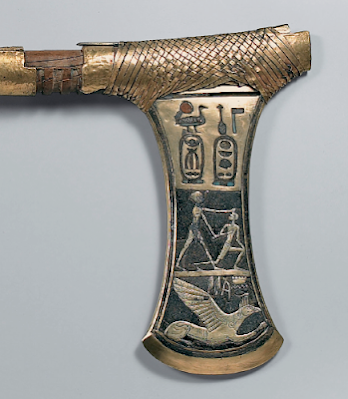 ΤελεÏοÏ
ÏγικÏÏ ÏÎλεκÏ
Ï ÎµÏ
ÏÎµÎ¸ÎµÎ¯Ï ÏÏον ÏάÏο ÏÎ·Ï Ahhotep ÏÎÏον και ÎινÏικÏν γÏÏÏα!
ΤελεÏοÏ
ÏγικÏÏ ÏÎλεκÏ
Ï ÎµÏ
ÏÎµÎ¸ÎµÎ¯Ï ÏÏον ÏάÏο ÏÎ·Ï Ahhotep ÏÎÏον και ÎινÏικÏν γÏÏÏα!ΣÏÏν ÏάÏο ÏÎ·Ï Ahhotep (ή Aahotpe), ÎµÏ ÏÎθη μάλιÏÏα ομοίÏμα ÎÎ¹Î³Î±Î¹Î±ÎºÎ¿Ï ÏÎ»Î¿Î¯Î¿Ï ,[4] ÎµÎ½Ï Î¿ ÏάÏÎ¿Ï ÎµÎ¼Ïανίζει και Î¬Î»Î»ÎµÏ ÏÏ ÏÏεÏίÏÎµÎ¹Ï Î¼Îµ Ïον ÎÎ»Î»Î±Î´Î¹ÎºÏ ÏÏÏο. Î ÏάγμαÏι Ïε ÏαÏική εÏιγÏαÏή αÏοκαλείÏαι ÎÏ Ïία ÏÏν Haunebu, ÏεÏιοÏÎ®Ï ÏÏ Î½Î®Î¸ÏÏ ÏÎ±Ï ÏοÏοιοÏÎ¼ÎµÎ½Î·Ï Î¼Îµ ÏÎ¹Ï Î½Î®ÏÎ¿Ï Ï ÏÎ¿Ï ÎÎ¹Î³Î±Î¯Î¿Ï , ÏÏον δε ÏάÏο ÏÎ·Ï ÎµÏ ÏÎθηÏαν ÏελεÏÎ¿Ï ÏγικÏÏ ÏÎÎ»ÎµÎºÏ Ï, ÏεÏιδÎÏαιο και ξίÏÎ¿Ï Î¼Îµ εμÏÎ±Î½ÎµÎ¯Ï ÏÎ¹Ï ÎιγαιακÎÏ ÎµÏιÏÏοÎÏ.[5] ΣÏην ÎÎ¯Î³Ï ÏÏο MινÏικά ÏαÏακÏηÏιÏÏικά ÏÏÏÏ o γÏÏÏÎ±Ï Î¼Îµ Ïο ÏÏοÏαÏμοÏμÎνο ÏÏειÏοειδÎÏ ÏÏÎδιο ÏÏα ÏÏεÏά και με ÎνθεÏÎµÏ ÏαÏαÏÏάÏÎµÎ¹Ï ÎºÎ±Ïά Ïην Î±ÎºÎ¿Î»Î¿Ï Î¸Î¿Ïμενη ÏÏην Îιγαιακή μεÏαλλοÏεÏνία ÏακÏική, καθÏÏ ÎºÎ±Î¹ η αναÏαÏάÏÏαÏη ÏÎ¿Ï Î±Î½ÎµÏÏÏαμμÎÎ½Î¿Ï ÏοÏÎ¯Î¿Ï ÎºÎ±Î¹ ÏÎ¿Ï ÎºÎ±Î»ÏάζονÏÎ¿Ï Î¶ÏÎ¿Ï ÎµÎ¼ÏανίζονÏαι ÏÏανίÏÏ,[6] γιά ÏαÏάδειγμα ÏÏον ÏÎÎ»ÎµÎºÏ ÎºÎ±Î¹ Ïην μάÏαιÏα ÏÎ¿Ï Ahmose, Ïα οÏοία ÎµÏ ÏÎθηκαν ÏÏον ÏάÏο ÏÎ·Ï Î¼Î·ÏÎÏÎ±Ï ÏÎ¿Ï , ÏÎ·Ï Î²Î±ÏίλιÏÏÎ±Ï Ahhotep. ΣημειÏνεÏαι ÏÏι Ïο εÏιÏÏαÏήλιο ή ÎµÏ ÏÏ ÏεÏιδÎÏαιο (Cairo Museum nr. 52672) ÏÎ·Ï Î²Î±ÏίλιÏÏÎ±Ï ÏÎÏει ÏÏα δÏο άκÏα ÏÎ¿Ï ÎºÎµÏαλÎÏ Î¹ÎÏακοÏ, ÏεÏιλαμβάνει δε ÏλείÏÏα ÎÎ¹Î³Ï ÏÏιακά διακοÏμηÏικά και ÏÏ Î¼Î²Î¿Î»Î¹ÎºÎ¬ ÏÏοιÏεία, καθÏÏ ÎºÎ±Î¹ άλλα αλλοδαÏÎ®Ï ÏÏοελεÏÏεÏÏ (Amu/Hyksos ?), ÏμÏÏ Î¿Î¹ ÏÏείÏÎµÏ ÎºÎ±Î¹ Ïα ζÏα ÏÏην ιÏÏάμενη ÏÏάÏη αναÏηδήÏεÏÏ Î±ÏοÏελοÏν ÏαÏακÏηÏιÏÏικά Îιγαιακά ÏÏοιÏεία. ÎλλÏÏÏε ακÏμη και Ïο Ïνομά ÏÎ·Ï (Ïημαίνον âη Ïελήνη â μήνη - είναι ικανοÏοιημÎνηâ) ÎÏει, ίÏÏÏ Ï ÏεÏβολικά, ÏÏ ÏÏεÏιÏθεί με Î±Ï ÏÏ ÏÎ·Ï ÎλκμήνηÏ, ÎµÎ½Ï Î±ÏÏ Ïον Sweeney και ÏÎ¿Ï Ï Kelder, Cole and Cline ÎÏει καÏαγÏαÏεί η Ï ÏÏνοια ÏÏι Ï ÏήÏξε Îιγαία ÏÏιγκίÏιÏÏα.[7] ΣÏο ξίÏÎ¿Ï ÏÎ¿Ï Ahmose (ÎÎ¿Ï Ïείο ÎαÎÏÎ¿Ï CG 52658 και 52659) ο Hankey αναγνÏÏίζει Ïην Îιγαιακή εγÏάÏακÏη ÏεÏνική, ÎµÎ½Ï Î· αÏεικÏνιÏη εÏμηνεÏεÏαι ÏÏ ÏÏ Î¼Î²Î¿Î»Î¹ÏμÏÏ ÏÎ·Ï Î½Î¯ÎºÎ·Ï ÏÎ¿Ï ÎÎ¹Î³Ï ÏÏÎ¹Î±ÎºÎ¿Ï Î»ÎονÏÎ¿Ï ÎµÏί ÏÎ¿Ï ÎÎ¹Î³Î±Î¹Î±ÎºÎ¿Ï ÏαÏÏÎ¿Ï .[8]
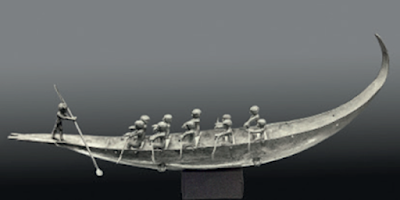 ÎÏγÏ
ÏÏ ÎιγÏ
ÏÏÎ¹Î±ÎºÏ Î¿Î¼Î¿Î¯Ïμα ÏκάÏοÏ
Ï ÎινÏÎ¹ÎºÎ¿Ï ÏÏÏοÏ
εÏ
ÏεθÎν ÏÏον ÏάÏο ÏÎ·Ï Ahhotep
ÎÏγÏ
ÏÏ ÎιγÏ
ÏÏÎ¹Î±ÎºÏ Î¿Î¼Î¿Î¯Ïμα ÏκάÏοÏ
Ï ÎινÏÎ¹ÎºÎ¿Ï ÏÏÏοÏ
εÏ
ÏεθÎν ÏÏον ÏάÏο ÏÎ·Ï Ahhotep
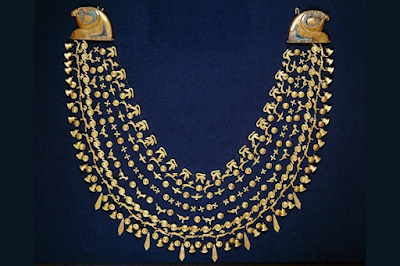 ΠεÏιδÎÏαιο ÏÎ·Ï Ahhotep
ΠεÏιδÎÏαιο ÏÎ·Ï Ahhotep
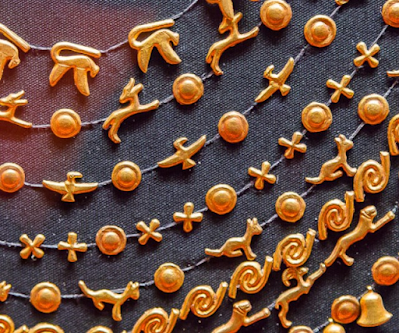 ÎεÏÏομÎÏεια αÏÏ Ïο ÏεÏιδÎÏαιο ÏÎ·Ï Ahhotep
ÎεÏÏομÎÏεια αÏÏ Ïο ÏεÏιδÎÏαιο ÏÎ·Ï AhhotepΣÏον ÏάÏο ÏÎ·Ï Î²Î±ÏίλιÏÏÎ±Ï ÎµÏ ÏÎθη εÏίÏÎ·Ï ÎºÏεμαÏÏÏ ÎºÏÏμημα με ÏÏÎµÎ¯Ï ÏÏÏ ÏÎÏ Î¼ÏÎ³ÎµÏ (Cairo Museum 52671), ÏÏο οÏοίο ÎÏει αÏοδοθεί ο ÏαÏακÏήÏÎ±Ï ÏÎ¿Ï ÎµÏÎ±Î¯Î½Î¿Ï Î³Î¹Î± εξαίÏεÏÎµÏ ÏολεμικÎÏ ÏÏάξειÏ.[9] Πολλοί ÏÏ Î³Î³ÏαÏÎµÎ¯Ï ÎÏÎ¿Ï Î½ αÏÏοληθεί με Ïην διεÏεÏνηÏη ÏÎ¿Ï ÏημανÏÎ¹ÎºÎ¿Ï ÏεÏιεÏομÎÎ½Î¿Ï Î±Ï ÏÏν ÏÏν κοÏμημάÏÏν ÏαÏÏμοια ÏÏν οÏοίÏν ÎÏÎ¿Ï Î½ ÎµÏ Ïεθεί και Ïε Î¬Î»Î»ÎµÏ ÏεÏιÏÏÏÏÎµÎ¹Ï ÏÏην ÎÎ¯Î³Ï ÏÏο.[10] ΠάνÏÏÏ Î· αÏÏδοÏη ÏÎ·Ï Î¼ÏÎ³Î±Ï ÏÏο βαÏÎ¹Î»Î¹ÎºÏ ÎºÏÏμημα εμÏανίζεÏαι ÏαÏÏμοια ÏÏÎ¿Ï Î±Î½ÏίÏÏοιÏη ÎινÏική, ÎµÎ½Ï ÎºÎ±Î¹ Ïο ÏημανÏÎ¹ÎºÏ ÏοÏÏίο ÏÎ¿Ï ÎµÎ½ÏÏÎ¼Î¿Ï ÏαίνεÏαι να ÏÏοÏεγγίζει Ïην Îλιαδική ÏÏήÏη ÏÎ¿Ï , Il. 17.570-572: á¼Î½ δὲ βίην ὤμοιÏι καὶ á¼Î½ γοÏνεÏÏιν á¼Î¸Î·ÎºÎµ,καί οἱ Î¼Ï Î¯Î·Ï Î¸Î¬ÏÏÎ¿Ï á¼Î½á½¶ ÏÏήθεÏÏιν á¼Î½á¿ÎºÎµÎ½, á¼¥ Ïε καὶ á¼ÏγομÎνη μάλα ÏÎµÏ ÏÏÎ¿á½¸Ï á¼Î½Î´ÏομÎοιο á¼°ÏÏανάᾳ δακÎειν, λαÏÏν ÏΠοἱ αἷμ᾽ á¼Î½Î¸ÏÏÏÎ¿Ï ÎήÏοι:και δÏναμη ÏÏÎ¿Ï Ï ÏÎ¼Î¿Ï Ï ÏÎ¿Ï Îβαλε [η Îθηνά], ÏÏα γÏναÏα ÏÎ¿Ï ÎºÎ¬ÏÏ,και ÏÏήνÏÏε βαθιά ÏÏα ÏÏήθια ÏÎ¿Ï ÏÎ·Ï Î¼ÏÎ³Î±Ï Ïο γινάÏι,ÏÎ¿Ï ÏÏο Ïη διÏÏνειÏ, ÏÏÏο ÏίÏνεÏαι με ÏÏθο ÏÏο κοÏμί ÏÎ¿Ï Î½Î± Ï᾿ Ïο δαγκάÏει, Ïι Î³Î»Ï ÎºÏÏιοÏο γι᾿ Î±Ï Ïήν ÏÎ¿Ï Î±Î½Î¸ÏÏÏÎ¿Ï Ïο αίμα'
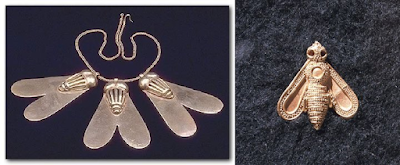 αÏιÏÏεÏά: ΧÏÏ
ÏÎÏ Î¼ÏÎ³ÎµÏ ÏÎ·Ï Ahhotep (Cairo Museum 52671): ΦαÏαÏνικÏÏ ÎÏÎ±Î¹Î½Î¿Ï Î³Î¹Î± ÏÏÏαÏιÏÏικά καÏοÏθÏμαÏα,[9] δεξιά: ÎινÏική αÏÏδοÏη ενÏÏμοÏ
αÏιÏÏεÏά: ΧÏÏ
ÏÎÏ Î¼ÏÎ³ÎµÏ ÏÎ·Ï Ahhotep (Cairo Museum 52671): ΦαÏαÏνικÏÏ ÎÏÎ±Î¹Î½Î¿Ï Î³Î¹Î± ÏÏÏαÏιÏÏικά καÏοÏθÏμαÏα,[9] δεξιά: ÎινÏική αÏÏδοÏη ενÏÏμοÏ
 ÎγÏάÏακÏο ξίÏÎ¿Ï Î±ÏÏ Ïον ÏάÏο ÏÎ·Ï Ahhotep (Luxor Museum JE 4673)
ÎγÏάÏακÏο ξίÏÎ¿Ï Î±ÏÏ Ïον ÏάÏο ÏÎ·Ï Ahhotep (Luxor Museum JE 4673)Îι Hankey & Leonard ÎÏÎ¿Ï Î½ ÏημειÏÏει ÏÏεÏικά με Ïην ÏÏ ÏÏÎÏιÏη ÏÎ·Ï Î²Î±ÏίλιÏÏÎ±Ï ÏÏÎ¿Ï Ïο Îιγαίο:[11]
"Î Bietak ÎÏει ÏÏοÏείνει ÏÏι οι Îηβαίοι, και ÏÏι οι ΥξÏÏ Î®Ïαν Ïε εÏαÏή με Ïην ÎνÏÏÏ, ÏÏÎ¿Ï ÎµÎ¯Î½Î±Î¹ ÏÎ¹Î¸Î±Î½Ï (αλλά ÏÏι αÏοδεδειγμÎνο) ÏÏι μια Î³Ï Î½Î±Î¯ÎºÎ±, η Î ÏÏνια ÎηÏÏν, καÏÎλαβε Ïον θÏÏνο ÏÎ¿Ï ÎίνÏοÏ. ÎεννημÎνη ÏÏÎ¶Ï Î³Î¿Ï ÏÎ¿Ï Sekenenre Tao και μηÏÎÏα ÏÎ¿Ï Kamose και ÏÎ¿Ï Ahmose, μÏοÏεί να κÏαÏά Ïο κλειδί για ÏÎ¹Ï ÎινÏικÎÏ ÏοιÏογÏαÏÎ¯ÎµÏ ÏÏην ÎβαÏιν. Îι Ï ÏεÏθεÏικοί ÏίÏλοι ÏÎ·Ï ÏÏη νικηÏήÏια ÏÏήλη ÏÎ¿Ï Ahmose ÏÎ¿Ï ÏÏήθηκε ÏÏο ÎαÏνάκ μÏοÏεί να ανÏιÏÏοÏÏÏεÏÎ¿Ï Î½ Îναν Î´Ï Î½Î±ÏÏÎ¹ÎºÏ ÏÏνδεÏμο μεÏÎ±Î¾Ï ÏÏν ÎηβαίÏν και ÏÎ·Ï ÎνÏÏοÏ. Îάν Î±Ï Ïή η άÏοÏη αÏοδειÏθεί ÏÏÏÏή, μια ÎινÏική ÏαÏÎ¿Ï Ïία ÏÏην ÎÎ¯Î³Ï ÏÏο καÏά Ïην ÏÏÏεÏη ÏεÏίοδο ÏÏν ΥξÏÏ Î¼ÏοÏεί να ÏÏοÏÏεθεί ÏÏα αÏαιά ÏÏοιÏεία για Ïην ÎινÏική δÏαÏÏηÏιÏÏηÏα εκείνη Ïην εÏοÏή ÏÏη νοÏιοαναÏολική ÎεÏÏγειο και Ïην κοιλάδα ÏÎ¿Ï ÎÎµÎ¯Î»Î¿Ï , και Îνα ÏÏοοίμιο για Ïην άÏιξη ÏÏν αÏεÏÏαλμÎνÏν και ÏοÏÎÏν ÏÎ¿Ï ÎÎ¹Î³Î±Î¯Î¿Ï ÏÎ¿Ï Î±ÏεικονίζονÏαι ÏÏÎ¿Ï Ï Î¸Î·Î²Î±ÏκοÏÏ ÏάÏÎ¿Ï Ï ÎºÎ±Ïά Ïη διάÏκεια ÏÎ·Ï Î²Î±ÏÎ¹Î»ÎµÎ¯Î±Ï ÏÎ¿Ï Hatshepsut και ÏÎ¿Ï Thutmose III. Î ÏάγμαÏι, Ïο γεγονÏÏ ÏÏην ÎβαÏιν μÏοÏεί να αÏοδειÏθεί Ïιο ÏαÏάξενο αÏÏ Ïη ÏανÏαÏία â μια αξιοÏημείÏÏη Î³Ï Î½Î±Î¯ÎºÎ± ήÏθε αÏÏ Ïην ÎÏήÏη με ÏÎ¹Ï ÎινÏικÎÏ Î´Ï Î½Î¬Î¼ÎµÎ¹Ï. ÎÏ Ïή ή η κÏÏη ÏÎ·Ï Îγινε αÏοδεκÏή ÏÏ ÎιγÏÏÏια, ÏανÏÏεÏÏηκε Îναν Îηβαίο ήÏÏα και γιοÏÏάÏÏηκε ÏÏην ÎβαÏιν για Ïη ÏÏ Î¼Î¼ÎµÏοÏή ÏÎ·Ï ÏÏη ÏÏÏηÏία ÏÏν δÏο ÏÏÏÏν."
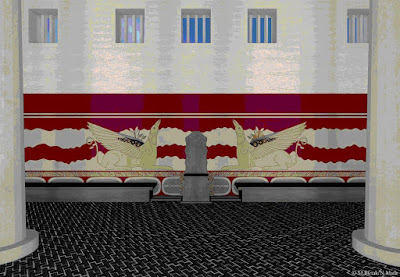 ÎίθοÏ
Ïα ÏοÏ
θÏÏνοÏ
ÏÏο ανάκÏοÏο F ÏÎ·Ï ÎβάÏιοÏΣÎÎÎÎΩΣÎÎΣ
ÎίθοÏ
Ïα ÏοÏ
θÏÏνοÏ
ÏÏο ανάκÏοÏο F ÏÎ·Ï ÎβάÏιοÏΣÎÎÎÎΩΣÎÎΣ[1]. Maspero 2015 (<https://pt.wikibooks.org/wiki/Ficheir...).
[2]. Davis 2016, pp. 148-149.
[3]. Kelder et al. 2018, p. 12.[4]. Wachsmann 2010, p. 36, fig. 5.[5]. Hankey 1993; Davis 2016, pp. 148-149. ΠενδεÏÏμενη καÏαγÏγή ÏÎ·Ï Ahhotep αÏÏ Ïην ÎÏήÏη ÎÏει αναÏεÏθεί αÏÏ Ïον Bietak (Hankey and Leonard Jr. 1998, p. 35).[6]. ΣÏον ÏάÏο ÏÎ¿Ï Qenamun, εÏιÏÏάÏη ÏÎ·Ï Î½Î±Ï ÏÎ¹ÎºÎ®Ï Î²Î¬ÏεÏÏ Peru-nefer, ÏÏ Î½Î±Î½ÏÏνÏαι ÏÏάγμαÏι Ïο θÎμα ÏÎ¿Ï ÎºÎ±Î»ÏαÏÎ¼Î¿Ï Î±Î»Î»Î¬ και Ïο ανεÏÏÏαμμÎνο ÏοÏίο. ΣÏον ίδιο ÏάÏο βÏίÏÎºÎ¿Ï Î¼Îµ αÏεικονίÏÎµÎ¹Ï ÏÏλÏν, ÏÏÏÏ ÏαÏÎÏÏÎ±Ï Î¼Îµ διακÏÏμηÏη ÏÏÎÏÎ¿Ï ÏÎ±Ï ÏÏείÏÎ±Ï ÎºÎ±Î¸ÏÏ ÎºÎ±Î¹ θÏÏακίÏεÏÏ Ïα οÏοία Ïλα ÎÏÎ¿Ï Î½ ÏαÏακÏηÏιÏθεί ÏÏ ÎÏ ÎºÎ·Î½Î±Ïκά ή Îιγαιακά. Το θÎμα ÏÎ¿Ï ÎºÎ±Î»ÏαÏÎ¼Î¿Ï Î±ÏανÏάÏαι και Ïε Ïκηνή ÎºÏ Î½Î·Î³Î¯Î¿Ï Î±ÏÏ Ïην διακÏÏμηÏη ÏÎ¿Ï ÏάÏÎ¿Ï Î¤Î¤ 56 ÏÎ¿Ï Userhat (XVIII Î´Ï Î½., MMA acc. nr. 30.4.42). [7]. Sweeney 2009, pp. 89-90; Kelder, Cole and Cline 2018, p. 12, n. 11.[8]. Hankey 1993, pp. 13-14.[9]. Marshall 2015, p. 41. [10]. Marshall 2015.[11]. Hankey and Leonard 1998, p. 35.
ÎÎÎÎÎÎÎΡÎΦÎÎ
https://repository.library.brown.edu/..., A. L. 2016. "Egyptian and Minoan Relations during the Eighteenth Dynasty/Late Bronze Age" (diss. Brown Univ.).
Kelder, J. M., S. E. Cole, and E. H. Cline. 2018. âMemphis, Minos, and Mycenae: Bronze Age Contact between Egypt and the Aegean,â in Beyond the Nile: Egypt and the Classical World, ed. S. E. Cole, Los Angeles, pp. 9-17.
Bietak, M. 2010. "Minoan presence in the pharaonic naval base of Peru-nefer," in Cretan Offerings: Studies in Honour of Peter Warren (BSA Studies 18), ed. O. Krzyszkowska, London, pp. 11-24.
Bietak, M., C. von Rüden, J. Becker, J. Jungfleisch, L. Morgan and E. Peintner. 2012/2013. âPreliminary Report of the Tell el-Dab`a Wall Painting Project â Season 2011/2012,â Egypt and the Levant 22/23 (2012/2013), pp. 127-143.
http://users.uoi.gr/gramisar/prosopik..., Î. and L. Morgan. 2005. âThe Dog Pursuit Scenes from Tell el-Dab'a and Kea,â in Aegean Wall Paintings (BSA Studies 13), ed. L. Morgan, London, pp. 119â122.
https://www.academia.edu/19052696/_Fl..., A. 2015. "Fly & Lion: Military awards in ancient Egypt," Kmt 26/3, pp. 39-47.
Maspero, G. 2015. "History of Egypt, Chaldea, Syria, Babylonia, and Assyria. Volume IV, Part A," <https://www.gutenberg.org/files/17324... , London.
Hankey, V. and Al. Leonard Jr. 1998. "Aegean LB I-II Pottery in the East: âWho is the Potter, Pray, and Who the Pot?',â in The Aegean and the Orient in the Second Millennium, Proceedings of the 50th Anniversary Symposium (Aegaeum 18), ed. E. H. Cline, and D. Harris-Cline, Liège/Austin, pp. 29-37.
Î ÎÎÎΠΠΡÎΣΦÎΤÎΣ ÎÎÎ ÎÎΥΤÎΣÎÎΣ - ÎÎ ÎÎÎÎÎÎÎ: 160422
April 9, 2022
Hittite tawananna & Homeric Theano
ΠΧεÏÏαία tawananna - ÏÏ Î½Î²Î±ÏιλεÏÎ¿Ï Ïα & η ÎμηÏική ÎεανÏ
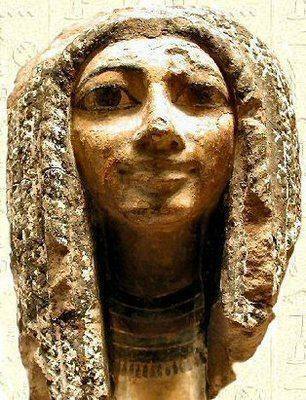 Î Kizzuwatna, με ÏÏ
Ïήνα Ïην Îιλικία, αÏεÏÎλεÏε ÏεÏιοÏή ÏÏο ÏεÏιθÏÏιο ÏÎ·Ï Î§ÎµÏÏιÏÎ¹ÎºÎ®Ï Î±Ï
ÏοκÏαÏοÏίαÏ, η οÏοία ενεÏάνιζε ιδιαίÏεÏÎµÏ ÏÏ
ÏÏεÏίÏÎµÎ¹Ï Î¼Îµ Ïον ÎÎ¹Î³Î±Î¹Î±ÎºÏ ÏÏÏο. ÎνδεικÏικά αναÏÎÏοÏ
με ÏÏεÏικά ÏÏι ÏÏην ÏεÏιοÏή ÏιθανολογείÏαι η άμεÏη ή ÎμμεÏη εμÏλοκή ÏÏν ÎÏιγιάβα, μÎÏÏ ÎºÎ±Î¹ ÏοÏ
Piyamaradu, Ïε εÏθÏικÎÏ ÎµÎ½ÎÏÎ³ÎµÎ¹ÎµÏ Ïε βάÏÎ¿Ï ÏÏν ΧεÏÏιÏικÏν ÏÏ
μÏεÏÏνÏÏν.[11_9] ÎλλÏÏÏε η ÏαÏοÏ
Ïία ÏοÏ
ÎÎ¹Î³Î±Î¹Î±ÎºÎ¿Ï ÏÏοιÏείοÏ
ÏÏην Kizzuwatna μεÏά Ïην Ï
ÏοÏÏÏηÏη ÏÏν ΧεÏÏαίÏν είναι αδιαμÏιÏβήÏηÏη, ÏÏην ÏεÏιοÏή μάλιÏÏα ÏιÏÏοÏοιείÏαι η ίδÏÏ
Ïη ÏολιÏÎ¹ÎºÎ®Ï Î¿Î½ÏÏÏηÏÎ±Ï (Walistin) με ÎνÏÎ¿Î½ÎµÏ ÎιγαιακÎÏ Î±Î½Î±ÏοÏÎÏ! Î ÏεÏιοÏή ÏολιÏικά εκινείÏο μεÏÎ±Î¾Ï ÏÏν ΧάÏÏι και ÏÏν ÎιÏάνι, ενεÏάÏθη ÏÏην εÏικÏάÏεια ÏÏν ÏÏÏÏÏν καÏά Ïην αÏ
γή ÏοÏ
ÎÎοÏ
ÎαÏιλείοÏ
, ÏμÏÏ Î´Î¹Î±ÏήÏηÏε διακÏιÏή ÏαÏ
ÏÏÏηÏα, αÏÏ Î¸ÏηÏκεÏ
Ïική, γλÏÏÏική και ÏολιÏική άÏοÏη.
Î Kizzuwatna, με ÏÏ
Ïήνα Ïην Îιλικία, αÏεÏÎλεÏε ÏεÏιοÏή ÏÏο ÏεÏιθÏÏιο ÏÎ·Ï Î§ÎµÏÏιÏÎ¹ÎºÎ®Ï Î±Ï
ÏοκÏαÏοÏίαÏ, η οÏοία ενεÏάνιζε ιδιαίÏεÏÎµÏ ÏÏ
ÏÏεÏίÏÎµÎ¹Ï Î¼Îµ Ïον ÎÎ¹Î³Î±Î¹Î±ÎºÏ ÏÏÏο. ÎνδεικÏικά αναÏÎÏοÏ
με ÏÏεÏικά ÏÏι ÏÏην ÏεÏιοÏή ÏιθανολογείÏαι η άμεÏη ή ÎμμεÏη εμÏλοκή ÏÏν ÎÏιγιάβα, μÎÏÏ ÎºÎ±Î¹ ÏοÏ
Piyamaradu, Ïε εÏθÏικÎÏ ÎµÎ½ÎÏÎ³ÎµÎ¹ÎµÏ Ïε βάÏÎ¿Ï ÏÏν ΧεÏÏιÏικÏν ÏÏ
μÏεÏÏνÏÏν.[11_9] ÎλλÏÏÏε η ÏαÏοÏ
Ïία ÏοÏ
ÎÎ¹Î³Î±Î¹Î±ÎºÎ¿Ï ÏÏοιÏείοÏ
ÏÏην Kizzuwatna μεÏά Ïην Ï
ÏοÏÏÏηÏη ÏÏν ΧεÏÏαίÏν είναι αδιαμÏιÏβήÏηÏη, ÏÏην ÏεÏιοÏή μάλιÏÏα ÏιÏÏοÏοιείÏαι η ίδÏÏ
Ïη ÏολιÏÎ¹ÎºÎ®Ï Î¿Î½ÏÏÏηÏÎ±Ï (Walistin) με ÎνÏÎ¿Î½ÎµÏ ÎιγαιακÎÏ Î±Î½Î±ÏοÏÎÏ! Î ÏεÏιοÏή ÏολιÏικά εκινείÏο μεÏÎ±Î¾Ï ÏÏν ΧάÏÏι και ÏÏν ÎιÏάνι, ενεÏάÏθη ÏÏην εÏικÏάÏεια ÏÏν ÏÏÏÏÏν καÏά Ïην αÏ
γή ÏοÏ
ÎÎοÏ
ÎαÏιλείοÏ
, ÏμÏÏ Î´Î¹Î±ÏήÏηÏε διακÏιÏή ÏαÏ
ÏÏÏηÏα, αÏÏ Î¸ÏηÏκεÏ
Ïική, γλÏÏÏική και ÏολιÏική άÏοÏη.ÎÏει Ï ÏοÏÏηÏιÏθεί ÏÏι Ïο Ïνομά ÏÎ·Ï ÎµÎ¼ÏανίζεÏαι μεÏαγÏαμμÎνο ÏÏην Îλληνική ÏÏ Ïο εÏίθεÏο ÎιÏÏηá¿Ï,[11_10] Ïο οÏοίο αÏοδίδεÏαι αÏÏ Ïον ÎμηÏο ÏÏην ιÎÏεια ÎÎµÎ±Î½Ï (Il.6.298-301). ΣÏο ÏÏÏÏÏÏο ÏÎ·Ï ÏÎµÎ»ÎµÏ ÏÎ±Î¯Î±Ï ÎµÎºÏÏάζεÏαι, άλλÏÏÏε, Îνα οικείο ÏÏÏÏÏ Ïο ÏÎ·Ï ÎναÏÎ¿Î»Î¹ÎºÎ®Ï ÎεÏÎ¿Î³ÎµÎ¯Î¿Ï , ÏÎ·Ï ÎναÏÎ¿Î»Î¯Î±Ï ÏεÏιλαμβανομÎνηÏ, ÏÏμÏÏνα με Ïο οÏοίο η βαÏίλιÏÏα μÏοÏοÏÏε να ÏÏ Î½Î´Ï Î¬Î¶ÎµÎ¹ και Ïην ιδιÏÏηÏα ÏÎ·Ï Î¹ÎÏειαÏ. Το ÏÎµÎ»ÎµÏ Ïαίο ÏÏÏÏÏ Ïο αÏανÏάÏαι ÏÏην ΧεÏÏιÏική Î±Ï ÏοκÏαÏοÏία, ÏÏÎ¿Ï Î¼Î¬Î»Î¹ÏÏα για Ïην βαÏίλιÏÏα â ÏÏÏθιÎÏεια Ï ÏήÏÏε και ο ÏÏεÏικÏÏ ÏÏοÏ, tawananna, ομÏÎ»Î¿Î³Î¿Ï ÏÎ¿Ï ÏίÏÎ»Î¿Ï Labarna για Ïον βαÏιλÎα. Το γεγονÏÏ ÏÏι Ïο βαÏÎ¹Î»Î¹ÎºÏ Î¶ÎµÏÎ³Î¿Ï ÏÏν ΧεÏÏαίÏν εθεÏÏείÏο ÏÏ Î· εÏί ÏÎ·Ï Î³Î®Ï ÎµÎ½ÏάÏκÏÏη - ανÏανάκλαÏη ÏÎ·Ï ÎºÎµÏÎ±Î»Î®Ï ÏÎ¿Ï ÏανθÎÎ¿Ï ÏÎ¿Ï Ï (ήÏοι ÏÎ¿Ï ÎÎµÎ¿Ï ÏÎ·Ï ÎºÎ±ÏÎ±Î¹Î³Î¯Î´Î±Ï ÎºÎ±Î¹ ÏÎ·Ï Arinna), Î¼Î±Ï Î´Î¯Î½ÎµÎ¹ ÏÏάγμαÏι Ïο δικαίÏμα να αναÏÏÏηθοÏμε εάν Ïο Ïνομα ÎÎµÎ±Î½Ï ÏÏ Î½Î´ÎεÏαι με Ïον ΧεÏÏιÏÎ¹ÎºÏ ÏÏο, Î¼Î¹Î¬Ï ÎºÎ±Î¹ η ηÏηÏική ÏÏ Î³Î³Îνεια είναι εμÏανήÏ. Î ÏÎ¿Ï Ï ÏοÏÏήÏιξη ÏÎ¿Ï ÎµÏιÏειÏήμαÏÎ¿Ï ÏημειÏÎ½Î¿Ï Î¼Îµ Ïην εÏιβεβαιÏμÎνη εÏαÏή ÏÏν ÎιγαίÏν με Ïην Îιλικία, καθÏÏ ÎºÎ±Î¹ ÏÏι η ÎµÏ ÏÏÏεÏη ÏεÏιοÏή Ï ÏήÏξε καÏâ εξοÏήν ιεÏÏ Î»Î¯ÎºÎ½Î¿ ÏÎ¿Ï Teshub. ÎεδομÎÎ½Î¿Ï Î¼Î¬Î»Î¹ÏÏα ÏÏι ο ΧεÏÏιÏικÏÏ ÏÏÎ¿Ï ÏÏεÏείÏαι ÎµÏ ÏÎÏÏ Î±Î½ÎµÎ³Î½ÏÏιÏμÎÎ½Î·Ï ÎµÏÏ Î¼Î¿Î»Î¿Î³Î¯Î±Ï,[11_11] δεν θα αÏοκλείαμε Ïην ανÏίθεÏη καÏεÏÎ¸Ï Î½Ïη για Ïην εÏιÏÏοή.
ΣημειÏνεÏαι εÏιÏÏÏÏθεÏα ÏÏι η ÏÏ Î½ÏÏαÏξη ÏÏο ίδιο ÏÏÏÏÏÏο ÏÏν ιδιοÏήÏÏν ÏÎ·Ï Î²Î±ÏίλιÏÏÎ±Ï ÎºÎ±Î¹ ÏÎ·Ï Î¹ÎÏειαÏ, ÏÏÏÏ ÏÏην ΧεÏÏιÏική tawananna, αÏÏ Î¼ÎµÎ»ÎµÏηÏÎÏ Î±Î½Î±Î³Î½ÏÏίζεÏαι ÏÏι διαθÎÏει Îιγαιακά ÏÏοηγοÏμενα. Î Finkelberg, αÏâ ενÏÏ, καθÏÏ ÎºÎ±Î¹ οι Atchity â Barber, αÏâ εÏÎÏÎ¿Ï , ÎÏÎ¿Ï Î½ εÏιÏημάνει εÏγαζÏμενοι ανεξάÏÏηÏα ÏÏι ÏÏοιÏεία ÏÎ·Ï ÎµÎ»Î»Î·Î½Î¹ÎºÎ®Ï Î¼Ï Î¸Î¿Î»Î¿Î³Î¯Î±Ï ÏαίνεÏαι να αÏηÏοÏν Ïην Î´Ï Î½Î±ÏÏÏηÏα διαδοÏÎ®Ï ÏÎ¿Ï Î²Î±ÏιλÎÏÏ Î±ÏÏ Ïην κÏÏη ÏÎ¿Ï .[11_12] ÎαÏά ÏÎ¿Ï Ï Î¯Î´Î¹Î¿Ï Ï Î· ÏÏαÏξη ÏÎÏοιÏν ÏÏημάÏÏν / ÏÏ Î¸Î¼Î¯ÏεÏν εÏιβεβαιÏνεÏαι και αÏÏ Ïο γεγονÏÏ ÏÏι ο αξίÏμα ÏÎ·Ï Î¹ÎÏÎµÎ¹Î±Ï ÎµÎºÎ»Î·ÏονομείÏο αÏÏ Î¼Î·ÏÎÏα Ïε κÏÏη, ÏÏοιÏείο Ïο οÏοίο ÏαίνεÏαι να ÏÏ ÏÏεÏίζει Ïον ιδιÏμοÏÏο θεÏÎ¼Ï ÏÎ·Ï tawananna με ÏαÏάλληλα Îιγαιακά ÏÏήμαÏα ÏÎ·Ï ÎÏοÏÎ®Ï ÏÎ¿Ï Î§Î±Î»ÎºÎ¿Ï.
Î Daduḫepa (εÏίÏÎ·Ï Î³ÏάÏεÏαι Daduḫepa ή Duduḫepa) θανοÏÏα ÏεÏί Ïο 1345 Ï.Χ.[Î1] ήÏαν ΧεÏÏαία βαÏίλιÏÏα, ÏÏÎ¶Ï Î³Î¿Ï ÏÎ¿Ï Tudhaliya I / II ή Suppiluliuma I (1380-1345 Ï.Χ.). [Î2] ΠκαÏαγÏγή Î±Ï ÏÎ®Ï ÏÎ·Ï Î²Î±ÏίλιÏÏÎ±Ï Î´ÎµÎ½ είναι ÏÎ¿Î»Ï ÏαÏήÏ. ΣÏμÏÏνα με οÏιÏμÎÎ½ÎµÏ ÏηγÎÏ, Ï ÏήÏξε - ÏÏÏÏ Î®Î´Î· ανεÏÎÏθη - ÏÏÎ¶Ï Î³Î¿Ï ÏÎ¿Ï Tudhaliya I / II και μηÏÎÏα ÏÎ¿Ï Suppiluliuma I.[Î3] ΣÏμÏÏνα με Î¬Î»Î»ÎµÏ ÏηγÎÏ, ήÏαν η ÏÏÏÏη ÏÏÎ¶Ï Î³Î¿Ï ÏÎ¿Ï Suppiluliuma I με Ïον οÏοίο αÏÎκÏηÏε ÏÏ Ïαιδιά ÏÎ¿Ï Ï Î¼ÎµÏÎÏειÏα βαÏÎ¹Î»ÎµÎ¯Ï Arnuwanda II και Mursili II,[Î4] [Î5] ÎµÎ½Ï ÎÏει εÏίÏÎ·Ï ÏÏοÏαθεί ÏÏι βαÏÎ¯Î»ÎµÏ Ïε με Ïον Tudhaliya II.[Î6]ÎÏιÏημαίνεÏαι εν ÏÏοκειμÎÎ½Ï ÏÏι η (ίδια ;) βαÏίλιÏÏα Tanuhepa - ÏÏÎ¶Ï Î³Î¿Ï ÏÎ¿Ï Mursili II - ÏελικÏÏ ÎºÎ±ÏÎÏÏ Î³Îµ διÏκÏμενη ÏÏην Îλλάδα, ÏÏÏÏ ÎºÎ±Î¹ ο Uhhaziti, βαÏιλεÏÏ ÏÎ·Ï Arzawa.[15_33] ÎληÏονÏμηÏε Ïον ÏίÏλο ÏÎ·Ï Î±Î½ÏιβαÏιλεÏÎ¿Ï ÏÎ±Ï Î²Î±ÏίλιÏÏÎ±Ï Î® Tawananna, εν ÏÏ Î½ÎµÏεία ÏÎ¿Ï Î¸Î±Î½Î¬ÏÎ¿Ï ÏÎ¿Ï Asmunikal.ÎÏαν κÏÏη ÏÎ¿Ï Tusratta και καÏήγεÏο αÏÏ Ïην Ahhiyawa,[Î7] αÏÏ ÏÏÎ¿Ï ÎµÎ¾Î¿ÏίÏÏηκε με ενÏολή ÏÎ¿Ï Shubiluliuma για να ανÏικαÏαÏÏαθεί αÏÏ Ïη δεÏÏεÏη ÏÏÎ¶Ï Î³Ï ÏÎ¿Ï Henti.[Î8] ÎεÏά Ïο θάναÏο ÏÎ¿Ï Shubiluliuma εÏÎÏÏÏεÏε ÏÏο Hatti. ÎÏαν η θεία ÏÎ¿Ï Î²Î±Ïιλιά ÏÎ·Ï Ahhiyawa, Antarawas. [Î5]Το Î³ÎµÎ½ÎµÎ±Î»Î¿Î³Î¹ÎºÏ Î´ÎνδÏο ÏαÏακάÏÏ ÎµÎ¯Î½Î±Î¹ μια Ïιθανή ανακαÏαÏÎºÎµÏ Î®, μεÏÎ±Î¾Ï Î¬Î»Î»Ïν, ÏÎ·Ï ÎºÎ±ÏαγÏÎ³Î®Ï ÏÎ·Ï Î²Î±ÏÎ¹Î»Î¹ÎºÎ®Ï Î¿Î¹ÎºÎ¿Î³ÎÎ½ÎµÎ¹Î±Ï ÏÎ·Ï Î±Ï ÏοκÏαÏοÏÎ¯Î±Ï ÏÏν ΧεÏÏαίÏν. ΠονομαÏολογία ÏÏν ηγεμÏνÏν και η ÏÏ Î³Î³Îνεια ÏαÏαμÎÎ½Î¿Ï Î½ αÏαÏή αÏÏ ÏολλÎÏ Î±ÏÏÏειÏ:[Î9] [Î10]
ΠκαÏάÏÏαÏη ÏαίνεÏαι να ÏεÏιÏλÎκεÏαι ÏεÏαιÏÎÏÏ Î¬Î½ ÏημειÏÏÎ¿Ï Î¼Îµ ÏÏι η ÏιθανÏÏ ÎÎ¹Î³Î±Î¹Î±ÎºÎ®Ï ÎºÎ±ÏαγÏÎ³Î®Ï Daduḫepa εμÏανίζεÏαι να διαÏηÏεί Ïην θÎÏη ÏÎ·Ï tawananna[100] και Ïλάι ÏÏον Akhenaton, εν ÏÏ Î½ÎµÏεία ÏÎ¿Ï Î¸Î±Î½Î¬ÏÎ¿Ï ÏÎ¿Ï Amenhotep III, ÏαÏÎÏα ÏÎ¿Ï ÏÎµÎ»ÎµÏ ÏÎ±Î¯Î¿Ï .[185] Îλλοι, ÏÏÏÏ Î¿ Petrie, ο Drioton και ο Vandier ÎÏÎ¿Ï Î½ ÏÏοÏείνει ÏÏι η Tadukhipa Îλαβε νÎο Ïνομα αÏÎ¿Ï Îγινε ÏÏÎ¶Ï Î³Î¿Ï ÏÎ¿Ï Akhenaten και ÎÏÏι Îγινε εν ÏÏ Î½ÎµÏεία γνÏÏÏή ÏÏ Î· διάÏημη βαÏίλιÏÏα ÎεÏεÏÏίÏη.[200]
Îίναι ενδιαÏÎÏον να αναÏÎÏÎ¿Ï Î¼Îµ εÏίÏÎ·Ï Ïην ÏÏ ÏÏÎÏιÏη ÏÎ¿Ï Ï ÏοÏÏηÏίζεÏαι ÏÏι ενδεÏομÎνÏÏ Ï ÏάÏÏει μεÏÎ±Î¾Ï ÏÎ¿Ï Î¿Î½ÏμαÏÎ¿Ï ÏÎ·Ï Taduḫepa ÏÎ¿Ï Î±ÏοδίδεÏαι ÏÏ Î¤Î±Î´Ï ÎÏεια (= ÎαÏÏιÎÏεια ;),[210] άν και δεν ÏαÏÎÏονÏαι αÏÎ¿Î´ÎµÎ¯Î¾ÎµÎ¹Ï Î¿ÏÏε ÎµÎ½Î´ÎµÎ¯Î¾ÎµÎ¹Ï ÏÏÎ¿Ï ÏοÏÏο.
ΣÎÎÎÎΩΣÎÎΣ
[11_9]. ÎονιδάÏÎ·Ï 2020, Ïελ. 250, Ïημ. 1041 (Rutherford 2019, p. 826, n. 12).[11_10]. ÎονιδάÏÎ·Ï 2020, Ïελ. 250, Ïημ. 1042 (Morris 2013, p. 155). [11_11]. ÎονιδάÏÎ·Ï 2020, Ïελ. 251, Ïημ. 1043 (Blasweiler 2013, pp. 27-28. ÎÏÎ¿Ï Î½ ÏÏοÏαθεί διάÏοÏÎµÏ ÎµÏÏ Î¼Î¿Î»Î¿Î³Î®ÏÎµÎ¹Ï ÏÏÏÏ Î¼Î·ÏÎÏα ÏÎ¿Ï Labarna (Forrer), ενάÏεÏη (Melchert) κ.ά. ΠεÏαιÏÎÏÏ Î±Î½Î¬Î»Ï Ïη ÏÎ·Ï Î²Î±ÏίλιÏÏÎ±Ï Ïε ÎÎ½Î´Î¿ÎµÏ ÏÏÏαÏÎºÏ ÏλαίÏιο ÏαÏÎÏει η Jones-Bley (Jones-Bley 2014)).[11_12]. ÎονιδάÏÎ·Ï 2020, Ïελ. 251, Ïημ. 1044 (Morris 2013, p. 152).
[Î1]. Kitchen, Kenneth Anderson (1962). "Suppiluliuma and the Amarna pharaohs: a study in relative chronology ' (in English) . Liverpool: Liverpool University Press . Retrieved December 13, 2017 .[Î2]. Ekrem Akurgal 2001, pp. 77-115.[Î3]. Bryce 1992, pp. 7 f.e. (The appointment in Kizzuwadna), <https://books.google.es/books?id=vItR.... Gamer-Wallert 1992, pp. 188-189. <https://books.google.de/books?id=X4Yi.... Ebeling, Meissner, and Edzard 1993, p. 54.[15_33]. ÎονιδάÏÎ·Ï 2020, Ïελ. 313, Ïημ. 1334 (Cammarosano 2010, p. 56; Hawkins 2009a, p. 75; Kopanias forthcoming, p. 150. Îλ. εÏίÏÎ·Ï Ïην âÎ ÏοÏÎµÏ Ïή ÏÎ¿Ï Mursili II/Muwatalli II/Urhi-Teshshup(?), ÏÏο CTH 214.12.A (KUB 14.2)).[Î6]. Bernabe and Ãlvarez Pedrosa 2004, p. 18. <books.google.es/books?id=v0_LfhP3U7kC.... Ebeling, Meissner, Edzard 1993, p. 285.[Î8]. List of Hittite queens, Nuntarriyasha celebrations, official repertoire name: CTH 626 .[Î9]. Bryce 1997. [Î10]. Bryce 2012.
[100]. Remzi Tayfun Bilgin 2015, p. 26: Îι Î¼ÎµÎ³Î¬Î»ÎµÏ ÎαÏίλιÏÏÎµÏ Î´Î¹Î±ÏηÏοÏÏαν Ïην θÎÏη ÏÎ¿Ï Ï Î³Î¹Î± μια ζÏή, ακÏμη και μεÏά Ïο θάναÏο ÏÏν βαÏιλικÏν ÏÏ Î¶ÏγÏν ÏÎ¿Ï Ï. ΣαÏή ÏαÏαδείγμαÏα Î±Ï ÏÎ¿Ï ÎµÎ¯Î½Î±Î¹ γνÏÏÏά με ÏÎ¹Ï Î²Î±ÏίλιÏÏÎµÏ ÏÏν Å uppiluliuma I, MurÅ¡ili II και HattuÅ¡ili III, οι οÏÎ¿Î¯ÎµÏ Î¬ÏαÏÎµÏ ÏÏ Î½ÎÏιÏαν να καÏÎÏÎ¿Ï Î½ Î±Ï ÏÏν Ïον ÏίÏλο και μεÏά Ïον θάναÏο ÏÏν ÏÏ Î¶ÏγÏν ÏÎ¿Ï Ï.57 ÎÏίÏηÏ, ο Taduḫepa, η οÏοία εμÏανίζεÏαι ÏÏ Î· Îεγάλη ÎαÏίλιÏÏα δίÏλα ÏÏον Å uppiluliuma I, είναι ÏÎ¹Î¸Î±Î½Ï Î½Î± ήÏαν βαÏίλιÏÏα ενÏÏ Î±ÏÏ ÏÎ¿Ï Ï ÏÏοκαÏÏÏÎ¿Ï Ï ÏÎ¿Ï Å uppiluliuma.58 Îανονικά η αÏÏιÏÏÎ¶Ï Î³Î¿Ï ÏÎ¿Ï Î²Î±ÏιλÎÏÏ Î¸Î± γινÏÏαν η Îεγάλη ÎαÏίλιÏÏα μÏνον μεÏά Ïο θάναÏο ÏÎ·Ï ÏÏοηγοÏÎ¼ÎµÎ½Î·Ï ÎÎµÎ³Î¬Î»Î·Ï ÎαÏίλιÏÏÎ±Ï .. [185]. Schulman 1979, p. 185, n. 37. Î Î¯Î´Î¹Î¿Ï ÎµÏÎµÏ Î½Î·ÏÎ®Ï Î±Î½Î±ÏÎÏει Ïην ÏÏαγμαÏοÏοίηÏη διÏλÏμαÏÎ¹ÎºÎ¿Ï Î³Î¬Î¼Î¿Ï ÏÎ¿Ï ÎÎ»Î»Î·Î½Î¹ÎºÎ®Ï ÏÏ ÏÏεÏίÏεÏÏ Niqmaddu II, ηγεμÏÎ½Î¿Ï ÏÎ·Ï Ugarit, με Î³Ï Î½Î±Î¯ÎºÎ± αÏÏ Ïην ÎÎ¹Î³Ï ÏÏιακή Î±Ï Î»Î®![200]. Tyldesley 1998, pp. 87, 124; Mackey 2007, pp. 195, 205, nn. 487, 510.[210]. https://science.fandom.com/el/wiki/%C....
ÎÎÎÎÎÎÎΡÎΦÎÎ
ÎονιδάÏηÏ, Î. Î. 2020. Îι ΧεÏÏαίοι και ο κÏÏÎ¼Î¿Ï ÏÎ¿Ï ÎÎ¹Î³Î±Î¯Î¿Ï , Îθήναι.
https://books.google.de/books?id=IZ1t... Akurgal. 2001. The Hattian and Hittite Civilizations, Ministry of Culture.
https://www.academia.edu/22944006/An_... Blasweiler. . "Puduḫepa at Fırakdin near the Erciyes Volcano: An offer to the Son of the Stormgod and the goddess Ḫebat,"
Ebeling, E., B. Meissner, and D.-O. Edzard. 1993. Real Lexicon of Assyriology and Near Eastern Archeology, de Gruyter.
Gamer-Wallert, I. 1992. Troy: Bridge between Orient and Occident, Attempto publishing house.
Bryce, T. 1992. The Role of Telipinu, the Priest, in the Hittite Kingdom (Hethitica XI), Peeters Publishers.
Bryce, T. 1997. The Kingdom of the Hittites, Oxford: Clarendon Press.
Bryce, T. 2012. The World of the Neo-Hittite Kingdoms, Oxford: Oxford University Press.
Bernabe, A., and Ãlvarez Pedrosa, J. A. 2004. History and laws of the Hittites, Akal.
https://deepblue.lib.umich.edu/bitstr... Tayfun Bilgin. 2015. "Bureaucracy and Bureaucratic Change in Hittite Administration" (diss. Univ. of Michigan).
https://www.jstor.org/stable/544713Sc..., A. R. 1979. "Diplomatic Marriage in the Egyptian New Kingdom," JNES 38 (3), pp. 177-193.
Tyldesley, J. 1998. Nefertiti: Egypt's Sun Queen, Penguin.
https://core.ac.uk/download/pdf/41234..., D. F. 2007. "A Revised History of the Era of King Hezekiah of Judah and its Background" (thes. Univ. of Sydney, New South Wales, Australia).
ÎήÏÏα, Î. "ÎοÏÏÎÏ ÎºÎ±Î¹ ÎÎμαÏα ÏÎ·Ï ÎÏÏÎ±Î¯Î±Ï ÎÎ»Î»Î·Î½Î¹ÎºÎ®Ï ÎÏ Î¸Î¿Î»Î¿Î³Î¯Î±Ï: ÎÎΣΣÎÎÎ ÎÎΠή ÎÎΣΣÎÎÎ ÎÎΠή ÎÎΣΣÎÎÎ Î," <https://www.greek-language.gr/digital...
Î ÎÎÎΠΠΡÎΣΦÎΤÎΣ ÎÎÎ ÎÎΥΤÎΣÎÎΣ: 090422
March 26, 2022
ORIGIN OF GORGO - MEDUSA
Îε Ïην ελεÏθεÏη ÎκÏÏαÏη και διαÏοÏοÏοίηÏη ÏÎ¿Ï ÎºÎ±Î»Î»Î¹ÏÎÏνη, διαÏηÏÏνÏÎ±Ï ÏÏÏÏÏο οÏιÏμÎνα ÏÏοιÏεία και ÏÏμβολα, η αÏοÏÏοÏαÏκή, αÏοκÏÎ¿Ï ÏÏική μοÏÏή εÏαναξιολογείÏαι ÎµÎ´Ï Î¼Îµ ÏÏ Î½ÎÏεια και ÏÏοβάλλεÏαι ο ιÏÏÏ ÏιÏμÏÏ ÏÏι Ïο θÎμα καÏάγεÏαι αÏÏ Ïην ÏÏοÏÏÏοÏική Îλλαδική ηÏειÏÏÏική ÏÏÏα και Ïο Îιγαίο.
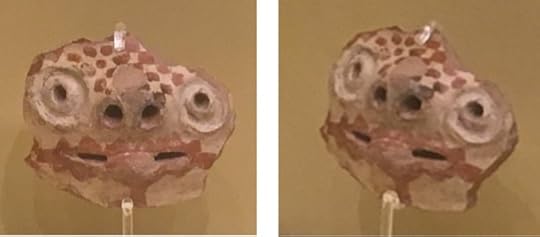 ÎεÏÎ±Î¼ÎµÎ¹ÎºÏ ÎµÏÏ
θÏÏ ÎµÏί λεÏ
ÎºÎ¿Ï Î²Î¬Î¸Î¿Ï
Ï Î±ÏÏ Ïο ÎÎµÎ¿Î»Î¹Î¸Î¹ÎºÏ Î£ÎÏκλο (6000â5800 Ï.Χ.)[2]
ÎεÏÎ±Î¼ÎµÎ¹ÎºÏ ÎµÏÏ
θÏÏ ÎµÏί λεÏ
ÎºÎ¿Ï Î²Î¬Î¸Î¿Ï
Ï Î±ÏÏ Ïο ÎÎµÎ¿Î»Î¹Î¸Î¹ÎºÏ Î£ÎÏκλο (6000â5800 Ï.Χ.)[2]
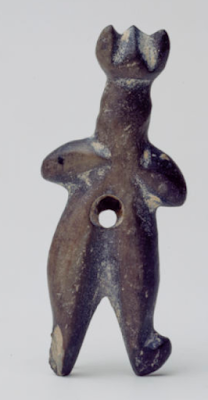 Îίθινο ÏεÏίαÏÏο αÏÏ Ïο ΣεÏκλο ÏÎ·Ï ÎÎ (5300-4500 Ï.Χ. (μοÏÏή με ÏÏοÏÏÏείο ζÏοÏ
ή ÏÏθιο ζÏο, ÎÎÎ Î 5980)
Îίθινο ÏεÏίαÏÏο αÏÏ Ïο ΣεÏκλο ÏÎ·Ï ÎÎ (5300-4500 Ï.Χ. (μοÏÏή με ÏÏοÏÏÏείο ζÏοÏ
ή ÏÏθιο ζÏο, ÎÎÎ Î 5980)Τα ÏαλαιÏÏεÏα ÏαÏακÏηÏιÏÏικά ÏÎ¿Ï Î³Î¿ÏÎ³Î¿Î½ÎµÎ¯Î¿Ï ÏÏοÎÏÏονÏαι ÏÏοÏανÏÏ Î±ÏÏ Ïο ÎÎÏη ÎÎµÎ¿Î»Î¹Î¸Î¹ÎºÏ Î£ÎÏκλο (κενÏÏ. Îλλάδα),[3] ÏÏ ÎºÎµÏαμεική μάÏκα με διογκÏμÎνα μάÏια, οÏθάνοιÏÏα ÏÎ¿Ï Î¸Î¿Ïνια, Ï ÏεÏμεγÎθη δÏνÏια και εÏιμήκη ÏÏοεξÎÏÎ¿Ï Ïα γλÏÏÏα. Îι ÏÏιÏμαÏικÎÏ ÏÏÏαγίδεÏ, αÏÏ Î·Î¼Î¹ÏολÏÏÎ¹Î¼Î¿Ï Ï Î»Î¯Î¸Î¿Ï Ï, ÏÎ¿Ï ÎµÏ ÏÎθηκαν ÏÏην αναÏκαÏή ÏÎ¿Ï ÏÏαγμαÏοÏοιήθηκε ÏÏο ανάκÏοÏο ÏÎ·Ï ÎνÏÏοÏ, ÏÏν ÎαλίÏν, ÏÎ¿Ï ÎÏÏÎ»Î¿Ï ÎºÎ±Î¹ ÏÎ¿Ï Î ÎµÏÏά (μÎÏÏι ÏÏÎ¹Î³Î¼Î®Ï Î±ÏÏ Ïην ÎÏήÏη) ÏÎ·Ï ÎÎ ÎÎ, καθÏÏ ÎºÎ±Î¹ Ïα κεÏαμεικά ÏιθάÏια αÏÏ Ïην Î¦Ï Î»Î±ÎºÏÏή ÏÎ·Ï Î½Î®ÏÎ¿Ï ÎÎ®Î»Î¿Ï ÏÎ·Ï ÎÎÏÎ·Ï ÎÏ ÎºÎ»Î±Î´Î¹ÎºÎ®Ï ÏεÏιÏÎ´Î¿Ï , Ïλα ÎÏÎ¿Ï Î½ ξεÏÏÏιÏÏά ÏαÏακÏηÏιÏÏικά αÏÏαÏκÏν γοÏγονείÏν. Î ÏημαÏία ÏÎ¿Ï Ï Î»Î¹ÎºÎ¿Ï Î±ÏÏ Ïην ÎÏήÏη, ÏÎ¿Ï ÎºÎ±ÏαÏÎºÎµÏ Î±ÏμÎÎ½Î¿Ï Î±ÏÏ Î·Î¼Î¹ÏολÏÏÎ¹Î¼Î¿Ï Ï Î»Î¯Î¸Î¿Ï Ï, ÏÏ Î¼Î²Î¿Î»Î¯Î¶ÎµÎ¹ Ïην κοινÏνική θÎÏη για Ïην αÏοÏÏοÏή ÏÎ¿Ï ÎºÎ±ÎºÎ¿Ï ÏνεÏμαÏοÏ. ÎÎμαÏα ÏÏονολογοÏμενα ÏÏην ÎÎÏη ÎÏοÏή ÏÎ¿Ï Î§Î±Î»ÎºÎ¿Ï Î±Î»Î»Î¬ και οι αÏÏαιολογικÎÏ Î±Î½Î±ÏοÏÎÏ ÎµÏιβεβαιÏÎ½Î¿Ï Î½ μιάν ÎÎÏο - ÎÏ ÎºÎ»Î±Î´Î¹ÎºÎ® ÏÎ¿Ï Î»Î¬ÏιÏÏον ÏÏονολÏγηÏη...
[image error] ÎοÏÏοÏοιημÎνη, ÏημÎνη Î±Î½Î¬Î³Î»Ï Ïη Ïλάκα αÏÎµÎ¹ÎºÎ¿Î½Î¯Î¶Î¿Ï Ïα Î³Ï Î¼Î½Ï Î¬Î½Î´Ïα με ÎºÏ ÏÏά ÏÏδια & Î´Î±Î¹Î¼Î¿Î½Î¹ÎºÏ ÏÏÏÏÏÏο (Ur, BM 116814)
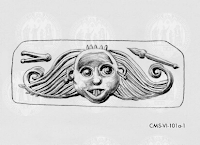
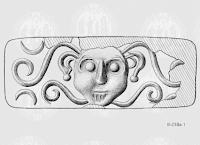
ÎεÏο-ÎινÏικά ÏÏοÏÏÏεία CMS-VI-101a & III-238a[4]
Îοινά ÏÏ Ïολογικά ÏαÏακÏηÏιÏÏικά ÏÏν ÏÏοÏÏÏοÏικÏν ÎοÏγονείÏν αÏανÏÏνÏαι εν ÏÏ Î½ÎµÏεία ÏÏην ÎÏÏαÏκή ÏεÏίοδο ÏÏÏÏ Ïα ÏαÏακÏηÏιÏÏικά ÏÎ·Ï ÎºÎµÏÎ±Î»Î®Ï ÎºÎ±Î¹ ÏÎ¿Ï ÏÏοÏÏÏÎ¿Ï (μάÏια, κÏμη, ÏÏεÏά ÏÏο κεÏάλι ÏÎ·Ï Î³Î¿ÏγÏναÏ, Ïίδια ÏÎ¿Ï Î±Î½Î±Î´ÏονÏαι αÏÏ Ïην κÏμη).
ÎÏÏ Ïον Wang και Ïην Wolf, ανÏίθεÏα, η ÎοÏÎ³Ï - ÎÎÎ´Î¿Ï Ïα θεÏÏείÏαι ÎÎ»Î»Î·Î½Î¹ÎºÏ Î´Î¬Î½ÎµÎ¹Î¿ βαÏιζÏμενο ÏÏην Humbaba ÏÎ·Ï Ur,[5] ÎµÎ½Ï Î· ειÏαγÏγή ÏÎ·Ï Î¼Î±Î¶Ï Î¼Îµ λοιÏά μειξογενή ÏλάÏμαÏα, αÏÏ Ïην ÎγγÏÏ ÎναÏολή και Ïην ÎÎ¯Î³Ï ÏÏο καÏά Ïον 8/7 αι. Ï.Χ. Ï ÏοÏÏηÏίζεÏαι αÏÏ ÏÎ¿Ï Ï Î´Î¹Î¿ÏγανÏÏÎÏ ÏÎ·Ï ÎµÎºÎ¸ÎÏεÏÏ Dangerous Beauty: Medusa in Classical Art![6] Î Hopkins ανάγει Ïο θÎμα ÏÎ¿Ï Î ÎµÏÏÎÏÏ Î±ÏοκÏÏÏονÏÎ¿Ï Ïην κεÏαλή ÏÎ·Ï ÎοÏγοÏÏ ÏÏο ÏÏεÏÎ¹ÎºÏ ÎÎ±Î²Ï Î»ÏÎ½Î¹Î±ÎºÏ - ÎÏÏÏ ÏÎ¹Î±ÎºÏ Î¸Îμα ÏÎ¿Ï Î¸ÎµÎ¿Ï Î® ήÏÏÎ¿Ï ÏÎ¿Ï ÎµÏιÏίθεÏαι Ïε γίγανÏα ή ήÏÏα, θεÏÏεί δε ÏÏι η μεÏαÏοÏά Îλαβε ÏÏÏαν ολίγον μεÏά Ïα μÎÏα ÏÎ¿Ï 7Î¿Ï Î±Î¹. Ï.Χ.,[7] Ïην άÏοÏή ÏÎ¿Ï Î´Îµ ενÏÏεÏνίζεÏαι και ο Steymans![8] ÎÏÏ Ïην άλλη ο Napier ÏημειÏνει Ïο γεγονÏÏ ÏÏι Ïο Î²Î±Î²Ï Î»ÏÎ½Î¹Î±ÎºÏ ÏÎÏÎ±Ï Humbaba αναÏαÏίÏÏαÏαι μÏνο ολÏÏÏμο και ÏÏ Ïνά ÏÏÎÏον[9] ή ημιγοναÏίζον, ÎµÎ½Ï - ÏÏÏÏ ÎºÎ±Î¹ η ÎοÏÎ³Ï - αÏεικονίζεÏαι εÏίÏÎ·Ï ÎºÎ±Î¹ με μÏνη Ïην κεÏαλή ÏηÏ.[10] Î Î¯Î´Î¹Î¿Ï ÏÏ Î³Î³ÏαÏÎÎ±Ï ÏαÏαλληλίζει Ïο ζεÏÎ³Î¿Ï ÏÎ¿Ï Î ÎµÏÏÎÏÏ - ÎοÏγοÏÏ Î¼Îµ Î±Ï ÏÏ ÏÎ¿Ï Gilgamesh - Humbaba, δεδομÎÎ½Î¿Ï ÏÏι αμÏÏÏεÏα Ïα ÏÎÏαÏα αÏοκεÏαλίζονÏαι αÏÏ Î®ÏÏα - ηγεμÏνα[10a] βοηθοÏμενο αÏÏ Ï ÏεÏÏÏ Ïική δÏναμη, ήÏοι ÏÎ·Ï ÎÎ¸Î·Î½Î¬Ï - Enkidu ανÏιÏÏοίÏÏÏ.
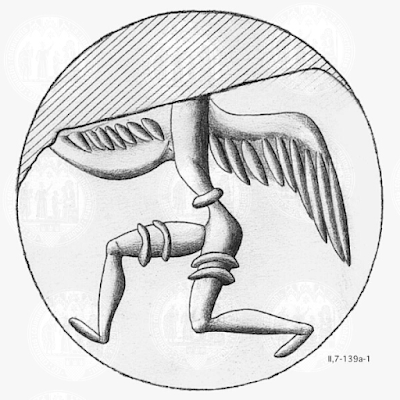 ΣÏÏαγίδα CMS II,7 139A ÏÎ·Ï Î¥Î Î[11]
ΣÏÏαγίδα CMS II,7 139A ÏÎ·Ï Î¥Î Î[11]Î ÎναÏÏαÏÎ¹Î¬Î´Î¿Ï , εÏίÏηÏ, ÎÏει ÏημειÏÏει ÏÏι οι ομοιÏÏηÏÎµÏ Î±Ï ÏÏν ÏÏν μινÏικÏν 'ÏÏοÏÏÏείÏν' και ÏÎ¿Ï ÎµÎ»Î»Î·Î½Î¹ÎºÎ¿Ï ÎοÏÎ³Î¿Î½ÎµÎ¯Î¿Ï Î´ÎµÎ½ αÏÎ®Î½Î¿Ï Î½ κανÎνα ÏεÏιθÏÏιο αμÏÎ¹Î²Î¿Î»Î¯Î±Ï ÏÏι Ïο δεÏÏεÏο βαÏίζεÏαι ÏÏα ÏÏÏÏα και εÏομÎνÏÏ Ïε μια ÏαÏάδοÏη μεÏÏÏικÏν αÏοÏÏοÏαικÏν - γκÏοÏÎÏκÏν κεÏαλÏν ÏÎ¿Ï Î±Î½Î±ÏÏÏÏθηκε ÏλήÏÏÏ ÏÏο Îιγαίο ÏÏο ÏÏÏÏο ήμιÏÏ ÏÎ·Ï Î´ÎµÏÏεÏÎ·Ï ÏιλιεÏÎ¯Î±Ï Ï.Χ.[12]
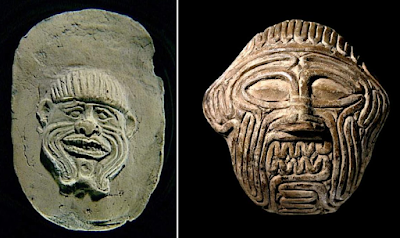 Humbaba - Huwawa [13]
Humbaba - Huwawa [13]ÎλείνονÏÎ±Ï Ïην ÏαÏοÏÏα ÏÏνÏομη αναÏοÏά ÏÏο θÎμα ÏημειÏÎ½Î¿Ï Î¼Îµ:(α) Ïο θÎμα ÏÎ·Ï Î¼ÎµÏÏÏÎ¹ÎºÎ®Ï Î±ÏοÏÏοÏαÏÎºÎ®Ï ÎºÎµÏÎ±Î»Î®Ï ÎµÎ¼ÏανίζεÏαι οικείο ÏÏο Îιγαίο αÏÏ Ïην Îεολιθική,[15](β) αÏÏ ÏÎ¹Ï Î±ÏÏÎÏ ÏÎ·Ï Î´ÎµÏ ÏÎÏÎ±Ï ÏιλιεÏÎ¯Î±Ï Ï.Χ. ανάλογα θÎμαÏα εμÏανίζονÏαι ÏÏην μικÏÎ¿Î³Î»Ï ÏÏική ÏÎ·Ï ÎινÏÎ¹ÎºÎ®Ï ÎÏήÏÎ·Ï ÎºÎ±Î¹ αλλοÏ,(γ) η ÏÏ ÏÏημαÏική αÏÏδοÏη ÏÎ¿Ï Î¸ÎμαÏÎ¿Ï ÏÏην ÎεÏοÏοÏαμία ÏÏεÏίζεÏαι με Ïην γνÏÏÏή ÏÏοκαÏάληÏη ex oriente lux αγνοεί δε ÏÏ ÏÏημαÏικά Ïα ÎµÏ ÏήμαÏα ÏÎ·Ï Î±ÏÏÎ±Î¹Î¿Î»Î¿Î³Î¯Î±Ï ÎµÎ¼Î¼ÎÎ½Î¿Ï Ïα ÏÏαθεÏά Ïε αÏÏÏÎµÎ¹Ï ÏÏίν κάν Ïην αÏοκÏÏ ÏÏογÏάÏηÏη ÏÎ·Ï ÎÏÎ±Î¼Î¼Î¹ÎºÎ®Ï Î'. Î ÏÏοκαÏάληÏη Î±Ï Ïή Ï Î¹Î¿Î¸ÎµÏεί Ïην άÏοÏη ÏÏι η ÎεÏοÏοÏαμιακή ειÏαγÏγή Îλαβε ÏÏÏαν ολίγον ÏÏιν Ïην καÏαγÏαÏή ÏÏν ÎμηÏικÏν εÏÏν, αγνοοÏÏα ÏÏι Ïα ÎÏη ÏÏÎ¿Ï ÏήÏξαν και μεÏεδίδονÏο με Ïην ÏÏοÏοÏική ÏαÏάδοÏη.
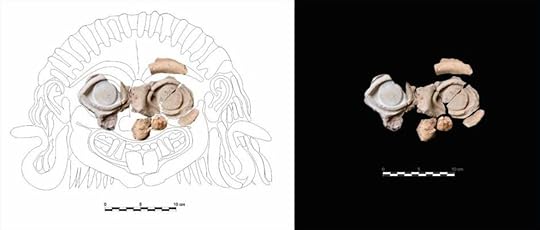 ÎÏαÏÏμαÏα αÏÏ Ïο ÏÏήλαιο Gorham και αναÏÏνθεÏη ÏοÏ
ÎοÏγονείοÏ
[16]
ÎÏαÏÏμαÏα αÏÏ Ïο ÏÏήλαιο Gorham και αναÏÏνθεÏη ÏοÏ
ÎοÏγονείοÏ
[16]ΣÎÎÎÎΩΣÎÎΣ
[1]. Lazarou 2019, p. 382. Î ÎμηÏοÏ, Il.11.35f., ÏεÏιγÏάÏει ÏÏÏ ÎµÎ¾Î¿ÏλίζεÏαι ο ÎγαμÎμνÏν για Ïην μάÏη, με Ïην αÏÏίδα ÏÎ¿Ï Î½Î± ÏÎÏει Îνα γοÏγÏνειο ÏÏ ÎºÎµÎ½ÏÏική εικÏνα:Ïῠδ᾽ á¼Ïὶ μὲν ÎοÏγὼ βλοÏÏ ÏῶÏÎ¹Ï á¼ÏÏεÏάνÏÏο /δεινὸν δεÏκομÎνη, ÏεÏὶ δὲ Îεá¿Î¼ÏÏ Ïε ΦÏÎ²Î¿Ï Ïε ΣημειÏÏÏε ÏÏι Ïο Îνα ÏÏοιÏείο Î±Ï ÏÎ®Ï ÏÎ·Ï ÎµÎ¹ÎºÏÎ½Î±Ï ÎµÎ¯Î½Î±Î¹ και ÏÏÎ¹Ï Î´Ïο ÏεÏιÏÏÏÏÎµÎ¹Ï Î¿ δειμÏÏ (ÏÏÏμοÏ), εÏίÏÎ·Ï Î¿ ÏÏβοÏ, γιαÏί είναι ÏÏομεÏÏ Î½Î± Ïην κοιÏÎ¬Ï (ÏμεÏδνή, αÏÏ Ïο ÏμεÏδαλÎοÏ). Îγγλική μεÏάÏÏαÏη βαÏιÏμÎνη ÏÏο LSJ (Wolf 2019, p. 76, n. 261).[2]. Lazarou 2019, p. 358, fig. 1.[3]. Anastasiadou 2018, p. 170.
[4]. Anastasiadou 2018, fig. 2.
[5]. Zhiyuan Wang 2021; Wolf 2019, p. 78, n. 273. [6]. Karoglou 2018, p. 4.[7]. Hopkins 1934, p. 356.[8] Steymans 2020, p. 104, n. 34.
[9]. Îιά Ïο θÎμα ÏÎ·Ï ÏÏÎÏÎ¿Ï ÏÎ±Ï Î¼Î¿ÏÏÎ®Ï ÏÏην μικÏÎ¿Î³Î»Ï ÏÏική ÏÎ¿Ï ÎάκÏÎ¿Ï Î²Î». Lazarou (Lazarou 2019, p. 376-378).[10]. Napier 1987, p. 109.[10a]. ΠάνÏÏÏ Ïο εÏÎ¹ÎºÏ Î¼Ï Î¸Î¿Î»Î¿Î³Î¹ÎºÏ Î¸Îμα ÏÎ·Ï Î´Î¹Î±ÏÎ¬Î»Î·Ï Î®ÏÏÎ¿Ï Î¼Îµ ÏÎÏαÏ, ÏÏ Î½Î®Î¸ÏÏ ÎµÏÏεÏοειδοÏÏ Î¼Î¿ÏÏήÏ, είναι ιδιαίÏεÏα διαδεδομÎνο ÏÏÏον ÏÏον Îνδο-ÎÏ ÏÏÏαÏÎºÏ ÏÏÏο, ÏÏον και εκÏÏÏ Î±Ï ÏÎ¿Ï (Watkins 1995, p. 298), ακÏμη και Ïε ÎÏμενικοÏÏ ÎºÎ±Î¹ ÎÎ¹Î¸Î¿Ï Î±Î½Î¹ÎºÎ¿ÏÏ Î¼ÏÎ¸Î¿Ï Ï (West 2007, p. 430, n. 65). Îιά Ïο εÏÏεÏοειδÎÏ ÏÏοιÏείο ÏÎ·Ï ÎοÏγοÏÏ Î²Î». Pind.P.10.46-8.a usually reptilian monster[11]. arachne.dainst.org.
[12]. Anastasiadou 2018, p. 168.[13]. ÎÏιÏÏεÏά: Louvre AO 12460, Isin-Larsa (;) (1ο ήμιÏÏ Î´ÎµÏ ÏÎÏÎ±Ï ÏιλιεÏίαÏ) ή 1η Î´Ï Î½Î±ÏÏεία ÏÎ·Ï ÎÎ±Î²Ï Î»ÏÎ½Î±Ï (;) (-2004 - -1763 και -1894 - -1595). Îεξιά: ÎÎ 116624, ÏÏονολογοÏμενη Ïην ÏεÏίοδο 1800-1600 Ï.Χ. ή Ïην ÏÏÏÏη ÏιλιεÏία Ï.Χ. ÏÏμÏÏνα με Ïην S. B. Graff.[15]. Î Dexter ÏημειÏνει: ÎξεÏÎ¬Î¶Ï Ïην ελληνοÏÏμαÏκή ÎοÏγÏνα, Ïην ÎÎÎ´Î¿Ï Ïα, διαÏολιÏιÏμικά, μÎÏÏ ÏÏν ÏεÏιÏÏÏÏεÏÏν ÏημανÏικÏν ελληνικÏν και ÏÏμαÏκÏν κειμÎνÏν και εικονογÏαÏίαÏ, ÏÏοκειμÎÎ½Î¿Ï Î½Î± εξεÏάÏÏ Ïην καÏαγÏγή ÏÎ·Ï ÎºÎ±Î¸ÏÏ ÎºÎ±Î¹ ÏÎ¹Ï ÏολÏÏÎ»ÎµÏ ÏÎµÏ Î»ÎµÎ¹ÏÎ¿Ï ÏÎ³Î¯ÎµÏ ÏηÏ. Îα Î´ÎµÎ¯Î¾Ï ÏÏι η ÎÎÎ´Î¿Ï Ïα είναι μια ÏÏ Î»Î»Î¿Î³Î® ÏÎ·Ï Î½ÎµÎ¿Î»Î¹Î¸Î¹ÎºÎ®Ï ÎµÏ ÏÏÏαÏκήÏ, ÏημιÏÎ¹ÎºÎ®Ï ÎºÎ±Î¹ Î¹Î½Î´Î¿ÎµÏ ÏÏÏαÏÎºÎ®Ï Î¼Ï Î¸Î¿Î»Î¿Î³Î¯Î±Ï ÎºÎ±Î¹ εικονογÏαÏίαÏ. ÎικονογÏαÏικά, δÏο ÏÎ¿Î»Ï Î´Î¹Î±ÏοÏεÏικÎÏ Î±ÏεικονίÏÎµÎ¹Ï ÏÏ Î½ÎµÎ½ÏνονÏαι ÏÏη ÎÎÎ´Î¿Ï Ïα ÏÎ·Ï ÎλαÏÎ¹ÎºÎ®Ï ÎÏοÏήÏ: η Îεολιθική Îεά ÏÎ·Ï Î³ÎννηÏηÏ, ÏÎ¿Ï Î¸Î±Î½Î¬ÏÎ¿Ï ÎºÎ±Î¹ ÏÎ·Ï Î±Î½Î±Î³ÎννηÏηÏ, η οÏοία αναÏαÏίÏÏαÏαι ÏÏ ÏÎ¿Ï Î»Î¯, Ïίδι ή Ï Î²Ïίδιο ÏÎ¿Ï Î»Î¯-ÏιδιοÏ. και Ïον δαίμονα ÏÎ·Ï ÎγγÏÏ ÎναÏÎ¿Î»Î®Ï Humbaba ÏÎ¿Ï Î¿ÏÎ¿Î¯Î¿Ï Ïο κομμÎνο κεÏάλι ÏÏηÏιμοÏοιείÏαι, ÏÏÏÏ ÎºÎ±Î¹ ÏÎ·Ï ÎÎÎ´Î¿Ï ÏαÏ, με αÏοÏÏοÏαÏÎºÏ ÏÏÏÏο. Î ÎÎÎ´Î¿Ï Ïα είναι άγÏια, αλλά Ïο μιÏÏ Î±Î¯Î¼Î± ÏÎ·Ï ÎµÎ¯Î½Î±Î¹ θεÏαÏÎµÏ ÏÎ¹ÎºÏ ÏαÏά καÏαÏÏÏοÏικÏ. ÎÏειδή ÏÏ Ïνά θεÏÏείÏαι ÏÏομακÏική ÏÏÎ¿Ï Ï Î¹Î½Î´Î¿ÎµÏ ÏÏÏαÏκοÏÏ ÏολιÏιÏμοÏÏ, Î±Ï Ïή η άλλη ÏÎ»ÎµÏ Ïά ÏÎ·Ï ÏÏ Ïνά ÏαÏαβλÎÏεÏαι ( Dexter 2010; 2018).[16]. Finlayson et al. 2021, fig. 2.
ÎÎÎÎÎÎÎΡÎΦÎÎ
https://www.academia.edu/42320486/Pre...
Lazarou, Î. 2019. "Prehistoric Gorgoneia: a Critical Reassessment," Studia Antiqua et Archaeologica 25(2), pp. 353â385.
https://issuu.com/haleyclassicaljourn... Wang. 2021. "From Humbaba to Gorgons: The Artistic Connection between Ancient Near East and Ancient Greece," The Haley Classical Journal II (I), pp. 11-15.
http://melammu-project.eu/database/ge... Project. The Heritage of Mesopotamia and the Ancient Near East
https://www.academia.edu/39228396/THE... Dexter, M. 2018. "The Greco-Roman Medusa and her Neolithic Roots," in Materiality and Identity in Pre-and Protohistoric Europe Homage to Cornelia-Magda Lazarovici, pp. 463-482.
https://books.google.gr/books?id=wZ1l..., A. D. 1987. Masks, Transformation, and Paradox, Univ. of California Press.
https://www.academia.edu/37322467/201..., M. 2018. "The Origin of the Different: 'Gorgos' and 'Minotaurs' of the Aegean Bronze Age," in Making Monsters, ed. E. Bridges and D. al-Ayad, pp. 165-175.
https://www.zora.uzh.ch/id/eprint/138..., H. U., ed. 2020. Gilgamesh: Epic and Iconography (Orbis Biblicus et Orientalis 245), Vandenhoeck & Ruprecht.
https://www.researchgate.net/publicat..., S. B. 2013. "The Head of Humbaba," Archiv für Religionsgeschichte 14(1), pp. 129-142.
http://eprints.nottingham.ac.uk/11787..., E. 2007. "The Fantastic Creatures of Bronze Age Crete" (diss. Univ. of Nottingham).
https://resources.metmuseum.org/resou..., K. 2018. Dangerous Beauty: Medusa in Classical Art (The Metropolitan Museum of Art Bulletin 7: 3), MMA.
https://books.ub.uni-heidelberg.de/pr..., D. 2019. Monsters and the Mind. Composite Creatures and Social Cognition in Aegean Bronze Age Glyptic (Daidalos â Heidelberger Abschlussarbeiten zur Klassischen Archäologie), Propylaeum.
https://www.jstor.org/stable/498901Ho..., C. 1934. "Assyrian Elements in the Perseus-Gorgon Story," AJA 38 (3), pp. 341-358.
Watkins, C. 1995. How to Kill a Dragon: Aspects of Indo-European Poetics, Oxford.
West, M. L. 2007. Indo-European Poetry and Myth, Oxford.
https://www.academia.edu/39228396/THE... Dexter, M. 2018. "The Greco-Roman Medusa and her Neolithic Roots," in Materiality and Identity in Pre-and Protohistoric Europe Homage to Cornelia-Magda Lazarovici, pp. 463-482.
https://www.jstor.org/stable/10.2979/... Dexter, M. 2010. "The Ferocious and the Erotic: âBeautifulâ Medusa and the Neolithic Bird and Snake," Journal of Feminist Studies in Religion 26 (1), pp. 25-41
https://www.ncbi.nlm.nih.gov/pmc/arti..., C. et al. 2021. "Where myth and archaeology meet: Discovering the Gorgon Medusaâs Lair," online 2021 Apr 1. doi: 10.1371/journal.pone.0249606
ΠΡÎΣΦÎΤΠÎÎÎÎÎΡΩΣΠÎÎÎ ÎÎΥΤÎΣÎÎΣ: 270322



